

Lost City Trek

Punta Gallinas Tour

Tayrona Park Tours

Sierra Nevada Santa Marta Tours

Smiles in all destination

MICE Tourism
Why choose us, customized products, we act sustainably, committed and highly qualified staff, we support the communities, certified quality, constant innovation, search tours, most popular tours.
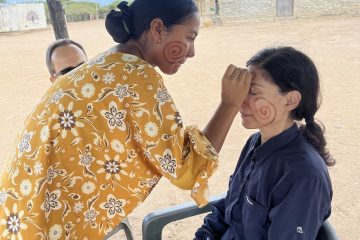
Cultural and Ecological Guajira
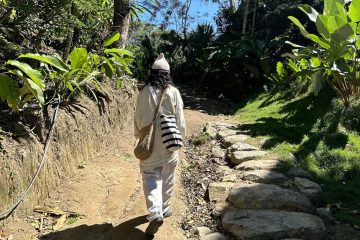
Pueblito Taiku

Lost City Trek 3 days

Lost City Colombia 4 days
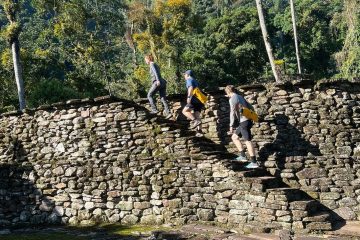
Lost City Colombia Trek 5 days
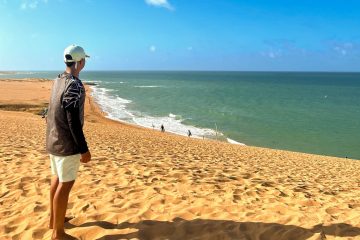
Tour Punta Gallinas 3 days
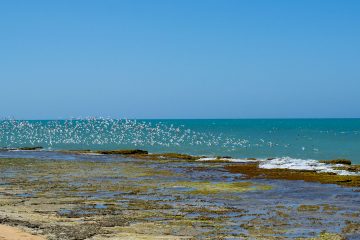
Punta Gallinas 4 days - Guajira
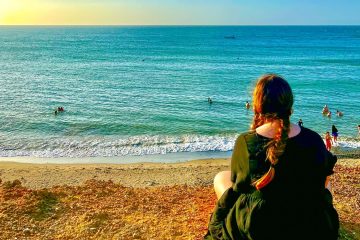
Tour Cabo de la Vela 2 days
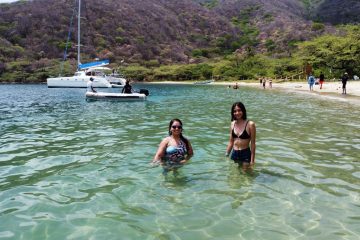
Tour Bahía Concha - Parque Tayrona
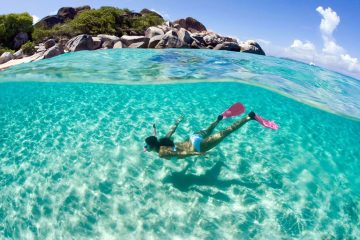
Playa Cristal - Parque Tayrona
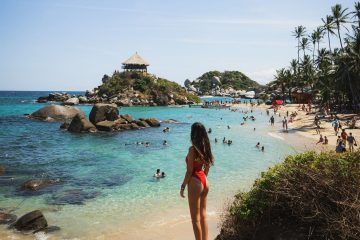
Cabo San Juan - Parque Tayrona
Destination.
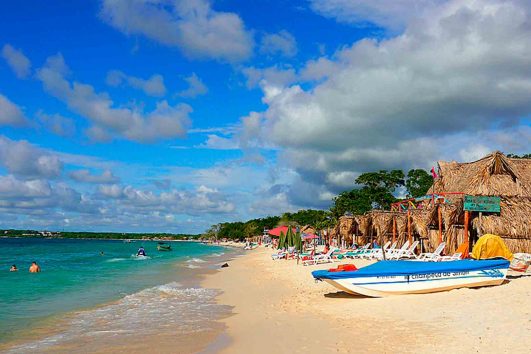
Latest Post
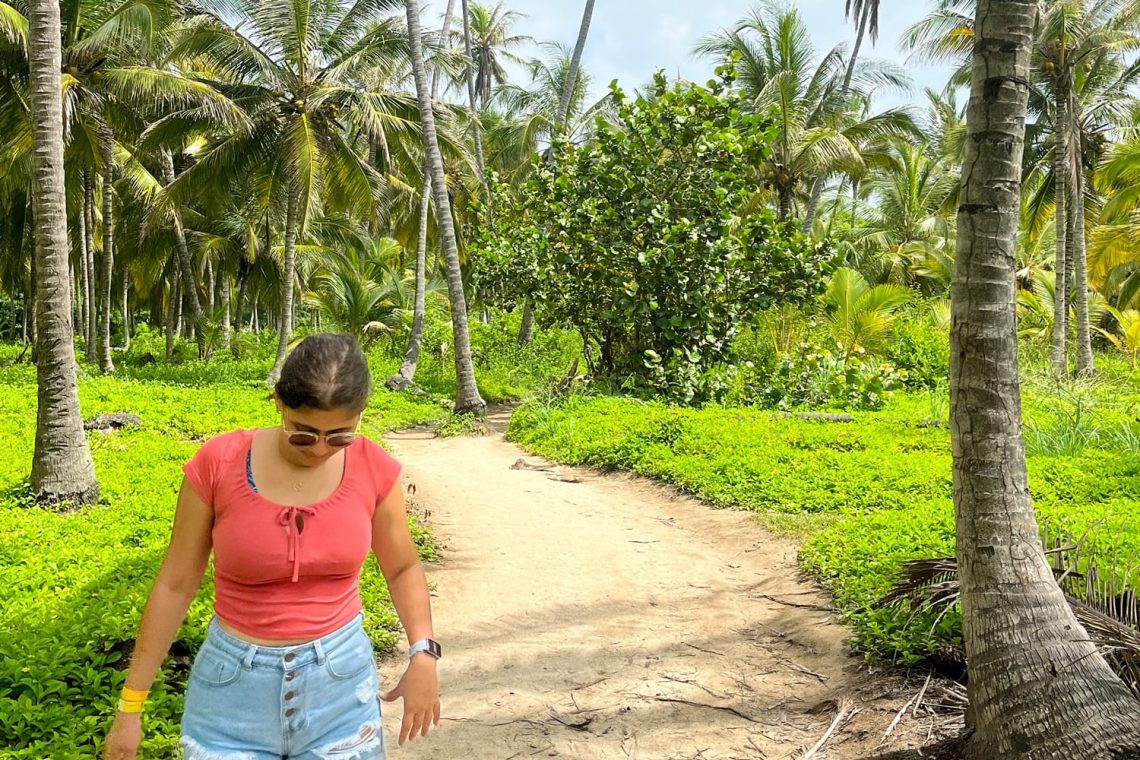
What to do in Santa Marta?
Tour reviews.
This was a very difficult trekk but an amazing experience. Especially the hike on the second day was very hard. But in the end it was all worth it. The Lost City is absolutely beautiful and astonishing. I recommend doing the hike with José from Venezuela and José from El Mamey. They invested a lot of effort to make sure everybody is happy and provided us with very detailed information about the Lost City and the indigenous tribes living in the Sierra Nevada. If you’re physically fit, I definitely recommend coming here!
Coolest thing I’ve done in Colombia! Walter was our experienced tour guide who was one of the first ones to discover the city ánd was part of the group that did the restoration of the Lost City. He knew everything about the mountains and tribes that live there (he knows them personally). Miguel (Tyson) was our young and energetic translator that absolutely loved his job. He makes everyone enthusiastic and you can just see that Walter and he have a special bond.
They both went above and beyond to make you feel welcome and at ease to finish the four day hike. Every evening after dinner they told us a story about the nature, tribes, mountains and the spirituality the Lost City beholds.
There were snacks at almost every stop (fruits) and dinner was great.
10/10 would recommend. And definitely ask for Walter and Miguel (Tyson)!!
Supported by

Lost City Teyuna
Teyuna is Past. We are Family and Community: Explore the Origin !
Teyuna is Present. Passion for Service: Explore the Origin !
Teyuna is Future. Be part of the Change: Explore the Origin !
We are Teyuna
People travelled with Teyuna Tours!
Families benefit from Teyuna Tours!
TripAdvisor – Lost City Trek reviews

Explore the Origin
Lost city trek.
Best option for visitors who prefer to have an exclusive experience, and have an excellent physical condition.
Why are we different?
We are Teyuna Tours, the only Lost City trek operator to be directly owned by local guides with more than 15 years of experience, we have traveled and lived the magic of archaeological and sacred places in Sierra Nevada de Santa Marta mountain range for a long time, developing a broad knowledge and reliability in Lost City treks operation.
We are a group of local Lost City trek guides who have been training to be professionals, in order to provide authentic ethno-tourism and eco-tourism experiences to our visitors; we are strongly driven by the desire to create and promote a culture of conservation and care for environment, habits and traditions of our communities.
With this strong will, we could make our dream a solid reality when getting together and creating Teyuna Tours, get to know more about our project:
Santa Marta Tour Guides created their own tour operator company: Teyuna Tours
The Lost City is providing a solid nature tourism alternative
Teyuna, Buritaca-200 or Ciudad Perdida (the Lost City) is one of the more than 250 ancient villages...
. .. belonging to the four indigenous groups’ ancestral heritage and found in the northern and southwestern face of Sierra Nevada de Santa Marta mountains, Magdalena department, northern Colombia.
Teyuna or Ciudad Perdida was discovered in 1976 by a team of archaeologists from the Colombian Institute of Anthropology headed by Gilberto Cadavid and Luisa Fernada Herrera; it was almost entirely restored between 1976 and 1982.
Members of the local indigenous tribes, descendants of the Tairona culture – the Arhuaco, the Koguis, the Wiwas and the Kankuamos – have stated that they visited the site on a regular basis before its rediscovery was made public and way before Lost City treks started, but that they had kept a secret about it.
They call Ciudad Perdida “Teyuna” and believe it was the most important spiritual center at the time, heart of a network of villages inhabited by their ancestors, the Taironas. Ciudad Perdida, which can be visited nowadays thanks to Lost City treks, was probably the political and manufacturing center of the region, being located in the valley of Buritaca river and probably inhabited by 2,000 to 8,000 people. It was apparently abandoned during the Spanish conquest. The Lost City
The site that can be reached only by taking the so-called Ciudad Perdida trek, extends between 900 and 1,300 meters above sea level, on the foothills of Cerro Corea, in the northern face of Sierra Nevada de Santa Marta mountain range, on the right side of Buritaca river.
The main attraction of the Lost City trek, Ciudad Perdida, is known as Teyuna by the indigenous people of the area and therefore the name of the archaeological site: Ciudad Perdida-Teyuna Archaeological Park, even though within the nomenclature of archaeological sites located in Sierra Nevada de Santa Marta mountains, it is also known as Buritaca-200.
The area within Ciudad Perdida-Teyuna Archaeological Park includes a complex system of constructions, flagstone trails (trails paved with flat-cut stones), stairs and containing walls, path connecting a series of circular terraces and platforms on which the ceremonial centers, houses and food storages (silos) were built.
The structures that were discovered so far occupy an area of approximately 35 hectares, in which up to 169 stone terraces and more 240 stone rings can be found. Since its discovery, Ciudad Perdida and Ciudad Perdida treks have been managed and regulated by the Colombian Institute of Anthropology and History (ICANH), which is the public entity in charge of Ciudad Perdida-Teyuna Archaeological Park.
Being an archaeological park conserved by a national authority, located inside of the National Natural Park of Sierra Nevada de Santa Marta -which overlaps with a native reservation inhabited by local indigenous groups too-, in order to reach the Lost City through a Lost City trek it is necessary to make a series of contributions to both communities living in the region in which the trek takes place: farming and indigenous communities, in fact, are in charge of performing maintenance on the trails, and to keep peace and harmony on the way to this ancestral site.
How long does it take to get to Ciudad Perdida?
Ciudad Perdida-Teyuna Archaeological Park can only be visited through several days of walking in the heart of the amazing tropical forest of Sierra Nevada, in a guided tour that takes between 3 and 6 days – the so-called Lost City or Ciudad Perdida trek – operated by TEYUNA TOURS, travel agency based in Santa Marta, Colombia.
How long is the hike to the Lost City?
The hike to the Lost City is 4 to 6 days long; it’s a walk of more than 50 km in Sierra Nevada de Santa Marta mountains, involving river crossings, uphills, downhills, outstanding views, native communities and archaeological ruins.
How much is the Lost City Trek Colombia?
The 4 and 5-day Lost City Trek costs$1.750.000 COP and $2.050.000 per person in 2023; these prices includes transportation, guide service, lodging, food, entrance fees, contribution to local communities, travel insurance.
How difficult is the Lost City Trek?
This trekking involves long walks (more than 50 km in total) and takes place in a tropical forest, with high temperatures (up to about 32°C). It is usually hot and very humid, even if during the night temperatures may get as low as 17-18°C. There are a lot of mosquitoes, bugs and other insects, so that we recommend to bring insect repellent; chances of rain are usually pretty high, especially during the afternoon, so the trail can be muddy, and it is necessary to cross rivers and streams.
More information
Teyuna or Ciudad Perdida, also known as the Lost City trek in Colombia, was discovered in 1976 by archaeologists from the Colombian Institute of Anthropology. It was almost entirely restored between 1976 and 1982. The site, which is considered the most important spiritual center of the indigenous tribes in the area, can be visited nowadays through the Lost City trek.
The Lost City trek, also known as the Ciudad Perdida trek, is a guided tour operated by TEYUNA TOURS, a travel agency based in Santa Marta, Colombia. The trek takes between 3 and 6 days to complete and involves walking through the tropical forest of Sierra Nevada de Santa Marta, crossing rivers, navigating uphills and downhills, and exploring archaeological ruins.
The Lost City trek is managed and regulated by the Colombian Institute of Anthropology and History (ICANH), as it is located within the Ciudad Perdida-Teyuna Archaeological Park, a national natural park that overlaps with a native reservation inhabited by local indigenous groups. To reach Ciudad Perdida, visitors are required to make contributions to both the farming and indigenous communities in the region as part of the trek.
The Lost City trek costs $1.750.000 COP for the 4-day trek and $2.050.000 COP for the 5-day trek per person in 2023. The cost includes transportation, guide service, lodging, food, entrance fees, contribution to local communities, and travel insurance.
The Lost City trek is a challenging adventure, involving long walks in a tropical forest with high temperatures, humidity, and mosquitoes. However, the trek offers outstanding views, unique cultural experiences with local indigenous communities, and a chance to explore the ancient ruins of Ciudad Perdida.
In conclusion, if you are looking for an off-the-beaten-path adventure in Colombia, the Lost City trek, also known as Ciudad Perdida trek, is a must-visit destination. Managed by the Colombian Institute of Anthropology and History, this guided tour offers a unique opportunity to explore the ancient ruins of Teyuna, also known as the Lost City, while supporting local communities and experiencing the natural beauty of Sierra Nevada de Santa Marta. Book your trek with TEYUNA TOURS and embark on an unforgettable journey into the heart of the Colombian jungle.
Disclaimer - Teyuna Tours S.A.S.
The company is exempt from any kind of responsibility coming from the pre-existing conditions of the visitors, including medical or physical conditions, or even of a different nature, such as pregnancy and others that may affect the health of the visitor him/herself.
If you have questions regarding our services, level of difficulty of the walks, the Lost City treks or other details, feel free to contact us and we will be really glad to advise you.

The Lost City Trek in Colombia: 27 Things I Wish I Knew
Discovering remains of ancient civilizations. Hiking through lush jungle. Swimming in cascading waterfalls.
If this sounds like the adventure you’re after, then the Lost City trek in Colombia should be on your bucket list.
But it’s certainly not a walk in the park!
The multi-day trek to the Lost City (or La Ciudad Perdida) is a tough hike that involves lots of walking in brutal heat.
Is it worth the expensive price tag? Is it too crowded? And is it as difficult as people say it is?
I answer all those questions (and more) in this guide to 27 things I wish I knew about the Lost City trek, Colombia.
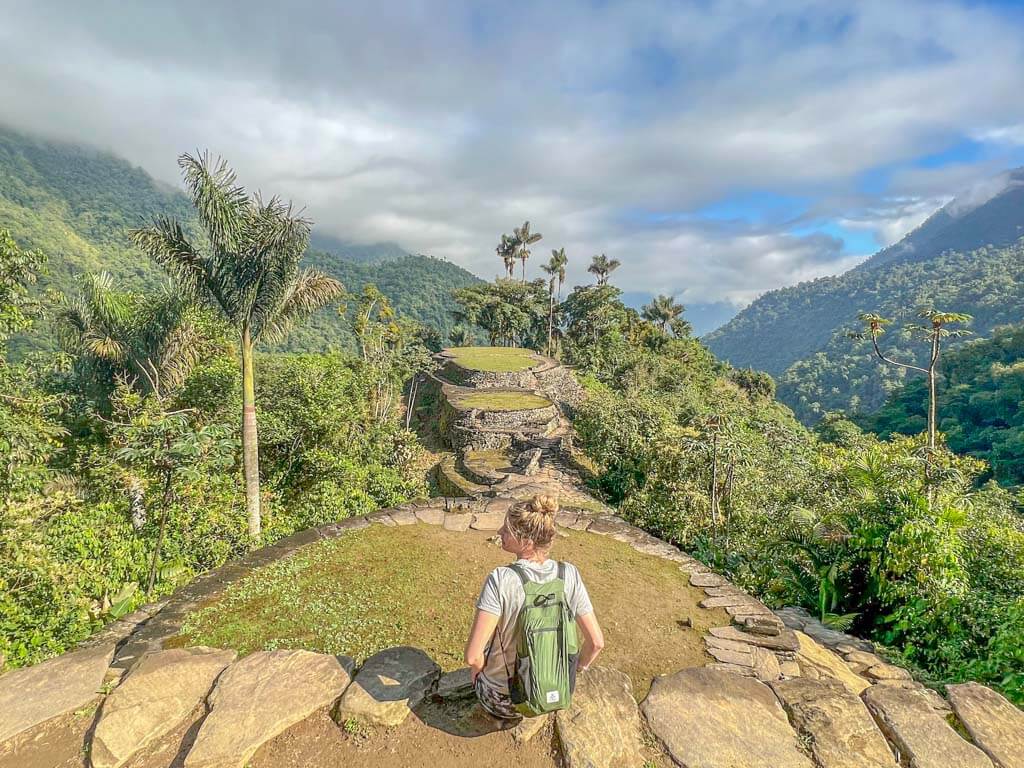
Quick Navigation
Lost City Trek Overview
- Time needed: 4 or 5-day tour
- Costs: 2.150.000 COP (2024 fixed price 4-day tour)
- Distance: 46 – 60 km
- Difficulty: Medium to difficult
- Type: Out and back route meaning you’ll follow the same route back (unless you’re doing the 5-day tour)
Is the Lost City Trek Worth it?
Yes, the trek to the Lost City is 100% worth it. Not only is it an incredibly scenic hike but the site itself is filled with so much wonder and mystery.
It was built by the Teyuna People around 800 AD (that’s 650 years before Machu Picchu was built), and was only recently discovered.
I had no intention of doing the Lost City trek in Colombia – but after it was recommended to me by numerous travelers, I decided to give it a go.
And I am so happy I did.
But it is expensive, and you need at least 4 days to complete the tour.
So, if time and budget aren’t on your side, you might need to rethink whether you include Ciudad Perdida in your itinerary or not.
This post will hopefully make that decision easier for you.
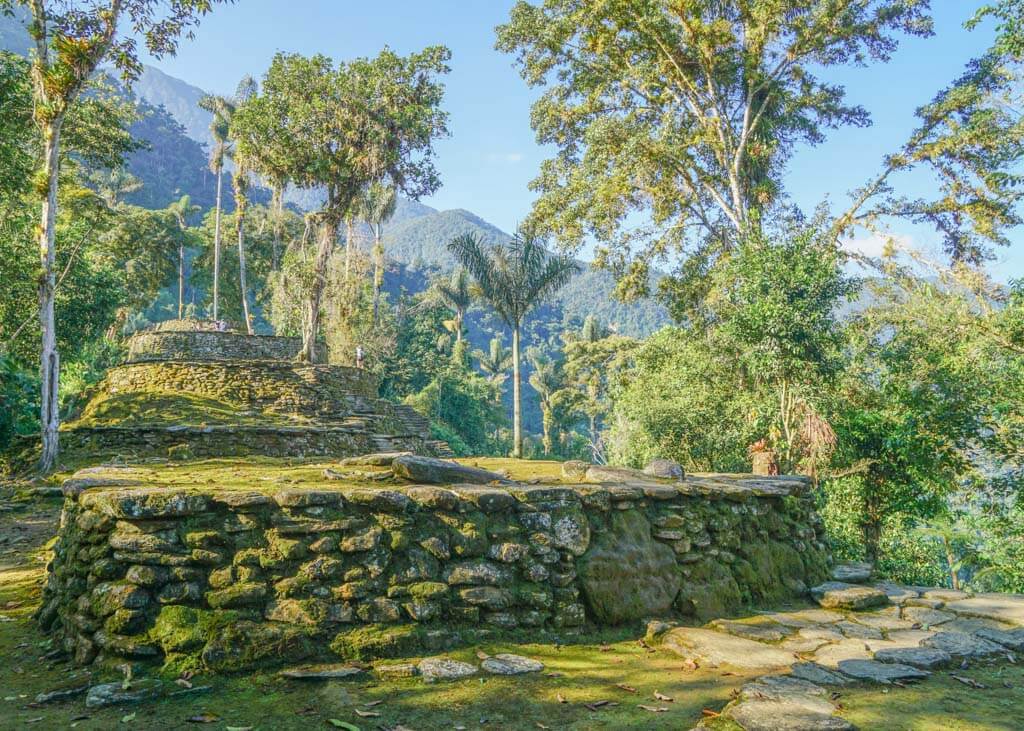
It’s not a hidden gem like it used to be
A few years ago, the Lost City was regarded as an off-the-beaten-track destination in Colombia.
Nestled deep in the Sierra Nevada mountains, few people made the trek to Ciudad Perdida. And those who did were met with isolated communities, remote landscapes, and very few creature comforts.
That has since changed!
The Lost City trek is no longer a hidden gem and the trails are busy, especially during December and January. It’s a backpacker haven where you’re guaranteed to meet like-minded travelers.
The camps are crowded, and you may be stuck behind a large tour group during certain sections of the hike, especially on the last day.
But the crowds don’t ruin the experience
Despite the crowds, hiking to Ciudad Perdida was one of my highlights of Colombia.
Nothing beats walking through the Lost City, which is a lot bigger than I had ever thought, and imagining what life was like for the people who once lived there.
But it’s not only reaching Ciudad Perdida that makes it a worthwhile adventure.
The trail is surrounded by dense forests with swimming holes next to each camp.
Cooling off in the rivers, sipping on ice-cold beers after a grueling 6-hour hike, and meeting people from all over the world – it was the entire journey to and from the Lost City that made it special for me.
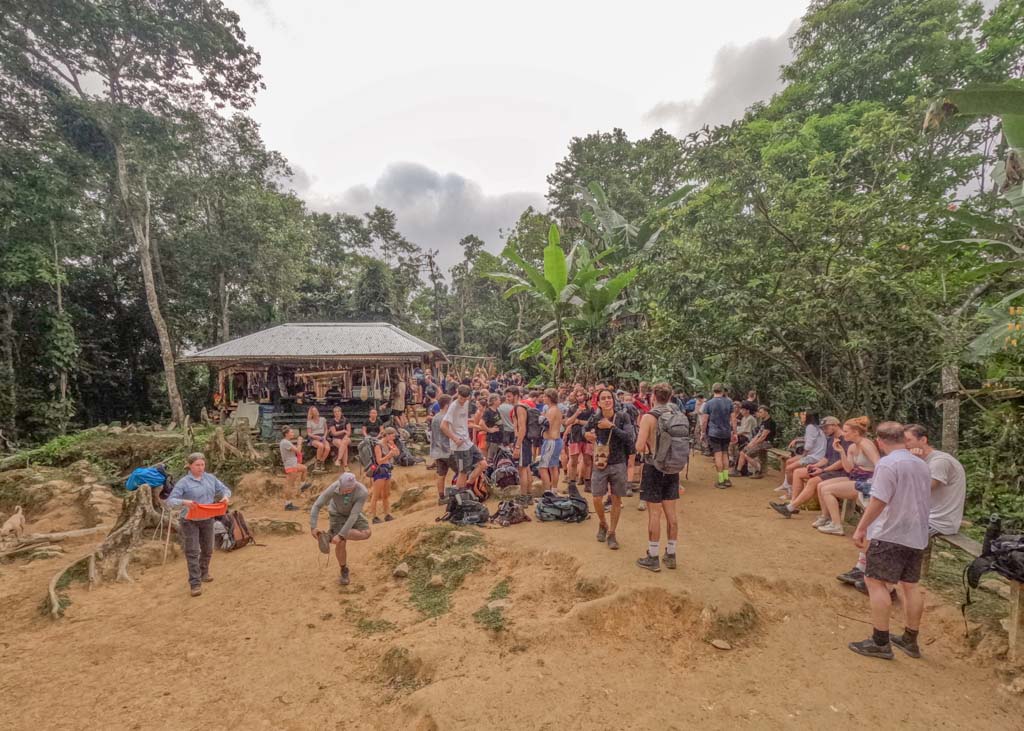
Lost City Trek Difficulty: It’s not easy
The Lost City trek involves a lot of walking on uneven, muddy terrain, often uphill. And in high humidity.
But overall, it’s not a technical hike nor overly challenging. It’s the temperature and jungle setting that get to most people.
You’ll walk at least 6 hours a day and there are a lot of steep sections. When you reach the top of a hill, you’ll be huffing and puffing, and drenched in sweat.
The final stretch to the Lost City involves hiking up 1200 stairs. They are steep, slippery, and very narrow so you need to watch your footing.
I found this day (day 3) to be the most challenging.
Because it’s a long day as you’ll not only trek to the Lost City, but you’ll re-trace your steps to the halfway point where you’ll spend the night.
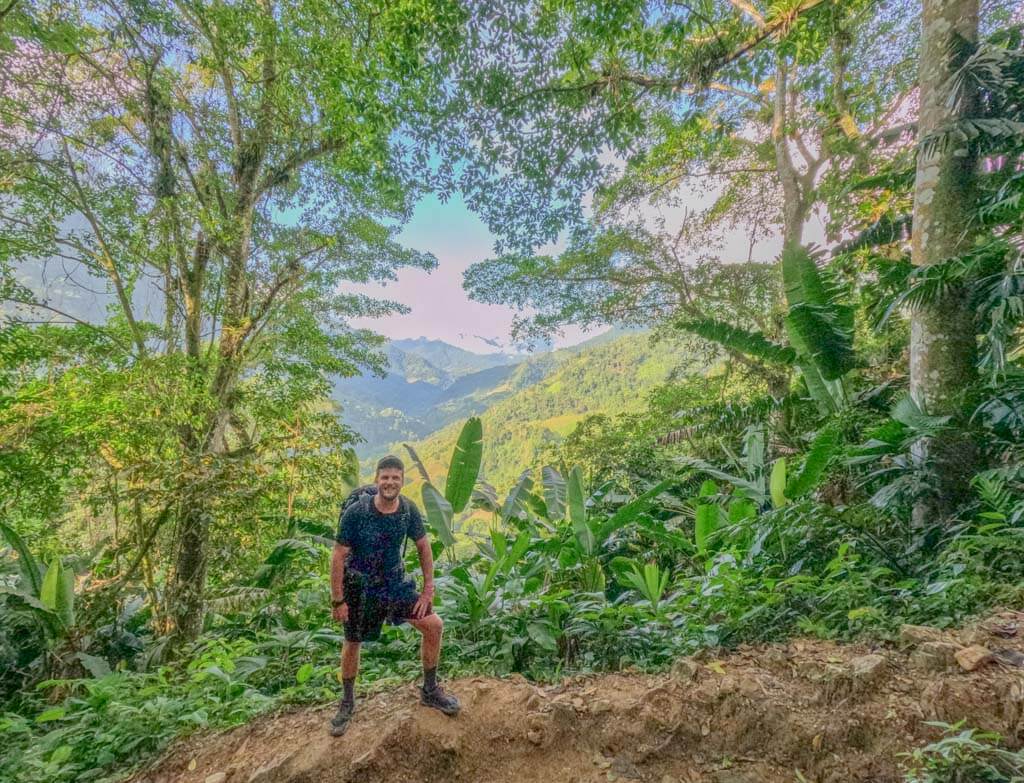
You need 4 or 5 days for the Ciudad Perdida trek
The most popular Lost City trek tour is 4 days. This is the perfect amount of time for most people.
And trust me, you don’t want to do any shorter!
There is also the option to do a 5-day tour. For this, your first 3 days will follow the same route as the 4-day tour. And you will still reach the Lost City on day 3.
But it differs from the standard trek as you won’t rush to get back to the trailhead on day 4.
Instead, you will take a detour along a quieter route and have an extra day to get back to the start.
Some people prefer this alternative exit route that’s taken on days 4 and 5 because it’s not very busy and you’re likely to have a large part of the trail to yourself.
I did the 4-day tour and was very happy with my decision.
The Lost City Trek is expensive
The 4-day Lost City trek costs 2.150.000 COP per person in 2024. That’s an increase from 1.750.000 COP per person in 2023 – nearly $100 USD more.
Yes, you read that correctly! It’s one of the most expensive activities to do in all of South America.
All tour costs are fixed no matter which operator you go with – so you won’t be able to negotiate a better price.
And no, you’re not getting anything luxurious in return.
The accommodation and food are very basic, and the hefty price tag is due to money that goes back to the communities that call the Sierra Nevada mountains home.
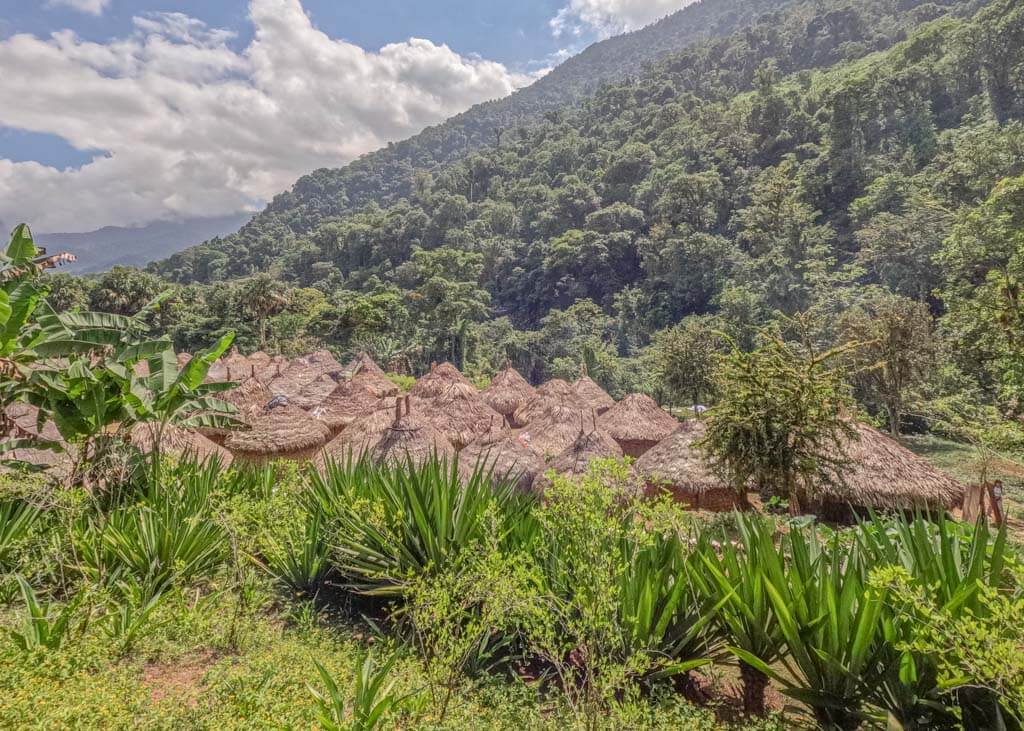
You can’t do it independently
The only way to trek to the Lost City of Ciudad Perdida is by booking a tour. It’s a requirement and you need to use a certified company that follows strict rules and regulations.
I booked my Lost City tour the day I arrived in Santa Marta and had no problems finding an operator with availability.
However, if you do not have flexibility in your schedule or if you have preference for a particular tour operator, I recommend contacting a few companies a week before your planned departure date.
November to April is the best time for the Ciudad Perdida hike
The dry season for the northern part of Colombia is from November to April. It’s best to plan your trip during this time.
You’ll have long days of clear skies and optimal hiking conditions.
But there’s no escaping the heat and humidity, no matter what time of year you do the Lost City trek hike.
May to October is considered the wet season with daily rain showers. Despite this, many people choose to hike to the Lost City during this time and enjoy the quieter trails.
I have heard that the rain can be quite intense from August to October so you may want to reconsider your plans if this is the only time you can go.
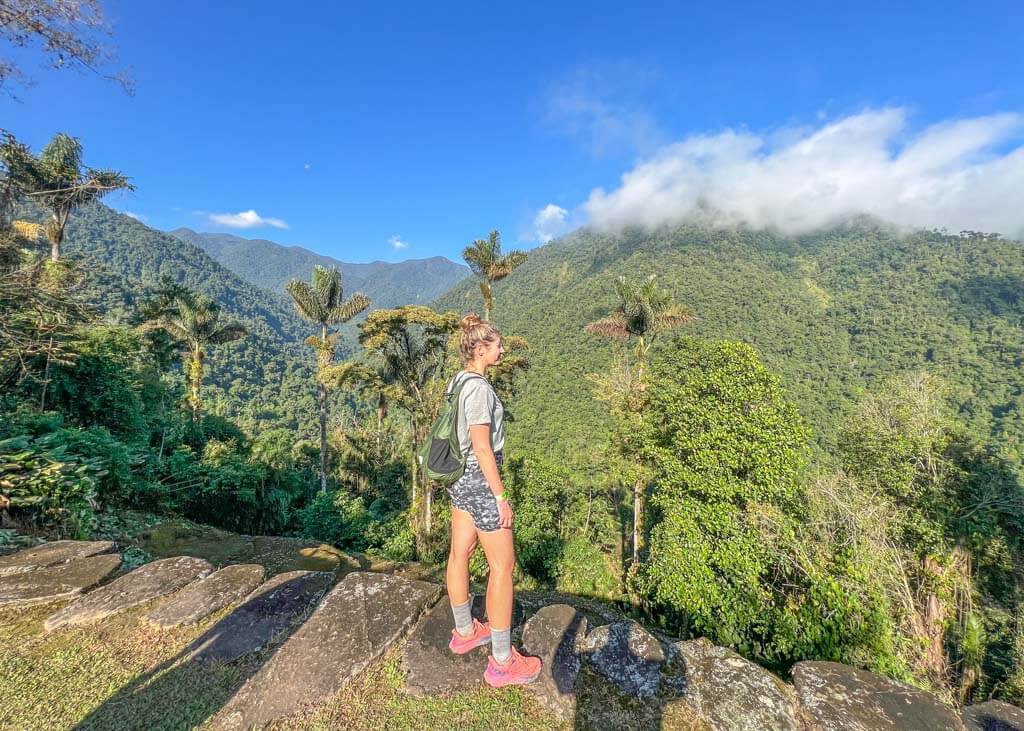
But December and January are extremely busy
I did the Lost City trek in February, and it was busy!
But after speaking to my tour guide, it seems that December and January are even busier.
70 people entered Ciudad Perdida the same day as we did, but apparently, during December, this number is double!
You’ll start your tour in Santa Marta
The coastal city of Santa Marta is the gateway to the Lost City trek. This is the departure point for all tours and is a 90 minute drive to the trailhead.
All tours depart early in the morning, so you’ll need to spend a night in Santa Marta before your start date.
Santa Marta wasn’t my favorite place to visit so don’t stay any longer than you have to!
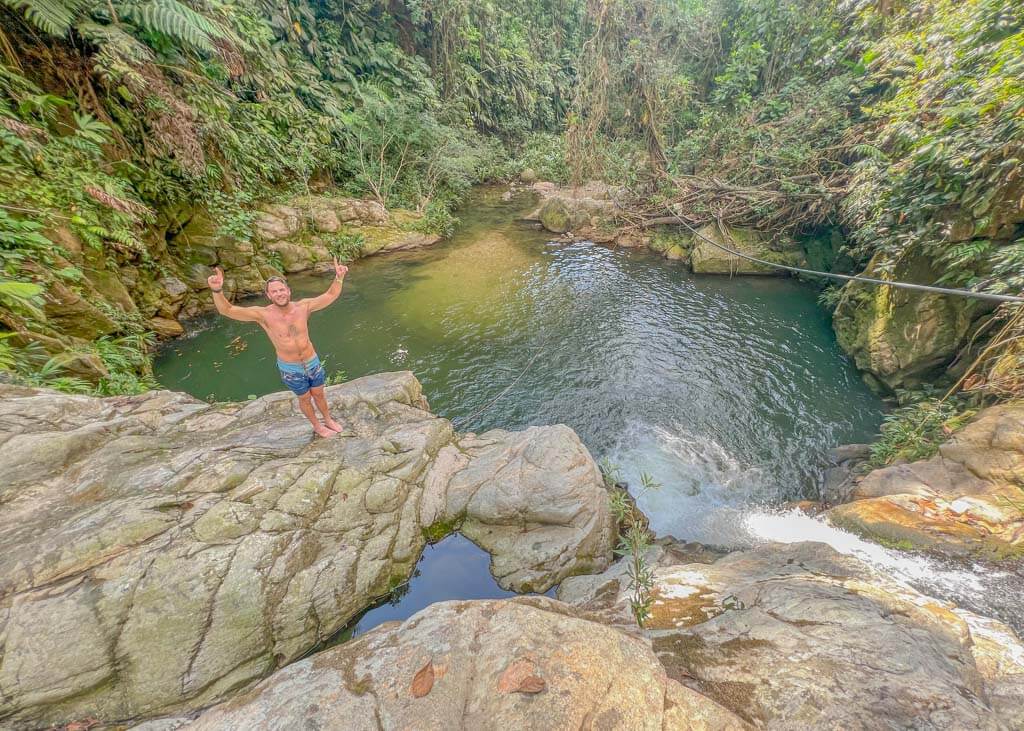
Some operators will arrange transport to and from Minca and Palomino
I wish I had known this!
But yes, you can request a drop-off or pick-up in one of the nearby towns (which are more interesting than Santa Marta) such as Minca or Palomino.
But you need to check that the company offers this service at no extra cost. I didn’t and so the option wasn’t given to me.
However, a few people in my group had specifically requested to be dropped off in Minca after the tour. Arrangements were made for them, and their stored luggage was brought to the trailhead on the last day.
I believe the bigger tour companies offer this service at no extra cost so inquire about it if you have plans to visit Minca.
2024 Update: Unfortunately, the tour operator I booked with (Magic Tours) no longer offers this complimentary drop-off in Minca after the Lost City Trek. They will drop you off at the bus station in Santa Marta, and you can take the bus from there. Luckily, a reader has let me know that Teyuna Tours does drop-offs in Minca.
If you’re reading this and have found another operator that offers this Minca drop-off service, please let me know in the comments section!
This brings me to my next point…
Visit Minca after your Lost City Trek Tour
Minca is a mountain town about an hour south of Santa Marta.
It’s the perfect place to rest and relax after trekking to Ciudad Perdida.
You’ll finish your hike at lunchtime and from there, you’ll take an hour’s drive back to Santa Marta. But don’t spend the night here.
Head straight to Minca and treat yourself to a mountain hotel where you can chill for a day or two.
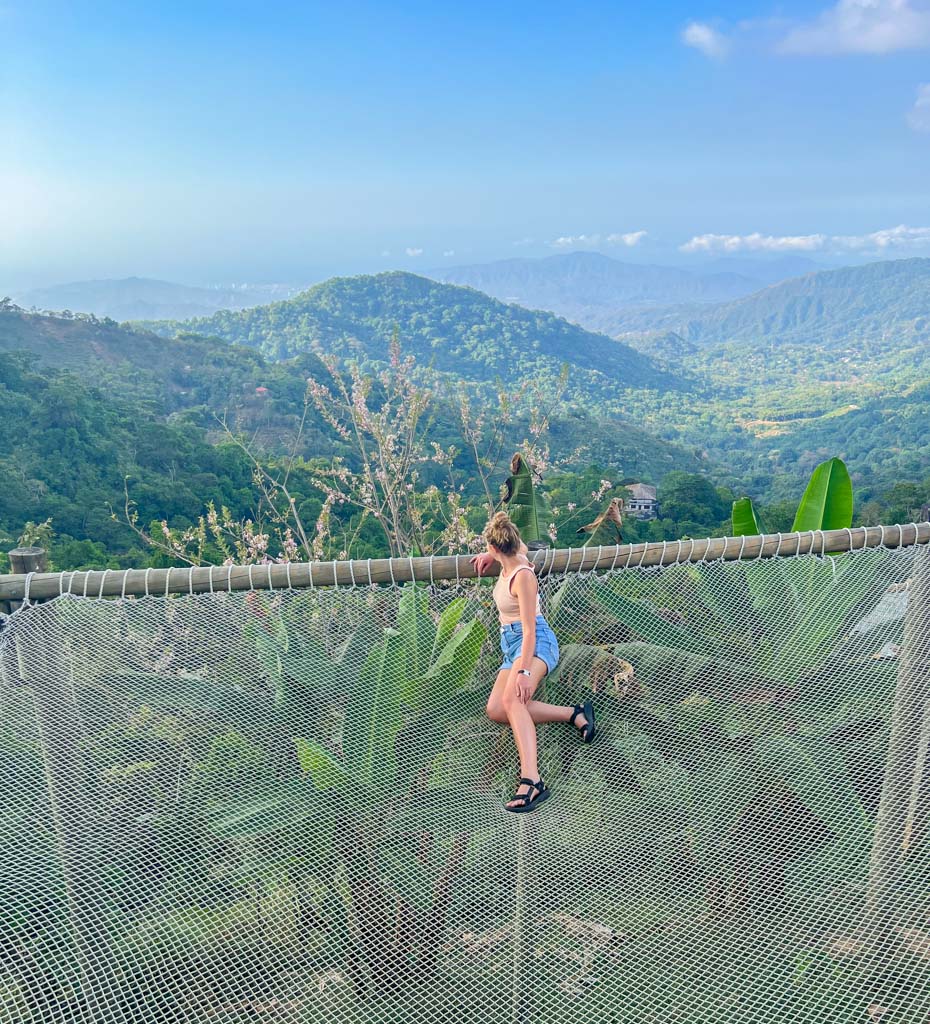
Tour group size: How many is too many
When doing my research, I made every attempt to find a Lost City tour operator that had good reviews and offered small group tours.
Despite my efforts, I somehow managed to book the most popular tour with the biggest group of travelers – there were over 20 of us in our group with 2 guides and a translator!
But this ended up being a blessing rather than a curse.
I met so many amazing people who made the difficult hike that much easier.
We sang, we drank, we sweated buckets – and I formed real connections with people from all over the world.
Lost City Tour recommendations
I booked my tour with Magic Tours, and I highly recommend them. I paid for the trip myself and they did not know that I was a travel blogger (so this is my totally unbiased opinion).
When I initially enquired about the tour, they said their group size was maximum of 12 per guide. What I didn’t realize is that they were quite happy to pair their groups together with 2 guides.
As I mentioned above, I was actually happy with this because it gave me the chance to meet 24 of the most amazing, diverse, and interesting people.
Teyuna Tours and Expo Tours also seemed to have big groups – and they also came with positive reviews.
However, if you’d prefer a smaller group, then you may want to avoid these tour operators.
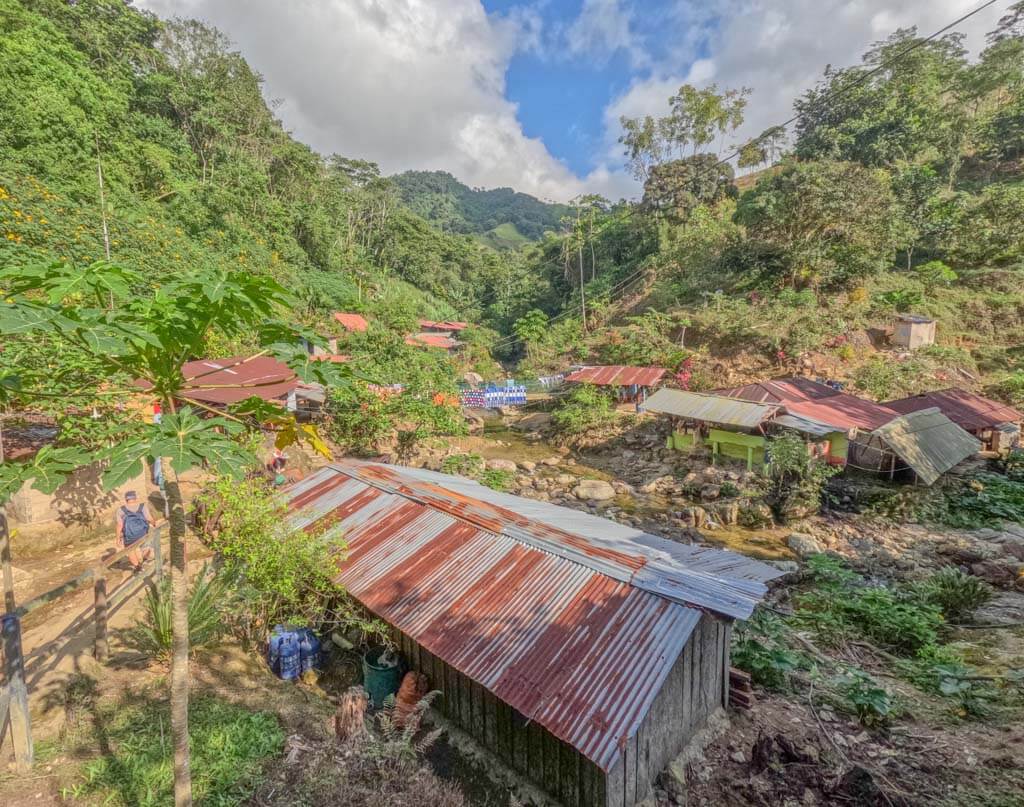
There are showers
This one really surprised me!
Yes, there are showers at each camp (and no, they are not bucket showers). The water is cold but at least you’ll feel fresh at the end of the day!
There are also flushing toilets.
You have to carry everything
You must carry your own bags with all your clothes and toiletries.
Food and bedding is provided at the camp so you won’t need to lug those around.
Because you’ll be carrying everything yourself, it’s important to keep your pack as light as possible. You don’t need a new outfit for every day – you’ll thank me later.
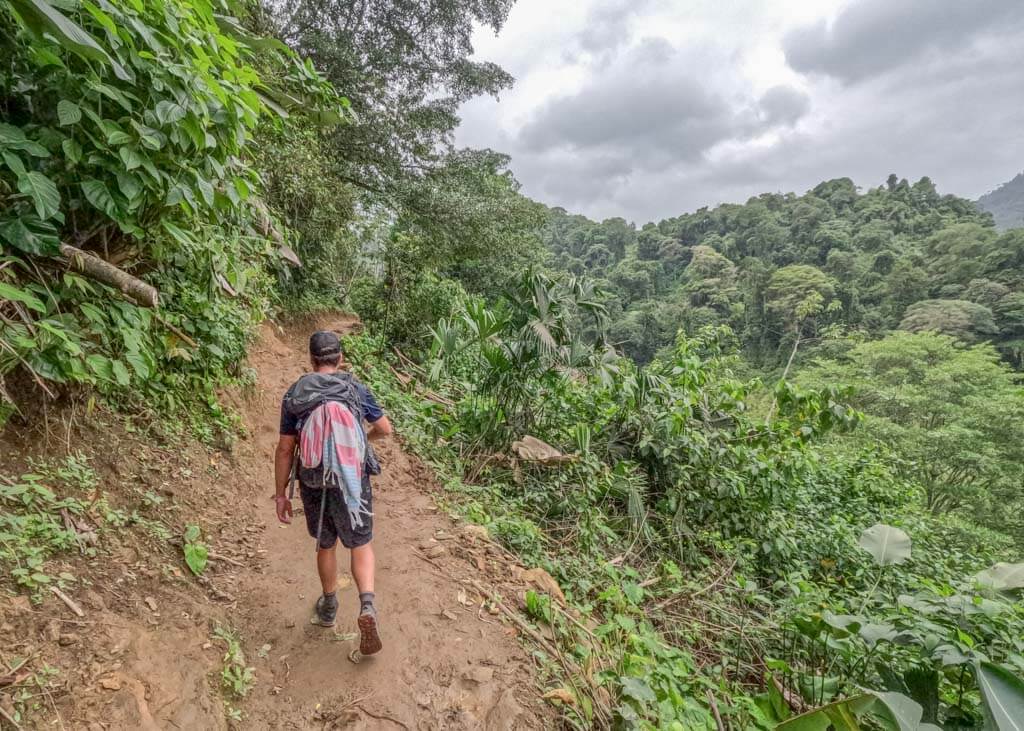
Know what to pack
When packing for the Lost City trek, it’s important to bring light and breathable clothes to walk in.
There’s no avoiding the humidity and sweat! I brought two sets of exercise clothes and switched them after two days.
I also recommend bringing a clean set of clothes that you can change into after showering.
Bring your own sheet (if you can)
Clean bedding (sheets and blankets) will be waiting for you at each camp on the Lost City trek.
I had read online that there are bed bugs, with a few people suggesting bringing your own sleeping bag. But I wasn’t going to go out and buy one specifically for the trip.
So instead, I went to a fabric shop in Santa Marta and purchased 3 meters of fabric which I used as a fitted sheet. It was light, small, and cheap so I’m glad I took it along.
But no one else on my tour had taken their own sheet or sleeping bag. And no one got bed bug bites!
But if you’d prefer to err on the side of caution, you can find the sheet shop here.
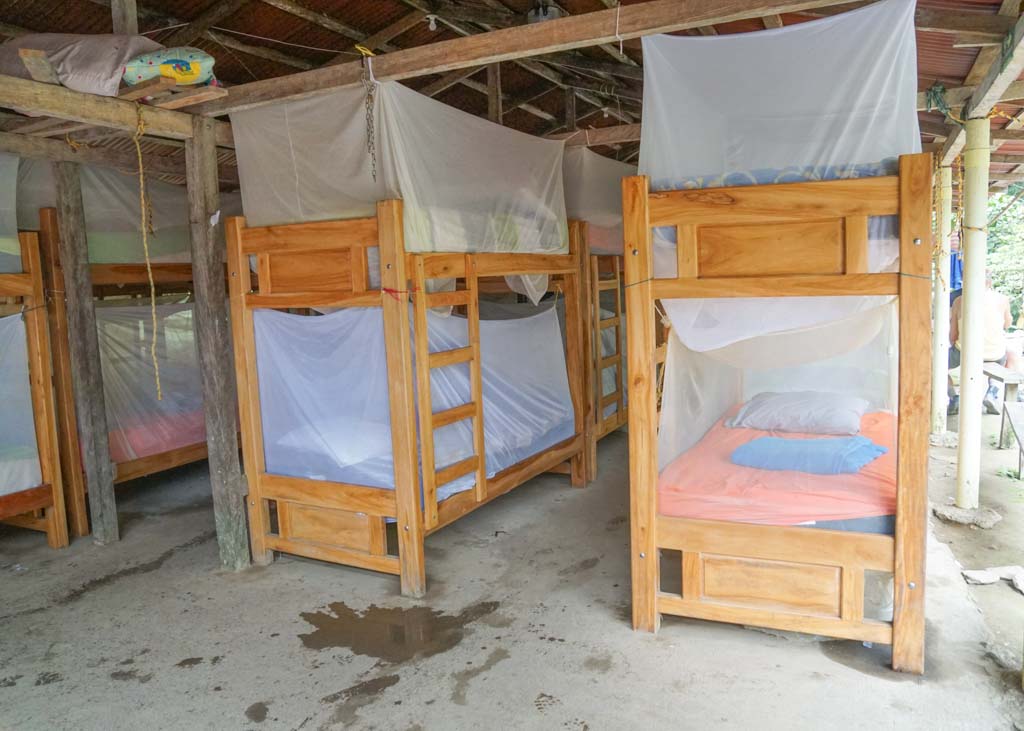
You’ll need money for beer and snacks
You can buy cold beers and snacks at all camps along the Lost City trek.
But things get more expensive the further up you walk.
I paid 6000 COP for a beer at the first camp at 10 000 COP at the other two. But it was worth every penny.
I recommend taking 200.000 COP in cash with you.
Drinking water is provided
Filtered drinking water is available at all camps so be sure to bring a reusable bottle with you.
Many people question the quality of this water and if it’s really safe to drink. I used my Grayl Ultrapress waterbottle to filter the drinking water that was provided and didn’t have any issues.
But everyone else on my tour drank the water without filtering it, and they were all fine.
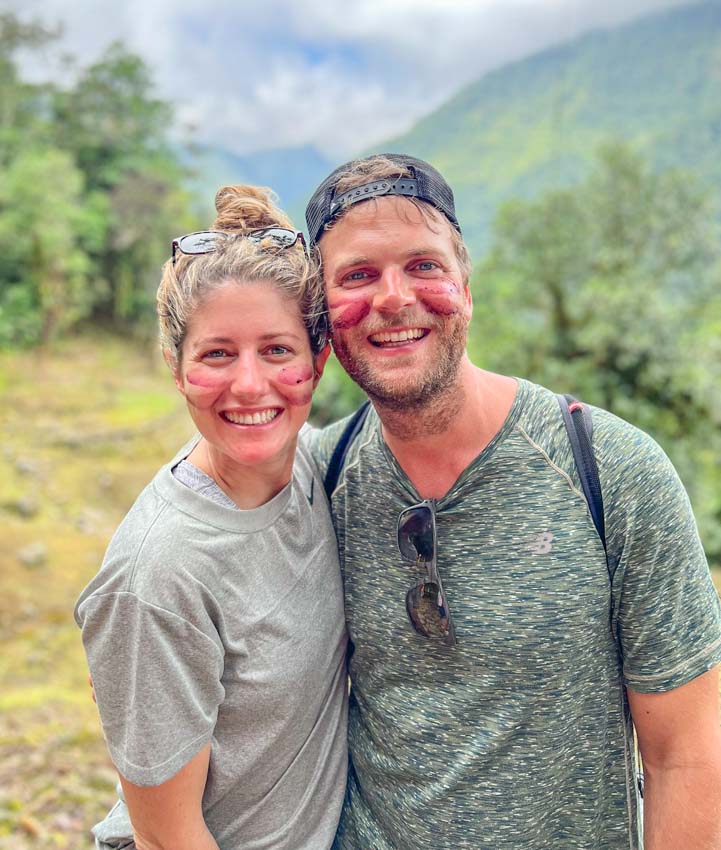
The stories of the Wiwa tribe are fascinating
Several indigenous tribes call the Sierra Nevada mountains home.
Most tours to the Lost City take you to one of these communities where you learn more about their customs, beliefs, and rituals.
We met the leader of the Wiwa tribe and it was a fascinating experience. I absorbed so much information in that short presentation and was blown away by their stories and lifestyle.
There’s constant development
To cater to the growing number of tourists, there is constant development along the Lost City route.
This is particularly true for the trail on day 1. As you go deeper into the jungle, there’s a lot less going on.
There are also new camps being built as tourists have previously had to sleep in hammocks (and even on tables).
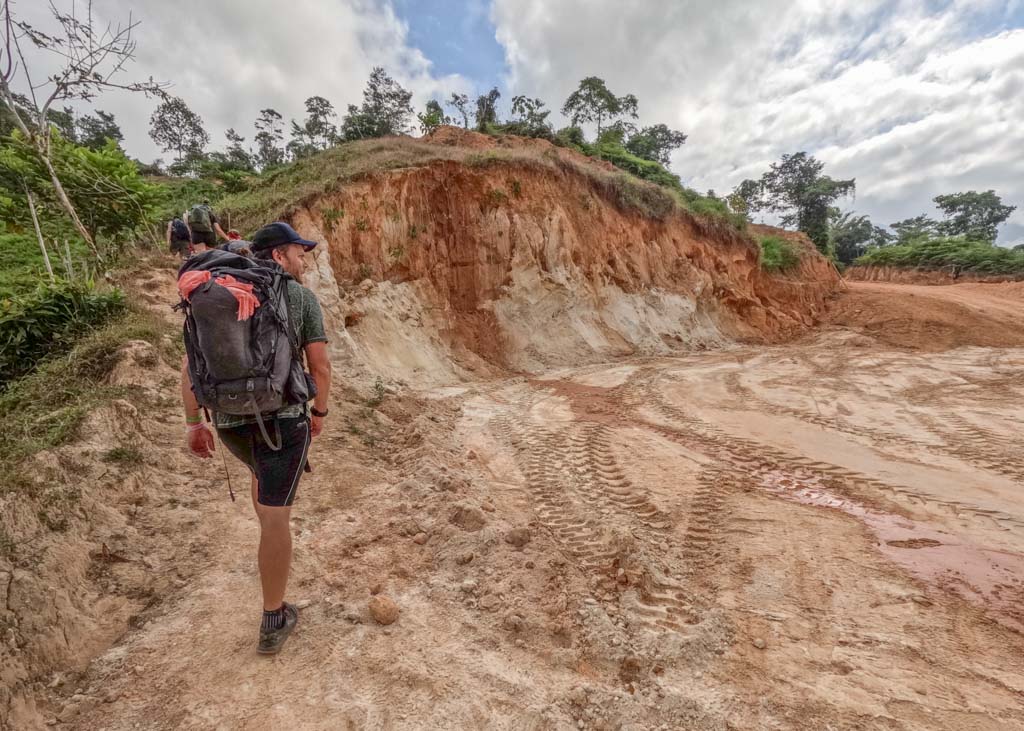
You can get a moto-taxi on day 1
The first day of the Lost City trek is mostly on a dirt road leading to the first camp.
I assume this was once a small path surrounded by jungle that has been cleared to make way for motorbikes and supply vehicles to get to camp 1.
Tourists now have the option to pay an extra fee for a moto-taxi to the first camp.
Taking a moto-taxi (instead of walking) is not common and you will need to request this – but it is an option if you choose.
But are you missing out by not walking on day 1?
Tough question.
If you’re traveling in a group tour, then I definitely recommend walking to Camp 1 (instead of taking the moto-taxi option).
That first day is the perfect opportunity to get to know your team and form connections. You’ll miss out on this if you take the easy way!
In terms of scenery, day 1 is still beautiful and offers plenty of spectacular views. But you’re walking on a gravel road for most of the way, not a small trail covered by lush jungle.
The scenery on days 2 and 3 is better. But I still recommend walking on day 1.
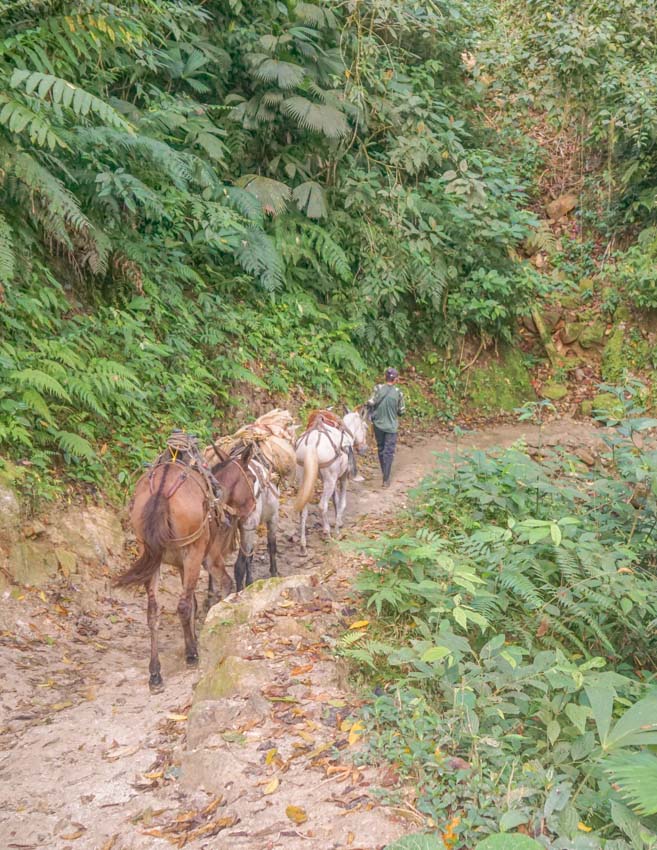
There are rivers and waterfalls along the route
I’ve never been so happy (and relieved) to see a river as I was on the Lost City trek.
There are streams and small waterfalls next to each camp where you can cool off and chill after the day’s hike.
Don’t forget to bring your bikini or bathing suit.
You can’t hide from the Mosquitos
Bring Deet bug spray with you as there are lots of mosquitos.
Most of my group, including me, got bitten all over, but thankfully the bites weren’t as itchy as those in the Bolivian Amazon .
All bunk beds have mosquito nets, and they were in good condition.
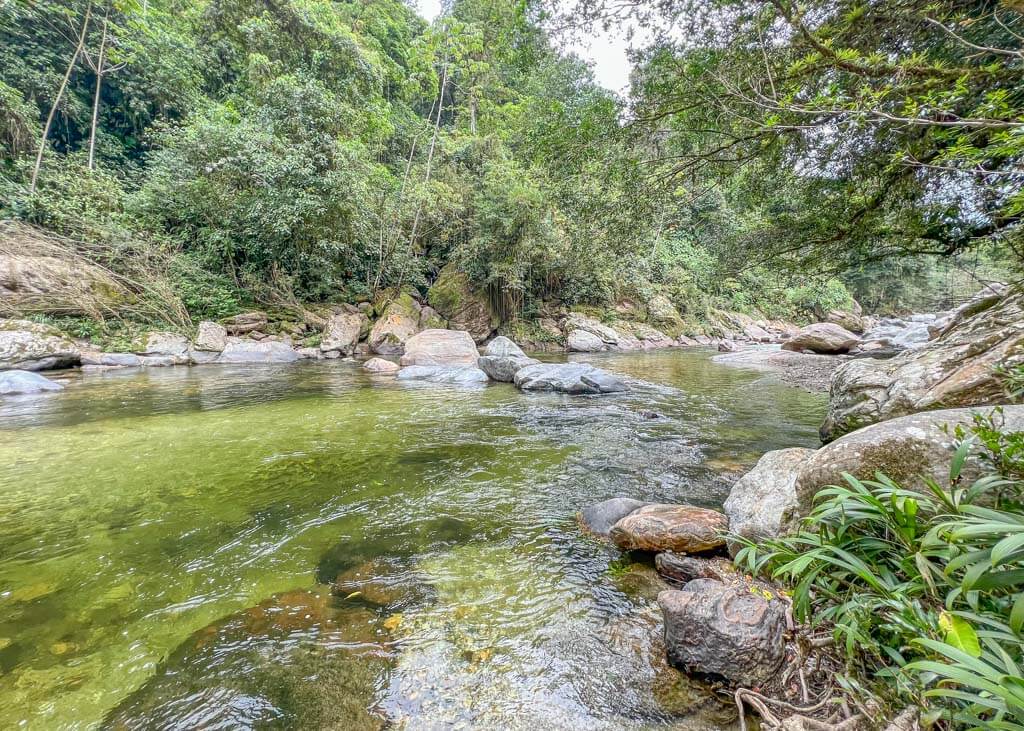
Some tour operators camp next to the Lost City
There is a small camp alongside the Lost City which is without a doubt the best place to stay!
I was surprised when I first heard this and was so bleak that we weren’t camping next to the ruins.
But this particular camp is very small and can’t accommodate many people.
I also heard of groups that were promised they’d stay at the Lost City camp, but when they arrived there was no space for them and so they had to go back down to another camp.
Some tours have translators
Most guides and people from the local communities do not speak English. Because of this, some tour operators (including Magic Tours) offer the service of a translator.
I am so happy we had a translator on our tour as we were able to really appreciate the stories from the Wiwa people and learn more about the history of the Lost City from our guides.
If you cannot speak Spanish, you may want to choose a Lost City tour company that includes a translator – this wasn’t an additional expense.
Embrace the Lost City Trek experience
The site of Ciudad Perdida is truly a special place and is more impressive than I ever could have imagined.
While the Lost City trek is gaining popularity amongst all travelers, it still has an authentic charm and is one of the best things to do in Colombia.
Are you planning on doing the Lost City trek in Colombia? Let me know if you have any questions!
Like it? Pin it!
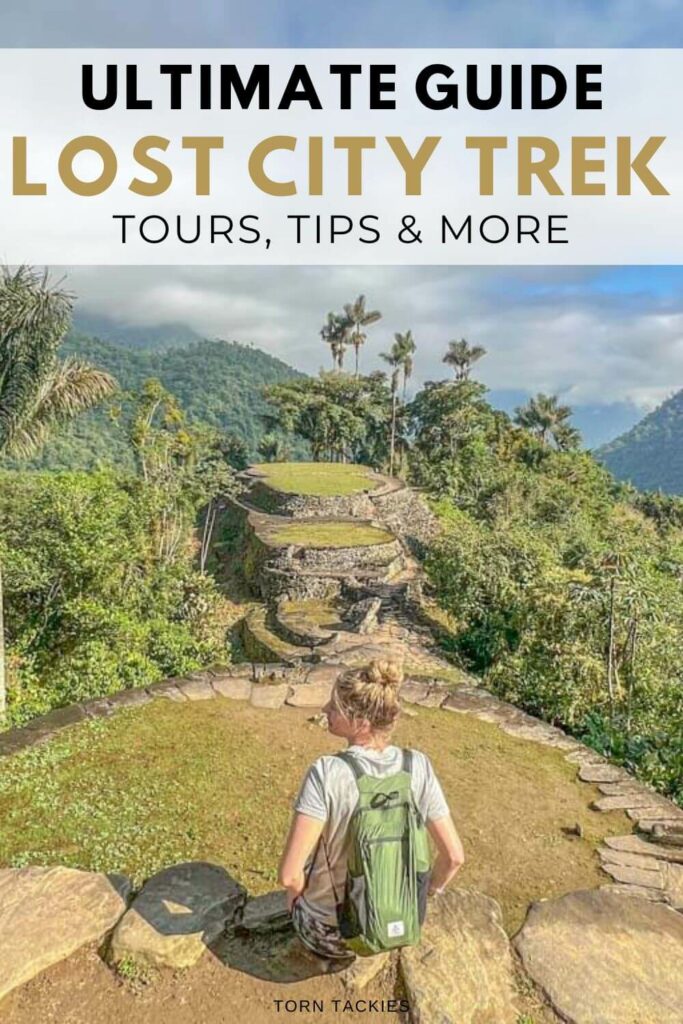
Hi, I'm Carryn. I’m an adventure travel blogger trying to figure out my way through life by traveling and exploring. Join me as I share my travel guides and tips for life abroad. Find out more about me here .
Visiting the Bolivian Amazon Rainforest: A Complete Guide 2024
Cenote diving in tulum: everything you need to know, 11 thoughts on “the lost city trek in colombia: 27 things i wish i knew”.
Hi Carryn, thanks for this post! I’m pretty sure I’m heading to Colombia, and doing the Cuidad Perdida Trek very soon, but your post opened my eyes to the many tour operators guiding the trek! I’m actually thinking about Minca too, but are the views not pretty much the same after you’ve been on the Trek?!? … though no doubt, much more relaxed in Minca. Heading to Minca right after the Trek seems like a neat thing to do … Do you remember which tour operator allows for this option? Thank you … & keep on travelling!
Hey Martin,
I’d say the views from Minca are from up above, where as with the Lost City Trek, you’re mostly deep in the jungle. I recommend going to Minca after if you want a few days of down time as it’s a much better place to recover than Santa Marta.
I did my trek with Magic Tours and they offered a complimentary drop off in Minca after the trek. But they don’t advertise this so I wasn’t aware of it at the time – until I heard via other people on my trek. The best thing to do would be to message them directly and confirm (please let me know the outcome). I think most tour operators will offer this service so if you have a particular company you’d prefer to go through, you should ask them too.
Hi! Thank you for very useful information regarding the hike and tour operators! I am also planning to go to Minca after the hike. I just messaged Magic tour and they did not offer drop off in Minca. They said I could be dropped off at the bus station in Santa Marta and from there take the bus to Minca. I can imagine being very tired on the last day so I might do some more research to find someone that does drop offs in Minca 🙂 Cheers!
Thanks for the update regarding drop offs in Minca. It’s a pity they’ve dropped this service given how expensive the tour is! If you find a tour operator that does a complimentary Minca drop off after the Lost City Trek, please let me know so I can update the post and recommend them.
Thanks, Carryn
Hi, I just booked with Teyuna tours and they will drop me off in Minca 🙂 Jenni
Thanks for letting me know Jenni! Have a great time at The Lost City.
ooops, I didn’t see your reply! I’m actually in Calabazo right now … hiking Tayrona tomorrow … then getting picked up by Expotur outside El Zaino entrance, to go on their 4-day trek. I wish I had seen Jenni’s reply. I brought up, at the Expotur office today, that I would be heading to Minca after, and I was offered being dropped off at Mamatoco, which I thought was great, until I took a good look at the map just now. I should probably go to the market in Santa Marta instead, and catch the bus to Minca.
I was dropped off at TRANSPORTADORA SIERRA MAR SAS MINCA (Diagonal 39 #5-148, Santa Marta), for a 10mil COP trip to Minca (3/2/2024).
Thanks for the update Martin!
Do you have any recommendations for lodging in Minca? Your photo with the hammock over the hillside is exactly the kind of R&R I’m looking for!!
That photo in the hammock is from Sierra Minca (here) . We spent the day here as they allow for day visitors to make use of their pool and restaurant which is what I recommend. It was stunning!
There are lots of options for accommodation high in the mountains (like Sierra Minca). They downside is that many are difficult to get to and you need to go by moto taxi. I paid 35 000 COP for the one way ride from Minca which took 40 minutes on a bumpy road. So if you stay at one of these lodges, you’ll probably spend most of your time there. If that’s what you’re looking for – then they’re perfect! But if you want to explore the town, eat at different restaurants, do a few waterfall treks, then you will spend a lot of time and money on moto taxis to and from Minca.
I suggest staying at a place like Casa Loma Minca (here) . I went for sunset drinks here and it’s a beautiful spot only a short walk from town. It is a popular place for sunsets though! You can then do a day trip to Sierra Minca instead.
Enjoy Colombia.
Leave a Comment Cancel reply

Expedition Colombia
Colombia Adventure Travel
Lost City Trek
Summary 4 days santa marta trekking.
What Machu Picchu is to Peru, the Lost City is to Colombia.
The Lost City or ‘Ciudad Perdida’, is an ancient city and sacred site of the Tayrona Civilization. It once covered the Caribbean coastal plain of Colombia and extended to the highest coastal mountain range on earth, the Sierra Nevadas of Santa Marta.
Travellers can see Machu Picchu by bus, plane, or taxi, but only an adventurous trekker can dare to explore the ‘Lost City’. Alongside a knowledgeable, bilingual, indigenous guide, commit to a minimum 4-day 70-km trek on ancient trails carved in mountain and jungles that cross over rivers and waterfalls.
Average trekking time 5 hours per day.
- Explore the largest pre-Colombian city discovered in all the Americas
- Trek in the tallest coastal mountains in the world, the Sierra Nevada de Santa Marta
- Visit a Kogi village and learn about indigenous cultures of Colombia
- Meet the living descendants of the Tayrona civilization
- Relax in jungle camps with beds, bathrooms, showers, and hot meals
- Swim in natural swimming pools, rivers, and tropical waterfalls
BOOK THE TRIP
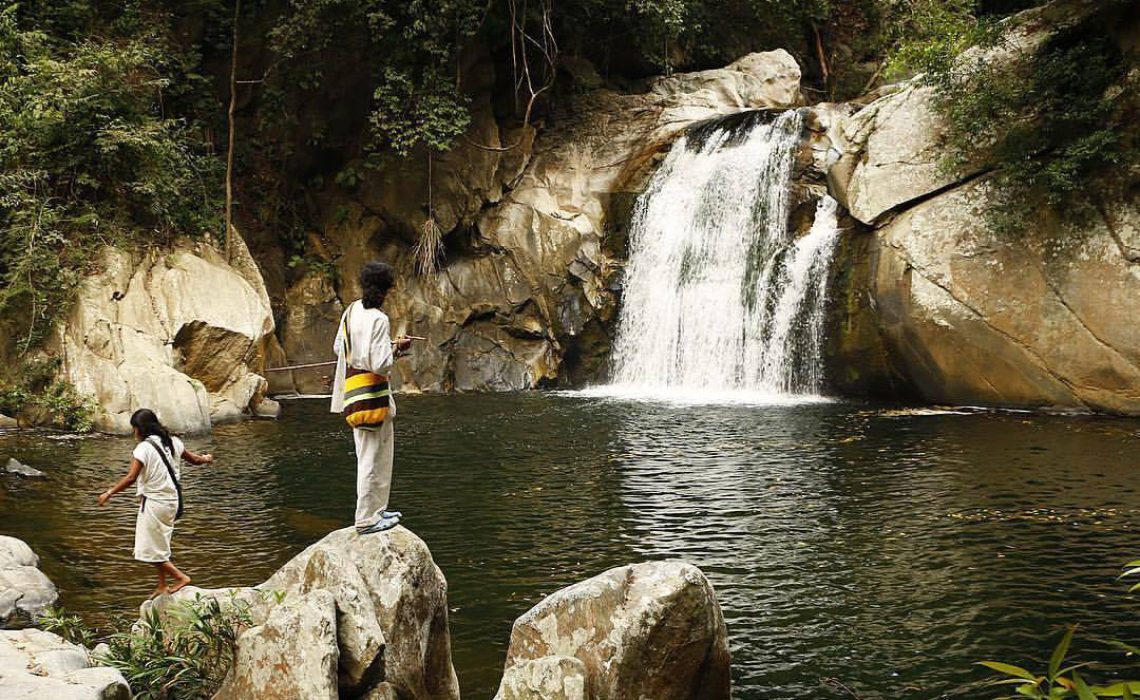
- The 4-Day Trek option includes 2.5 days of trekking to get to the Lost City and 1.5 days to get back
- Day 1: Santa Marta to El Mamey town to Adán Camp (Distance: 12.5 km)
- Day 2: Adán Camp to Paraiso Teyuna Camp via Mumake Camp (Distance: 23.5km)
- Day 3: Paraiso Teyuna Camp to Mumake Camp via The Lost City (Distance: 22.2km)
- On Day 3 enjoy 4 hours at Lost City to relax and take photographs
- Day 4: Mumake Camp to El Mamey vía Adan Camp (Distance: 12.2km)
- Return on Day 4 via an easy 4- hour trek and receive transport to Santa Marta
- Extension option to visit an indigenous village en-route, or upon return, to Santa Marta (depending on the village’s calendar) to gain Arhuaco perspective on the Lost City
- In total, the trail to and from the Lost City runs along the same path, weaving through the thick jungle of the Sierra Nevada mountains and covers the total distance of just over 45kms as the crow flies, or over 75kms (accounting for all the ups and downs)
- To begin the journey, your guide meets you at your hotel in Santa Marta, the second oldest city in South America and the capital city of dept. of Magdalena
- Drive for 100 km along a highway and dirt road (approx. 3 hours) from Santa Marta to trailhead at small town of El Mamey
- Today, trek from El Mamey to Adán Camp (Official Distance: 7.6km Actual Distance: 12.5 km)
- Experience stunning views of jungle mountains
- Tonight, you’ll sleep in open air bunk beds with mosquito nets
- Pillows and blankets will be provided
- Facilities at camp: bathrooms, showers, electricity with limited use (by generator)
- Enjoy breakfast at camp (eggs, bread, and some fruit along with coffee/hot chocolate/tea)
- Today, trek from Adán Camp to Paraíso Teyuna Camp via Mumake Camp (-Official Distance: 14.7km, actual Distance: 23.5km)
- Arrive at Mumake around 10-11am, and have plenty of time to relax and unwind before lunch
- Keep your bathing suit at the top of the pack as there is another swimming hole waiting for you at Mumake. It’s about 5-10 min walk away, but a dip in the refreshing, chilly waters is wonderful!
- Enjoy fruit stands along the way and a delicious lunch of rice, lentils, fried or grilled fish or chicken, salad, and fresh fruit juice
- After lunch, begin a 2-hour trail that follows the beautiful Buritaca River
- Visit a Traditional Kogi village en route to the Lost City and learn about indigenous cultures
- The descendants of the Tayrona, the habitants of the Lost City, are today known as the Kogis and Arhuacos are people remained ruled by ritual priesthood they believe the ecological well-being of the planet is held in their hands, their prayers maintain the cosmic balance of the universe
- Arhuaco and Kogis consider themselves as the elder brothers- they have a moral and ethical responsibility to educate us, “the younger brother” & they want to. They speak with passion in Spanish and in their own languages, to articulate with elegance about how the rest of the world needs to get our act together and care for the planet
- In Colombia, they’ve emerged as symbol of continuity and hope- the last 5 presidents have visited the Arhuaco communities via helicopter to get their blessing
- After a visit with the indigenous community, arrive at Paraiso Teyuna Camp for a restful sleep
- Today trek from Paraiso Teyuna Camp to Mumake Camp via The Lost City (Official Distance: 13.6km Actual Distance: 22.2km)
- Day 3 is an early 5:30am wake-up call, so you have breakfast and set off on today’s hike by about 6:30am
- Trek for one hour from the campsite to the Lost City with plenty of time there to take photographs, relax, and take an archeological tour
- It’s about an hour walk from the campsite to the start of the 1200 step climb up to the Lost City. It sounds like this part would take forever, but you can easily reach the top of the stairs within 20 mins!
- Begin a fascinating archeology tour that elaborates on the Lost City’s history:
- The city dates back to 14th century when it was populated by some 2,000-4,0000 native Tayrona people and served as their biggest urban and commercial hub spread over an area of 2 sq kms
- The conquest of Colombia in the 16th century was delayed, but when it broke out it was particularly violent, and the indigenous groups fled up to the lush jungle of the Sierra Nevada mountains and were miraculously left out of sight, out of mind, so they continued to follow their ritual practices. (other indigenous in general area are Arhuaco, and Wiwa people, but it is not thought that they lived in the lost city)
- In 1970, a local man stumbled upon the city in his grave-robbing expedition. For about a decade, the Lost City, which at the time was referred to as “Infierno Verde”, (Green Hell) was a site of fighting between the grave-robbers (Spanish: quaqueros), until the government finally allocated resources to protect and excavate the site
- Upon completing your Lost City tour, begin your return along the river bend and back to Paraiso Teyuna Camp for lunch.
- From there, you’ll head all the way back to Mumake Camp (approx. 5 hours)
- Electricity is generator powered and only goes on from 6pm-9pm. You will need to ask the owners as the outlet is in the house
- Trek from Mumake Camp to El Mamey via Adan Camp (Official Distance: 7.3km Actual Distance: 7.8km/12.2km)
- After an early breakfast, you’ll set off on a 4-5-hour trek towards Adan Camp
- This morning trek is fairly easy morning with some ups and downs along the trail
- Once at Adam Camp, those on the 4-Day Trek, will take a quick fruit and water break and continue for another 4 hours all the way back to El Mamey Camp
- Enjoy lunch at El Mamey Camp and hop aboard a 4WD van that will take you back to Santa Marta with your guide
Indigenous Visit Option:
Extend your trip by one day and one night to visit an Arhuaco village after your trek. Have the rare chance to connect with indigenous leaders by visiting their village situated on a beach by the sea and a beautiful river. Feel free to bring your bathing suit to swim or go fishing and indulge in local fish stews. Connect with the local weavers and watch as they make traditional weaving handicrafts, such as the Arhuaco “mochila”, or purse. Stay overnight at Taironaka Tourism Eco lodge and Archeology site located on the Don Diego River close to an Arhuaco village. In the evening, enjoy delicious food prepared by chefs at the lodge’s restaurant and stay overnight at the ecolodge. The following morning, you can float down the river in kayak or tubes to reach your own private beach on the sea, and return for transport to Santa Marta.
5 Day Lost City Trek Option:
The 5-Day Trek option, which breaks up the return journey by splitting up the 4th day of hiking into 2 shorter days. Those on the 5 Day trek will have lunch, enjoy the rock pools, and rest at Adan Camp. The following morning, you’ll take a leisurely 3-hour walk from Adan Camp to El Mamey where you’ll have lunch and catch a 4WD ride back to Santa Marta.
6 Day Lost City Trek Option:
There is also a 6-Day Trek option, which breaks up the 2nd (the longest and most exhausting day) into 2 days.
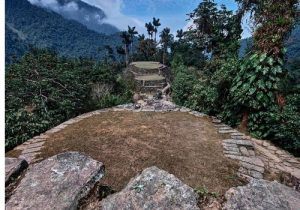
- Expert bilingual adventure and cultural guides (languages: Spanish, French, English)
- Emergency beacon, First Aid Kit, Colombian insurance
- All food and accommodation
- Excellent, filling hot meals prepared for you at camp
- A staple meal usually consists of rice, small salad, beans, and a serving of meat, alternating between fish, chicken, and pork
- Coffee/tea/hot chocolate and a sweet snack (a chocolate bar) are usually served for dessert
- Breakfast consists of eggs, bread, and some fruit along with coffee/hot chocolate/tea
- Lunch consists rice/beans/meat or fish or a hearty soup
- For snacks, your guide will provide you with fresh fruit and other delicious energizing goodies, but we recommend you pack extra snacks as you like
- Excellent vegetarian, vegan, gluten- free, and other dietary options * please notify us of any dietary preferences when you book the trip
- Accommodation on the trek includes clean campsites with bunk beds instead of just hammocks to sleep in for the night.
- Beds are right next to each other, but each bed has its own mosquito net that provides a bit of privacy between you and the person in the bed next to you
- Extension option includes comfortable overnight stay and dinner at Taironaka Tourism Eco lodge and Archeology site

- Bathing suit, sunscreen, bug repellent, sun hat, headlamp, UV Water Filter
- Lightweight, breathable long sleeved shirts and convertible hiking pants for sun protection (expect humid and hot conditions with warm breezes)
- Daypack (40 liters or more), bag rain cover, and dry bag for electronics
- 4 T-shirts, 3 pairs of socks, 4 pairs of underwear, 1 warm layer for cold nights, rain jacket
- A solid pair of hiking shoes, hiking poles (recommended), sandals
- Blankets and sheets are provided at camps, but a sleeping bag/ travel lining is highly recommended (or ask about this rental option when you book the trip)
- Most campsites have electricity as well as shower and bathroom facilities, so feel free to bring electronic equipment but you may want to bring a power bank for extra charges
- Bring your valuables, like a camera and tripod, but be aware that you will be sharing campsites with other groups and guided tours
- Travel Pillow, travel towel, soap, personal toiletries
- Your passport (no copies)
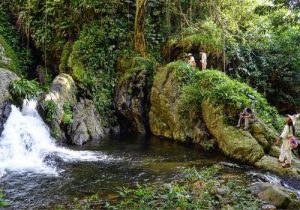
FITNESS LEVEL: 3 out of 5 = Several moderate physical activities raise your heartbeat on this trip. A good level of physical fitness is required. This trek is not technical & it does not require any equipment or any particular skills, but walking sticks, and a determined attitude, are highly recommended.
When to go:.
Dry Season (which runs from December through to early March) and rainy season (March to November). Treks to the Lost City are offered year around, but if you have a chance to choose when to trek, go in the dry season. Hiking in the rain on this hike is not ideal to say the least.
PRICE & RESERVATION
All included 4-days trek, all included 5-days trek, what they say:.

Departures everyday! Excellent vegetarian and vegan options! The best company to discover the Lost City in Colombia! Write us NOW!
Related trips.
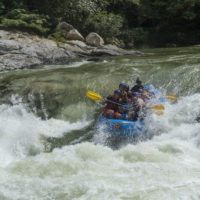
Colombia Rafting One Day
Enjoy our Colombia Rafting One Day Trip to the River Calderas. Three hours of the best whitewater rafting near Medellin!

Rafting and Paragliding Medellin
Rafting and Paragliding in the SAME DAY! Certified Instructors, Good People, Good Food, Good Adventure. BEST RATES IN MEDELLIN!

Guatapé Small Group Experience
Guatapé Rock and Lake – Medellin day trips. A unique way to see Guatape. Ask for bike option. Private car, highly curated experience.
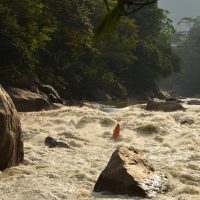
Kayak Adventures Medellín
Embark on an intermediate to advanced kayaking expedition and explore the surrounding of the city of Medellín. Enjoy great lifestyle, short shuttles, and perfect weather year round!

The Complete Guide to The Lost City Trek Colombia
Posted on Last updated: December 22, 2023
The Lost City Trek Colombia , or Ciudad Perdida Tour, has been at the top of my ‘to do’ list since I arrived in Colombia . Despite reading a lot of different blogs and speaking to others I still felt unsure what to expect leading up to the trek. So, to help you be as prepared as you can for taking on this challenging hike here is my complete guide to The Lost City Trek .
Did You Get Travel Insurance Yet? The Insurance companies I recommend are Hey Mondo and Safety Wing Hey Mondo is great if you are looking for a great value flexible policy. They offer single-trip cover, annual multi-trip cover, and long-term travel cover. Safety Wing is great value, with monthly coverage starting at $45.08. It’s super easy to use, and it just renews each month. I currently use them as they offer me free cover for my son as part of my policy. Read my full travel insurance post here, where I go into detail about all companies.
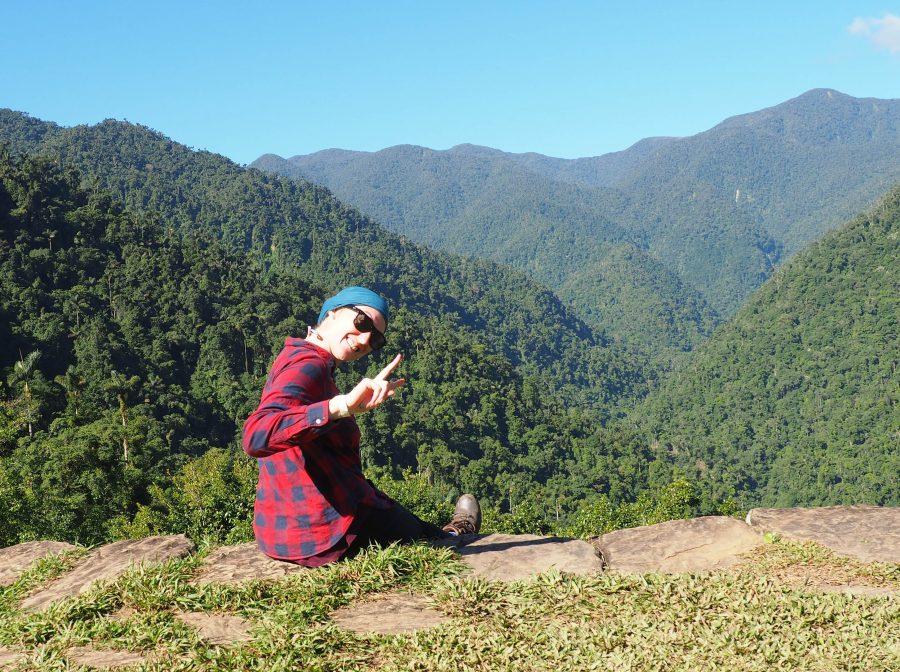
What is the Colombia Lost City Trek?
The Ciudad Perdida trek is a 46 km (28 miles) hike through the Sierra Nevada mountains. It is a jungle trek, so think hot and humid!
After day one you will be completely ‘off road’ and the only mode of transport other than your legs is a mule. The Ciudad Perdida hike takes you through the jungle to visit the abandoned city known locally as ‘Teyuna’.
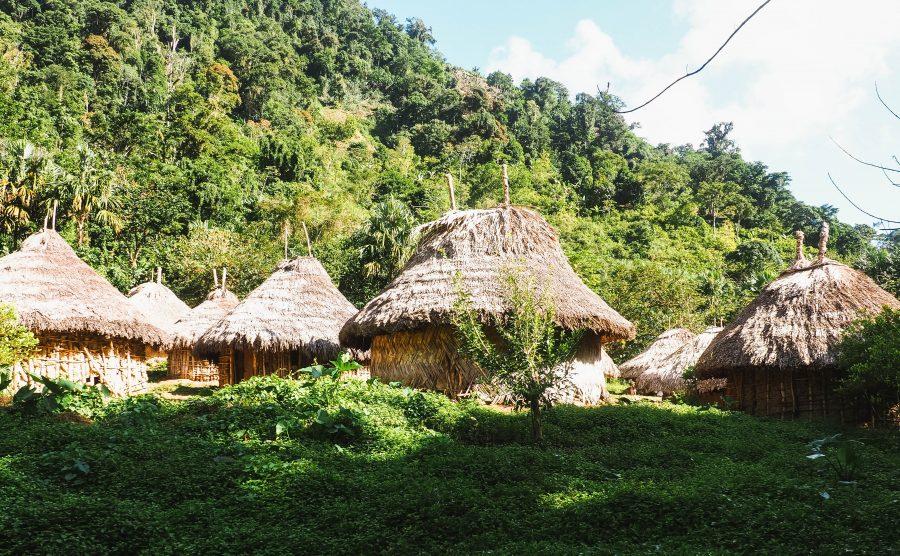
It is believed that the city was founded in 800 CE (FYI that’s 650 years before Machu Picchu). The Lost City was ‘rediscovered’ in 1972 by a father and son who began to loot the site. After the ancient artifacts began to appear on the black market Colombian Archeologists found out about the site and began reconstruction, which was finished in 1982.
History of Tourists Trekking Ciudad Perdida
Adventurers from around the world began to visit the Ciudad Perdida in the 70’s navigating through the jungle alone. Formal tours didn’t begin to take place until later. A government program to help displaced farmers began training them to be tour guides and take groups of tourists to visit the site. It is now compulsory to go with a local guide and money from each tour goes to help support over 400 families in the area.
The trek was relatively unknown to mass tourism until 2003 when the ELN kidnapped 8 tourists . Ironically, after this, people began to flock to Colombia to see the Ciudad Perdida for themselves. Don’t worry about the trek, and hiking in Colombia, in general, is now very safe. In fact, there is even an army unit based in the city. You can rest assured that it is now safe for tourists.
The form you have selected does not exist.
Who is the Ciudad Perdida Trek for
This tour is not recommended for beginner hikers or people with a below-average level of fitness.
One thing I would say is that it’s not an easy trek, you need to be prepared for a lot of walking in some difficult conditions.
Therefore this isn’t a trek you get talked into doing by your friend. You need to want to do it. And you need to be prepared for it. It is one of the best things I have done, but it was hard! So if I haven’t already put you off, keep reading for more information. Or take a read of these inspirational quotes to find some more motivation!
There are plenty of less challenging places for hiking in Colombia close to Santa Marta , like within Parque Tayrona .
How to choose the right tour operator for the Lost City Trek
When the government put conditions on the trek to make it fair all of the operators have to charge the same price. This means what you need to look for in a tour operator is the service you will get. There are 6 main tour operators running tours to Teyuna, so you only have to choose between the 6! I decided to do with Magic Tour Colombia for 2 reasons.
1, I took a tour to Punta Gallinas with them and I was seriously impressed with the service I received and
2, they had great reviews. I can’t speak for the other operators but here are some things to look out for and my experience with Magic Tour Colombia:
Accommodation on the Lost City hike
Some of the operators provide hammocks to sleep in. With Magic Tour Colombia, I slept in a bed all 3 nights. Now, this might not seem like a big deal, but after hiking for 7+ hours a day the thought of sleeping in a hammock didn’t appeal to me! The temperature in the jungle drops at night and the hammocks are more exposed to the elements.

What is the food like on the Lost City Tour?
As a vegetarian food on tours is always a bit of an issue for me. When you are doing something this physical you need to be well fed to sustain your energy. I can honestly say that I was really, really well fed over the 3 days. In fact, I was so well fed I didn’t eat my snacks! I ended up giving away all my snacks as I didn’t want to carry them around anymore. We had a whole catering team who traveled with us.
They were total rockstars! The food was incredible and we were told right at the start that if we wanted more food all we had to do is ask.

Is the Lost City Tour in English or Spanish?
This is a general thing in South America . If you don’t speak Spanish you need to make sure you communicate this to the tour operator.
Some operators will charge you extra for having the tour in English. Either because they will need to provide you with a translator or they will need a guide who speaks English, this is seen as an extra skill so the guide could be better paid. With Magic Tour Colombia, we had both a Spanish and English-speaking guide at no extra cost.
If you need the tour in English make sure to request this when booking .
If like me you are a bit of a history geek, and love learning about the history of a place, then take this into consideration. Our guide Tomas was pretty amazing. I learned so much over those 4 days about the local area, culture, history and especially about the indigenous people. It was the highlight for me.

Health & Safety
If there is one thing I’m always a bit worried about it’s getting injured doing something like this. As far as I know, all of the guides have to do first aid training before starting the job. My worst nightmare happened on the way back and I fell spraining my ankle and knee. The team was great and got me strapped up quickly. Luckily I was able to finish the hike (more about this later) and one of the guides stayed with me (at the back) to make sure I was ok.
How to prepare for the Lost City hike
If there is one thing I wish I had done before the hike it would be to be better prepared physically. Don’t get me wrong I’m not in bad shape. BUT I had just spent 4 weeks in Spanish school sitting on my backside. I think if I had just gone for a run once or twice a week that might have helped! So if you know you have been sitting on a lot of busses and not been very active then get yourself outside and go on a few long walks or runs. Your body will thank you for it!
What to pack for the Ciudad Perdida Tour
Rule number 1, only take what you absolutely need!
You are going to have to carry this stuff on your back for 4 days. This is what I would suggest taking with you.
- Small hiking backpack – make sure you have a waist strap (for comfort) and a place to keep your water for easy access.
- Quick-dry towel
- Hiking boots / Hiking sandals/ sneakers with a good grip
- 4 pairs of socks
- 4 t-shirts to walk in (ideally these would be quick dry)
- 2-4 pairs of shorts/ long pants/ leggings (you want 2 as a minimum 1 pair of shorts and 1 pair of long pants. Things don’t dry in the jungle so if you don’t like the idea of wearing something damp and dirty take 4). I took 1 pair of shorts, 1 pair of leggings and 1 pair of long trousers that could turn into shorts.
- Swimsuit – You get to swim every day so don’t forget this!
- Something to wear in the evenings and to sleep in – I took some lightweight bottoms and a long-sleeve T-shirt which I wore each night for dinner and to sleep in. Remember it gets cold at night.
- Something warm to wear in the evenings – My only regret was not bringing a jumper with me! A lightweight fleece would have been perfect.
- Underwear – I’m not a fan of bras, so I just took 2 bikini tops 2 bottoms and 3 pairs of panties with me. I wore the bikinis to hike in as they are not only quick dry but it also meant I was ready to swim at any time!
- Headtorch – you will need this in the evenings
- Sun Care products
- Bug spray – super important!
- Toilet paper
- Mini first aid kit (Make sure you have ibuprofen and plasters)
- Earplugs (jungles are noisy and you sleep very close to others who could be snoring)
- Energy powers to add to your water – get something with electrolytes in it to help keep your energy up.
- Water 2L minimum – if you have a Camelbak bring it!
- Hiking stick
- Shampoo (I didn’t take this as I kept my hair braided for 4 days)
- Lavender oil (Great for bug bites, cuts etc and it will help you get to sleep)
Need Transportation in Colombia?
I highly recommend booking Colombia transportation with GottoGo . You can search for buses, shuttles, ferries, and flights on their website—I love their customer service. I know them personally from my time living in Guatemala, and they genuinely care for their customers. If a delay occurs and you miss your bus, call them for help. If you book through GottoGo, you will pay more than at the bus station, but it’s worth it for the ease and security. Click here to search for transportation in Colombia.
What to expect on the Ciudad Perdida Tour
In this section, I’m going to talk you through each day of the trek. To be clear this is my personal experience of it. Everyone experiences it differently depending on their fitness and preferences, I have tried to be as neutral as possible, but this was my experience of the Lost City trek with Magic Tour .
Be sure to get a good night’s sleep and eat a decent breakfast! I was told to be at the office in Santa Marta at 8:45. This is to sort out the paperwork, pay the final balance and listen to the pre-trip brief. We didn’t leave the office until 10:30, but there was coffee, so I was happy!
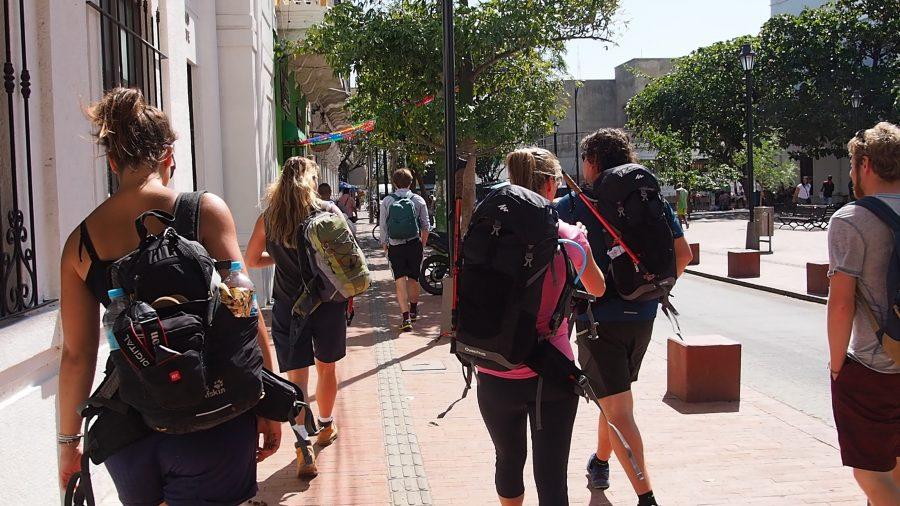
You will go in a minibus first before changing into a 4X4 to make the rather bumpy journey to Mamey or Machete as it is locally known. You will have the chance to grab any last-minute supplies at both stops.
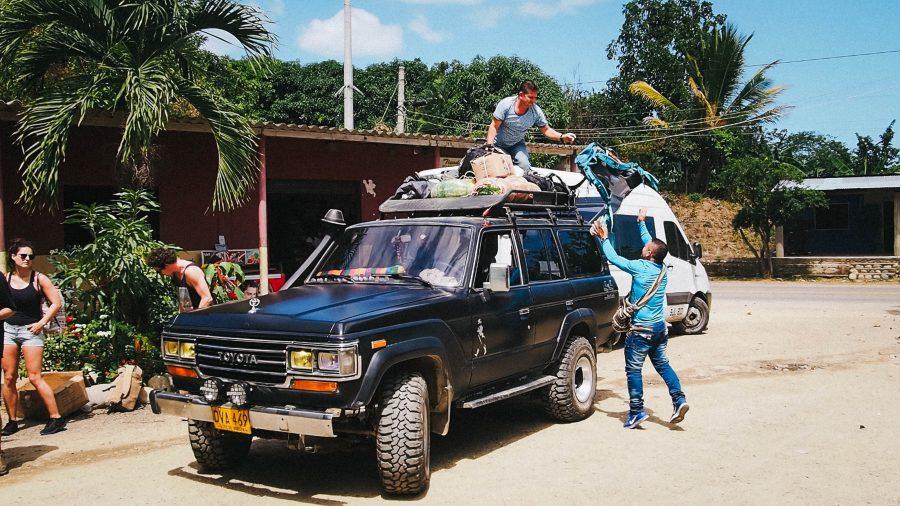
We had lunch at Restaurant Edel Mira in El Mamey at 1 pm followed by a more detailed pre-hike talk from our guide Tomas. Using the map, he talked us through each day of the trek letting us know what to expect. Then we started the hike, from here you will have no phone service until you return after the hike.

On day one you have 3 hours of hiking. This was the worse day for me. The hike was brutal! It’s all uphill, you are at a low elevation so it’s still very hot, there is little shade and my bag was at its heaviest due to water. Plus it was a bit of a shock to my body after being sat in class for 4 weeks prior to this.
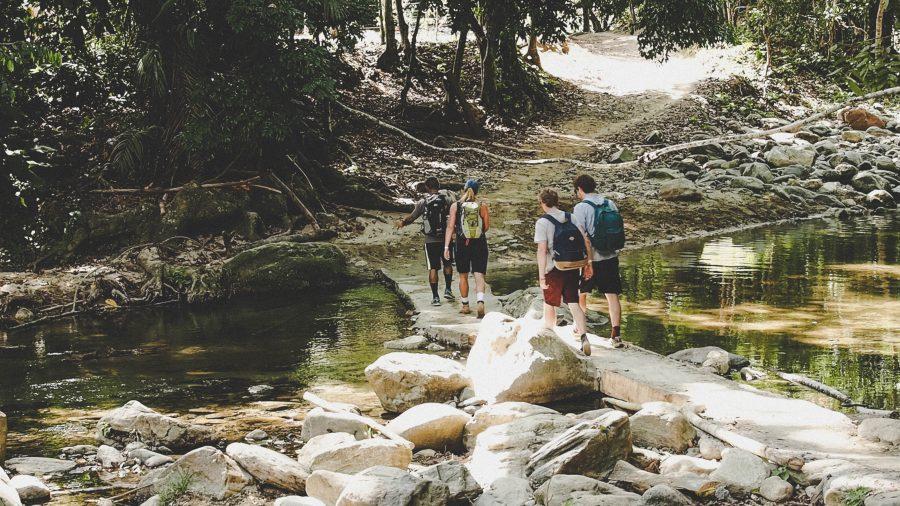
In some ways, it’s easier as you are mostly on the road so you don’t need to be quite so alert to where you are stepping, but the lack of jungle coverage made the sun pretty unbearable. For me, nothing over the 4 days got worse than this.
The good thing is at the top of each hill was fresh fruit and at each place we camped, we were able to go swimming! I can’t even tell you how good it felt after hiking it jump into that water and cool off!
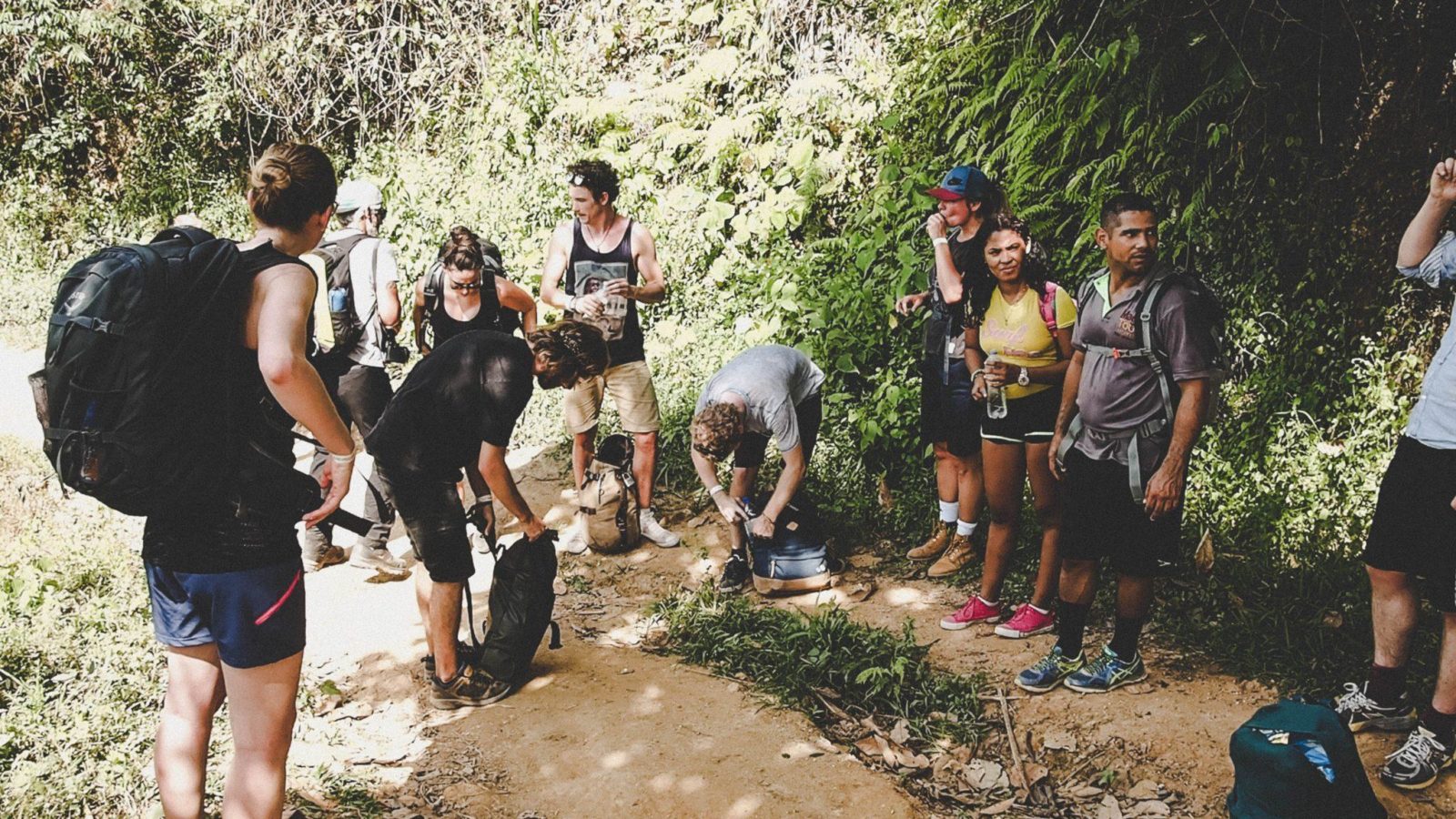
Be warned you will have early starts every day! We were up at 5 am, breakfast at 5:30 and on the trail by 6 am.
Although this may feel like a shock if you aren’t a morning person the mornings were my favorite hikes. Hiking before the sun is high was so much easier! You are well and truly in the jungle now and honestly, I felt like Indiana Jones! The path is pretty easy to follow and as I lagged behind filming and taking photos a lot there were times when I found myself alone walking the path. Although I wasn’t ever alone for long I really enjoyed these moments.

Expect a lot of uphill in the morning, but as you are shaded and it is early it’s pretty cool. We stopped at an indigenous village to learn more about it. This village is still in use but just for special occasions and celebrations.

After 3.5 hours of hiking, we then stopped for a swim and lunch. BEST. THING. EVER. after all of that walking. If you get lucky and it is sunny you can hang your clothes up to dry. We did get lucky and in an hour managed to dry everything off. This was the only time this happened during the trek! From here on expect to be wet!
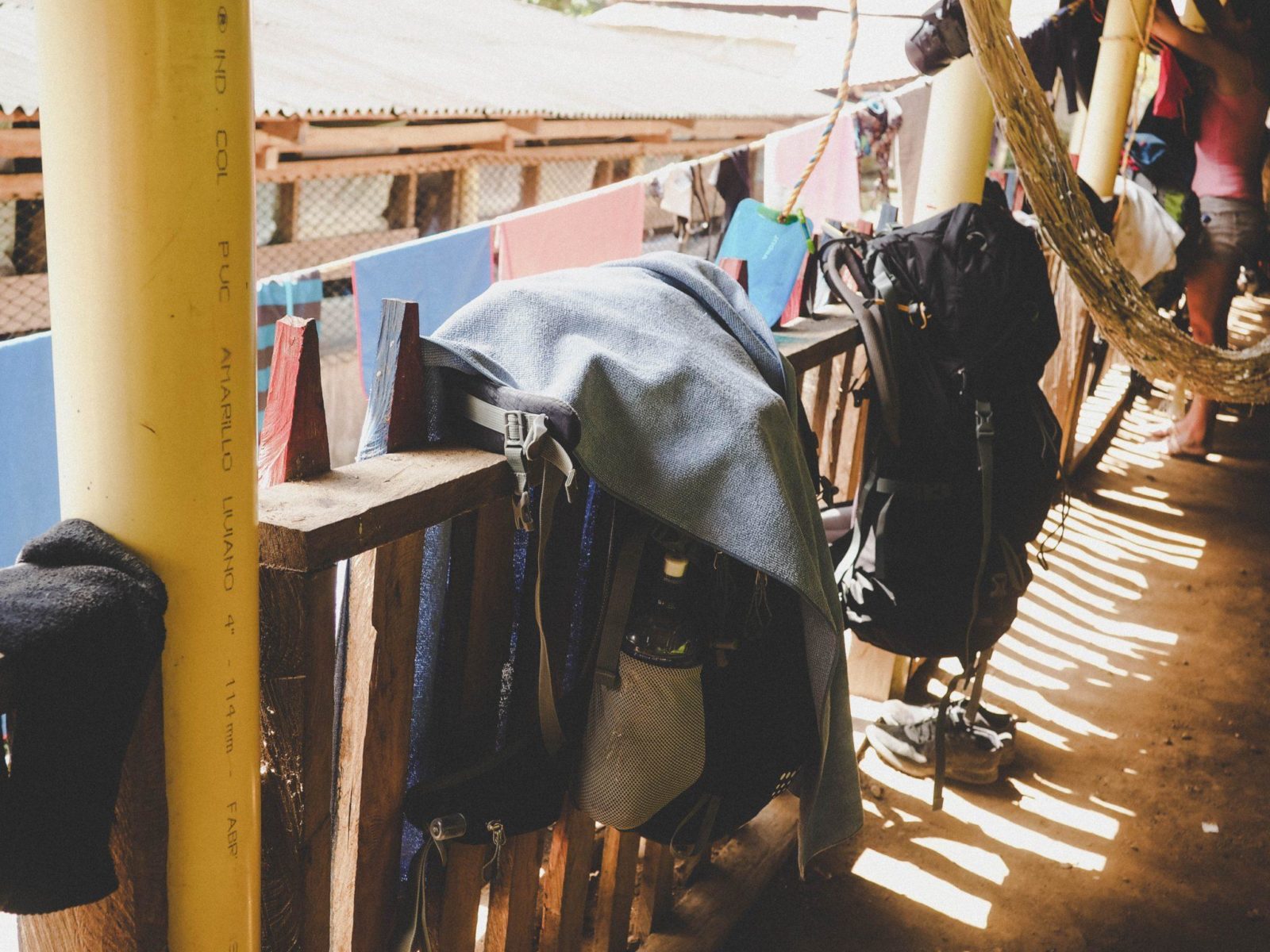
The afternoon hike was tough (but not as tough as the day before). The views are spectacular during the pm so take your time and soak it all in. You will have to walk through a river so make sure you wear shorts on day 2! If you have hiking sandals now is a good time to wear them! Otherwise, you will need to take off your boots to cross the river.

Word of warning, go slowly and be careful! I saw 2 people fall in the river, one of the girls got her boots soaked and had to walk for 2 days with wet boots! Not fun.
On night 2 everyone for all of the tour groups stays together in Paradise Camp. Because of so many people, a lot of the groups slept in hammocks. Lucky for me Magic Tour made sure most of us had a bed. A few of the younger group members who volunteered to sleep in a hammock. There was a river to swim in here, but as you are at a higher altitude it is COLD. So I gave it a miss, the cold shower was enough for me!
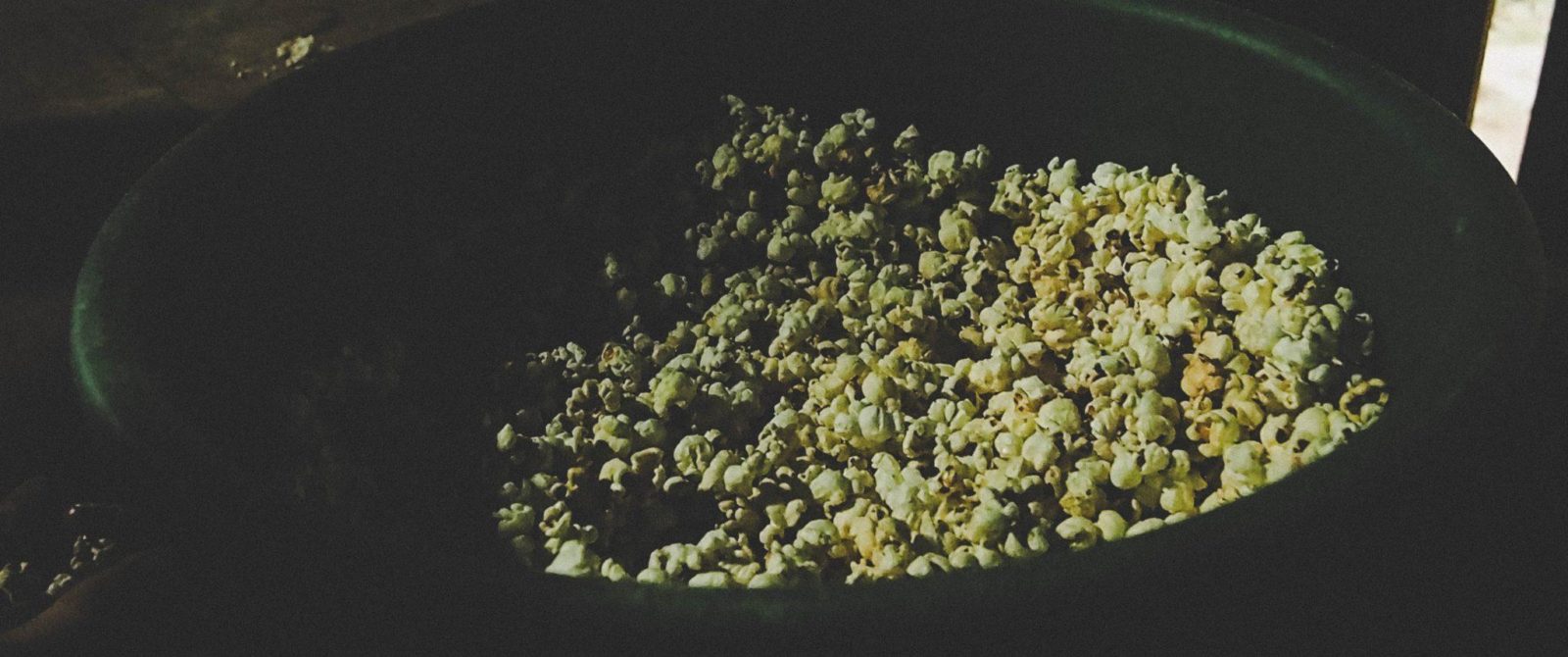
We ate a lot of popcorn and then spoke about what to expect the next day. I can’t even tell you how happy I was to find out I wouldn’t have to carry my bag up the 1000+ steps to the lost city haha.
The big day! Be sure to get up early and get ready to leave at 6 am. You will be able to lock your bag up in a storeroom and all of the groups leave at a different time to avoid ‘congestion’ on the trail. The hike to Teyuna in the morning is pretty short compared to the other days. But it’s 1000+ steps up! Great workout for your butt though.

It actually wasn’t so bad. But save some energy for when you get there as the Lost City is built on the side of the mountain so you will keep climbing up if you want to get the iconic photo.
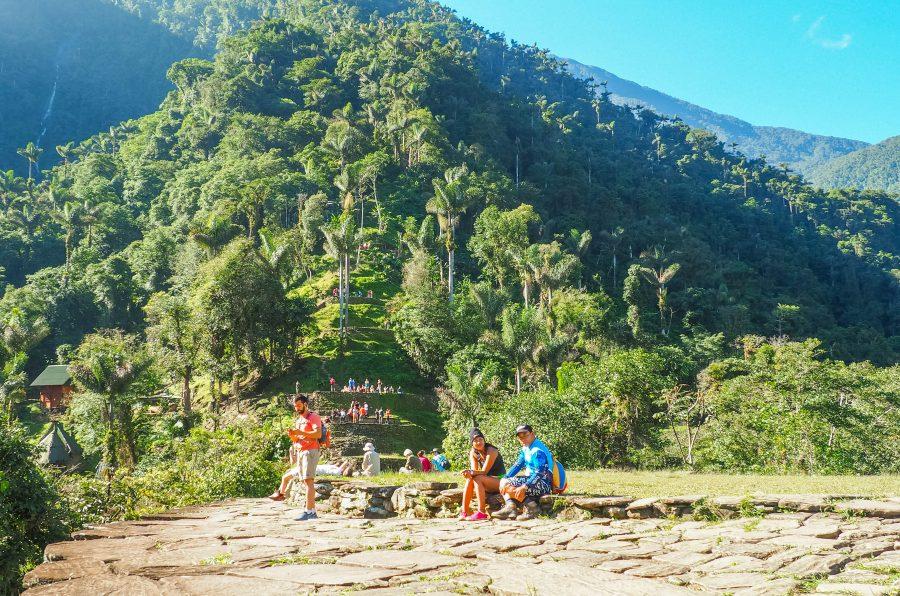
As we were guided around Thomas gave up so much information about the city and the history.
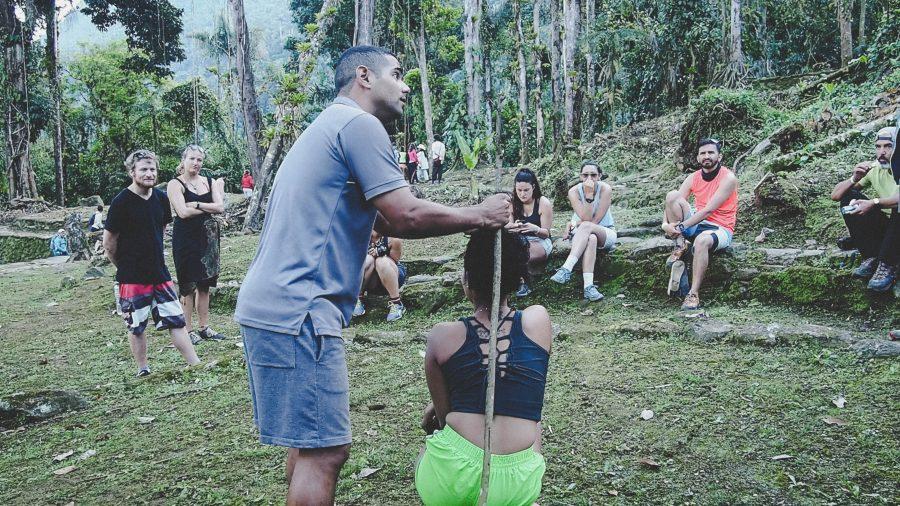
After this, we were given some time to explore on our own before meeting back up for snacks!
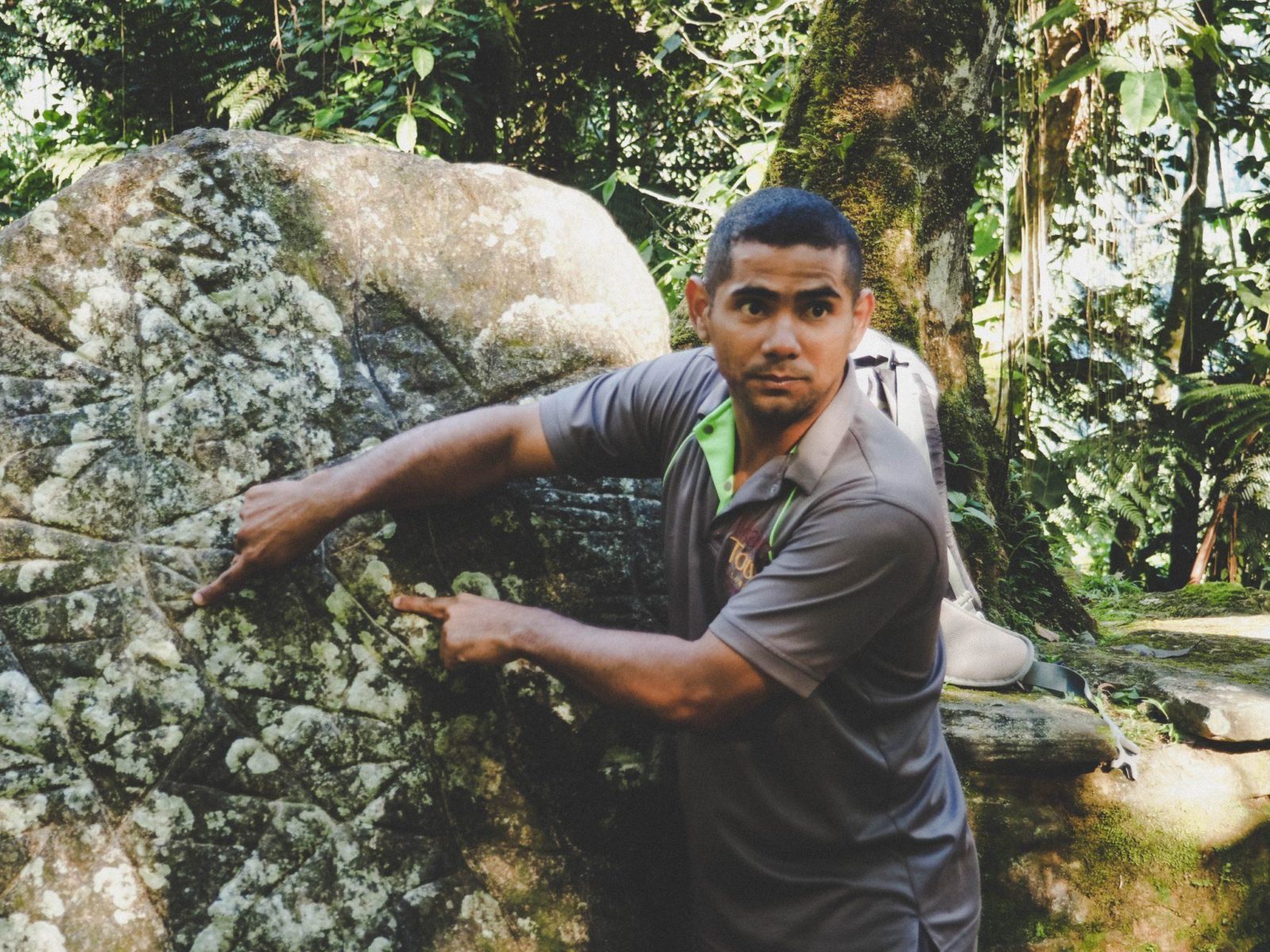
Once we had finished exploring the Lost City we continued on to see a traditional casa up close, where If you get lucky you will get to meet the Mama (leader of the Kogi people living in the area).
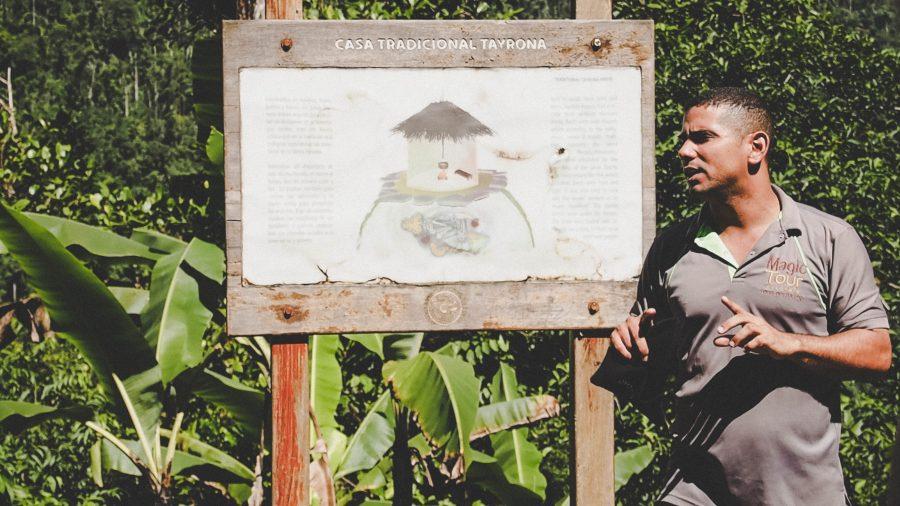
Sadly he wasn’t there but we did get to meet some of his children.
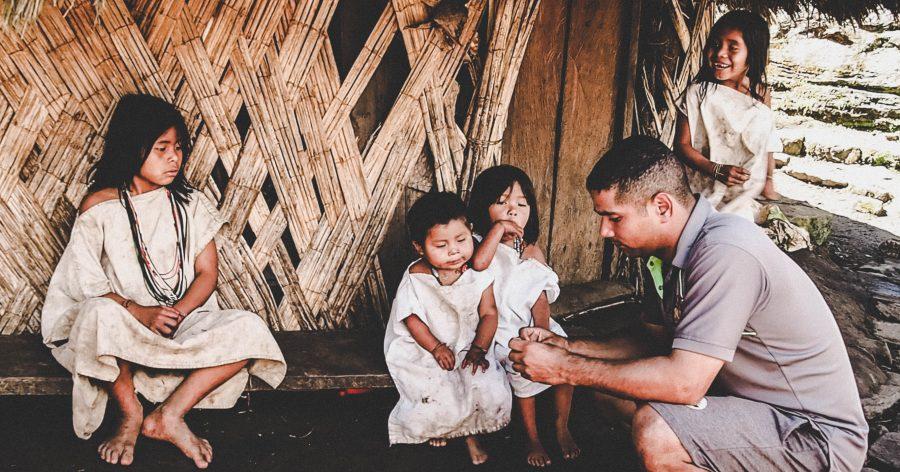
Here we learned more about the indigenous people of the 4 tribes Kogi, Wiwa, Kankuamo, and Arhuaco. After passing many Kogis and Wiwas it was so interesting to learn more about them.
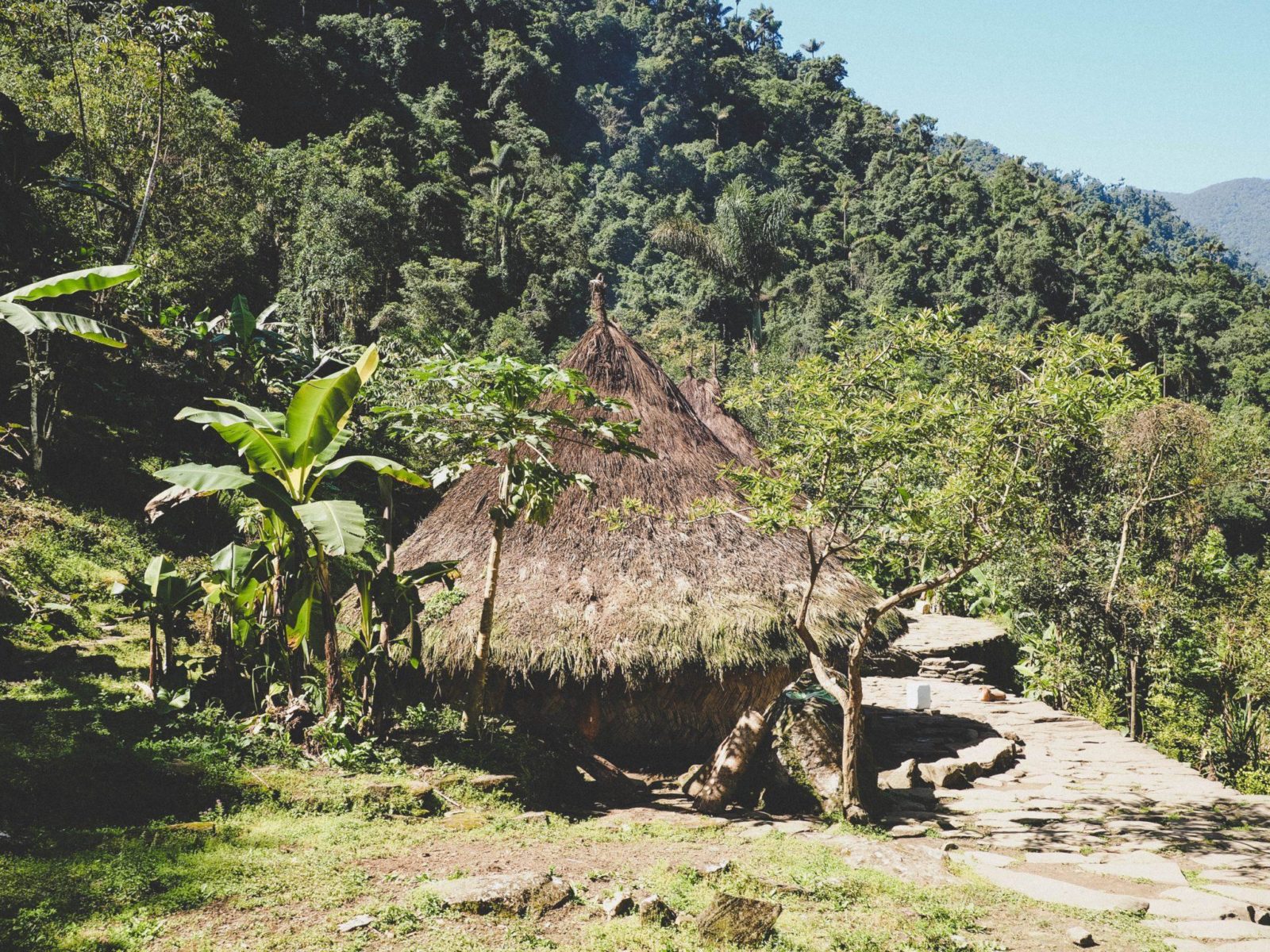
We then took some time to go for a swim before beginning the descent back to camp!
My ‘little’ accident
On my way back not long after leaving the camp, I fell pretty badly and I managed to sprain my ankle and twist my knee. It was a bit of a shock and I’m not going to lie I was pretty worried! Mostly because I knew I had another 22km to go and my only option other than walking was to get a mule! Having had many injuries as a dancer I’m well acquainted with ankle sprains so I knew my best bet was to get straight up and keep walking.
So that’s what I did. I activated my yoga breathing and just kept going. It was hard, I was in a lot of pain but Tomas stayed with me checking in and making sure I was OK. When I got back to camp I cried! I think part relief I’d managed to do it and part pain! I was worried about it swelling and not being able to walk the next day so I went to bed early with a tone of arnica and ibuprofen!
Because of my ‘little accident’, I was pretty nervous about today. Especially as I knew a lot of it was downhill (which was so much more painful than uphill). I’m pretty stubborn so I decided I was going to try and at least walk the first 3 hours back to camp 1 and after that, I would be able to get a Moto back. I did send my backpack on a mule for 20Mil though!
I was slow and careful and it wasn’t much fun. So I can’t really tell you much about day 4 as I spent most of it heavy breathing with my head down focusing on putting one foot in front of the other! When going uphill I felt nothing and dreaded going downhill. In some ways, I think my focus and breathing actually made it easier!
Anyway, after making it back to camp 1 I decided I had to finish this on foot or I would just be super disappointed in myself. So I just kept going! I may have been slow but I made it all the way back and felt so proud of myself. It wasn’t a terrible time either and I wasn’t the last in our group back surprisingly!
I got a round of applause from my group for making it, we all had a beer and another great meal before heading back to Santa Marta!
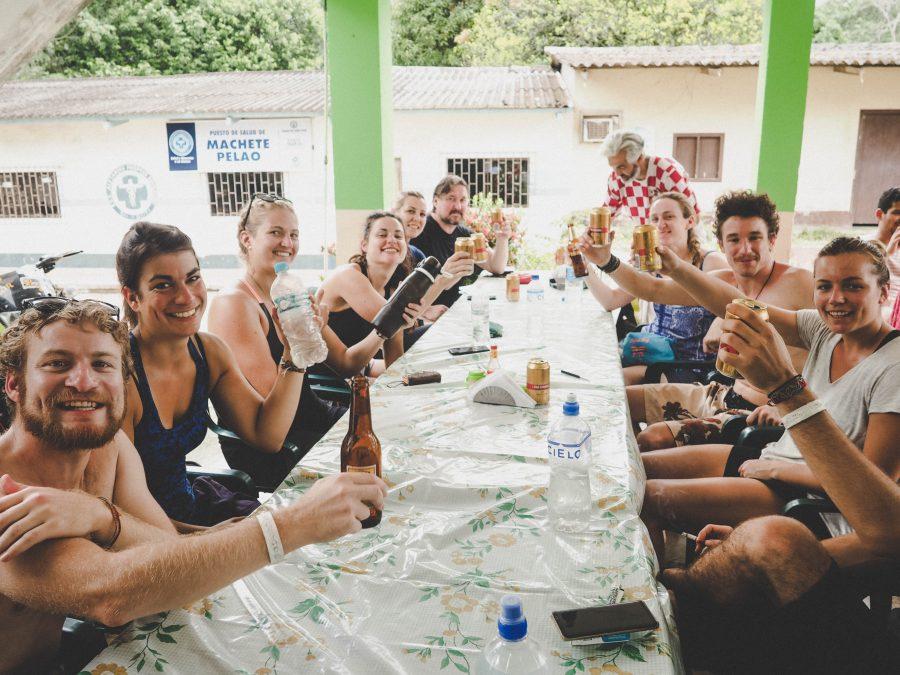
Final Thoughts
This hike was a huge challenge mentally and physically. But I LOVED it. Even with my injury. I’m also really glad I went with Magic Tour, once again they were incredible and I felt so well looked after by them. All of the groups have the same cost, they don’t all have this level of service though. If you are planning on doing the hike I highly recommend choosing them as your tour guides.
I hope this is helpful if you are backpacking in Colombia be sure to check out my other guides ! Also, you can follow my 1-week , 2-week , and 3-week Itineraries for the Caribbean coast .
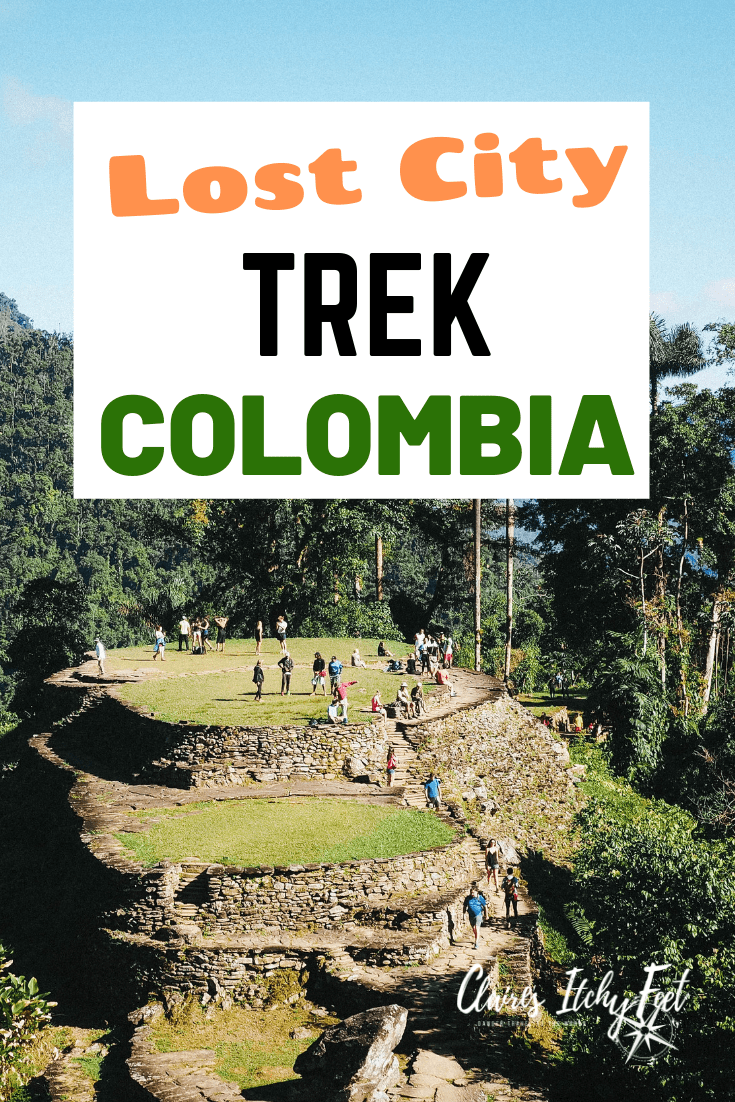
Looking for somewhere to stay in Santa Marta? Here are the places I personally recommend:
Rua Hostels
Hotel Nueva Granada
Arbore Hostel
Solaz Hostel
This post was proofread by Grammarly
Explore the Caribbean Coast of Colombia in two weeks - 197 Travel Stamps
Thursday 6th of September 2018
[…] the middle of the Sierra Nevada jungle, there are hidden ruins of the Ciudad Perdida, an ancient indigenous town built 800 years BC. Which makes it more than 500 years older than Machu […]
Saturday 11th of August 2018
Hello i really want to do this but im not going to lie i am out of shape. i did a hike in thailand and i thought i was actually going to die. i ran out of water and got really hot and little bit dizzy and my legs had no strength in it. out of breath hot etc. luckily i made it i pushed through as i had no choice but to keep going. is it possible to rent a horse or mule ? i know ill look like a big baby while everyone is hiking and im on the mule but honestly its the only way i can do this 4 day hike… i dont mind paying little bit extra for the mule so i can get this awsome picture…
Claire Summers
Honestly I don't think a company would take you. Mules and horses are there for people who get I injured. No company would take you on a mule. For a start just to get up to the lost city and then walk around it is very hard going due to all of the steps. So I would say no. Maybe use it as motivation to get in shape ?.
Stella Jane
Tuesday 27th of March 2018
This sounds like an incredible experience. I have never heard of the Lost City, but the name alone makes me want to go there. It seems like you absolutely picked the right tour company. I definitely agree that a bed is better than a hammock after a day of hiking.
Thursday 29th of March 2018
I know I would have been such a grump if I'd of slept in a hammock haha #princess
I too worry about health and safety when I do activities like this. So sorry to hear you sprained your ankle and knee. Luckily it was on the way back and happy to hear the response was quick.
I know! It's just my luck to do something like this. Glad I did it on the way back jaja
I can't believe I havent been to Colombia yet even though I am living in Ecuador. Would love to go soon. Would love to do the Lost City Trek, I might have to prepare for the hike here in Ecuador. So good you include the packing list, very useful for people who don't know how the climate will be like. I would love to do a hike that takes days, I havent really done that before. Thank you for all the tips :D
Haha I still haven't gotten to Ecuador yet!

Hi I’m Claire!
At 34 I sold all my worldly possessions that wouldn’t fit into 3 boxes or my backpack and hit the road.
I started Claire’s Itchy Feet to inspire women to pack their bags and travel more. With no plans to stop anytime soon I’m always looking for my next adventure be it attempting to surf or climbing a volcano I’ll try (almost) anything once!
© 2023 Claire’s Itchy Feet

Lost City Trek, Colombia – Complete Guide To The Legendary Ciudad Perdida
Tucked deep within the dense greenery of Colombia’s Sierra Nevada de Santa Marta, the Lost City, or Ciudad Perdida, remains one of the country’s most thrilling and lesser-known treasures. This ancient city, believed to be around 650 years older than Machu Picchu, offers intrepid travelers an unforgettable journey into Colombia’s rich history and lush landscapes.
For those who dare to step off the beaten track and venture into the heart of the jungle, the Lost City Trek reveals a world far removed from Colombia’s bustling cities and sun-drenched beaches.
This multi-day hike of about 22 km one way, 44 km in total takes you through challenging terrain, across rivers, and up steep inclines, rewarding you with a glimpse into an ancient civilization, spectacular views, and a profound connection with nature. An adventure that’s off the typical tourist radar, the Lost City Trek is a must for every seasoned explorer.
Despite having to hike on the same path to get to the Lost City and to come back (a loop is always nicer), it is truly one of the most beautiful treks I have done in South America, along with the Mount Roraima trek or the trek to Machu Picchu .
On this page, I will share my experience trekking to the Lost City, and share my best tips, as well as things I wish I had known before going. Let’s go!
GPS (Ciudad Perdida): 11°2’17.56″N, 73°55’30.55″W
How to go: Trek with a local travel agency in Santa Marta. I personally chose Expotur.
Cost of the trek: 1,150,000 Colombian Pesos (around US$280)
Duration of the trek: 4 days. 5 days is possible for the same price but doesn’t bring anything new, in my opinion, 4 days feels just right.
Trekking distance: 44 km (27 miles) in total.
Best season: December to April
Hotel recommendation in Santa Marta: Hotel Miami
The Fascinating History of the Lost City
Ciudad Perdida, literally translating to “Lost City”, is believed to have been built in 800 CE, making it a significant archaeological site that predates Machu Picchu by several centuries. It was once the heart of a network of villages inhabited by the Tairona, a sophisticated indigenous culture known for its intricate gold work and pottery.
The city was ‘lost’ to the outside world for centuries, hidden by dense jungle and the passage of time, until it was rediscovered in 1972 by local treasure looters, who stumbled upon the stone steps leading up to the city. After a period of looting and consequent archaeological restoration, the Colombian government opened the site to visitors in the mid-1980s.
The Lost City is considered sacred by the indigenous communities living in the Sierra Nevada, some of whom are descendants of the Tairona. Today, it serves as an important cultural and spiritual site, offering fascinating insights into the life and beliefs of its ancient inhabitants.
Comprising a series of 169 terraces carved into the mountainside at an altitude ranging from 900 to 1300 m / 3,000 to 4,300 ft above sea level, a net of tiled roads, and several small circular plazas, the Lost City stands as a testament to the engineering prowess of the Tairona.
The town is believed to have been home to several thousand people (some estimate around 2,000 people). Unfortunately, the Tairona and the Lost City did not survive the Spanish invasion. As you walk among these ancient ruins, surrounded by the sounds and sights of the living jungle, it’s hard not to feel a deep connection with the past.

Planning Your Trip to The Lost City
As an adventurer, the key to a successful journey is planning. And for a challenging trek like the Lost City, it becomes even more essential. Here are some crucial points to consider:
Best Time to Visit: The Lost City Trek can be done all year round. However, the dry seasons, from December to March and July to August, are generally more comfortable for trekking. These periods experience less rainfall, which can make the trails less muddy and the river crossings easier.
Getting to the Starting Point: The trek to the Lost City starts from the coastal city of Santa Marta. Direct flights to Santa Marta are available from Bogota, Medellin, and Cartagena. Once in Santa Marta, most trekking companies include transportation from your accommodation to the starting point of the trek in their packages.
Permits and Legal Requirements: All trekkers need a permit to hike to the Lost City. This is usually handled by your trekking company when you book your tour. In terms of health requirements, while there’s no compulsory vaccination for this region, keeping your routine vaccines up-to-date and considering vaccines for diseases like Typhoid and Hepatitis A is recommended.
Health and Fitness Considerations: The Lost City Trek is quite challenging, with long days of hiking, several river crossings, and some steep climbs. Sometimes under a very hot sun. Therefore, a reasonable level of fitness is required. Also, ensure to check with your doctor before the trek, especially if you have any underlying health conditions.

Choosing Your Trekking Company
For safety reasons and due to the area’s protected status, independent trekking is not permitted to the Lost City. You’ll need to join a guided group tour with an authorized trekking company. Here are some factors to consider:
Reputation and Reviews: Check the company’s reviews online, look at their safety records, and ask for recommendations from fellow travelers.
Group Size: Smaller groups tend to offer a more personalized experience.
Guide Quality: The quality of guides can significantly enhance your trek experience. Look for companies that employ knowledgeable local guides who can share insights about the culture, history, and wildlife of the region.
Included Services: What does the tour package include? Look for companies that include transportation from Santa Marta, meals, accommodation, entrance fees, and an English-speaking guide.
Responsible Tourism Practices: Ensure the company follows responsible tourism practices, respects local communities, and contributes to local economy.
From personal experience, I can recommend Expotur, which offers a great balance of all these factors.

Can I Do The Trek Alone?
No. The Lost City Trek is a guided trek, it is illegal to go on your own. And honestly, I don’t really see the point of going alone. Such a trek requires quite a bit of logistics and it’s nice to just focus on your hike and discovering the landscape, without worrying about all that stuff.
I find the price very reasonable, and you get everything included except drinks outside of the camps or small extra snacks you might want to buy. You get access to the camps with a bed and a shower, the food is good, the guides are friendly…
And you get to meet other trekkers from all over the world, from your own group but from other groups as well when you spend the night at the same camp.
Moreover, no one forces you to hike as a group. I know I am a fast hiker and I was often in front of the group walking either alone or with a few other fast movers. It’s fine. So go ahead, book your trek with an agency and enjoy!
Is The Lost City Trek Safe?
Yes. I know Colombia has some kind of reputation, but the Lost City Trek is safe. In 2003, 8 tourists were kidnapped at the Lost City by guerilla groups but this is a remote memory. Nowadays, the Lost City is guarded by the military and the guerillas no longer operate in the region.
So now you only need to pay attention to not get a heat stroke and be careful while bathing in the river if the flow is strong.

Detailed Day-by-Day Itinerary for The Lost City Trek
Day 1 – santa marta → machete → adán camp.
- Minivan: 63 km (39 mi), 2 hours
- Hiking: 8.3 km (5.17 mi), 3:15 hours
Machete, 63 km west of Santa Marta, Colombia. It was in this village that I got to know the group of people I was about to share this adventure with, with a nice lunch. We didn’t know it yet, but it was also the last time we would be dry, and wearing dry clothes in 4 days! On the first day of the trek, the goal is to reach the Adán Camp. That’s an 8 km / 5.2-mile hike, more or less.
This first day is, in my opinion, the hardest of the trek. The culprit? A really sweltering heat that surely doesn’t help when you need to climb challenging, long steep slopes. The result: all your clothes quickly get drenched in sweat. And they will stay that way for the whole trek (bring enough clothes!).
VIRTUAL TOUR – Lost City Trek, Day 1
Cross the sunny countryside in the Sierra Nevada de Santa Marta mountains (6 panoramas).
The virtual tour opens in a lightbox. Use your mouse to move around the 360° panoramas.
The thing is, on the first day, you need to cross the countryside, and this heat is the direct result of the heavy deforestation that took place in this area. Not many trees are left to provide some shade and keep some “coolness”. The whole day, I bet everyone kept thinking of the wonderful natural pool awaiting us near the camp to escape the heat!
Nevertheless, the scenery is already stunning as we keep getting closer to the Sierra Nevada de Santa Marta mountain range, with its mysterious peaks hidden in the clouds.
After three and a half hours of hike in the countryside and a bit of jungle, you will arrive at the Adán Camp, nicely located next to the Río Honduras. Before dinner, your long-awaited reward is now within reach: jumping in a natural pool in the Honduras River, surrounded by jungle. It’s the perfect way to get rid of the sweat covering your body!

Day 2 – Adán Camp → El Paraíso Camp
- Hiking: 14 km (8.7 mi), 7 hours
The program for this second day is to first walk no less than 14 km / 8.7 miles to reach the Paraíso Camp, which is the closest to the Lost City. The lunch break takes place at another camp, the Mumake Camp, conveniently located exactly in the middle of today’s hike. So you hike for 3:30 hours in the morning, and 3:30 hours in the afternoon.
This day is also an opportunity to learn about the Kogi and Wiwa tribes, which have survived the Spanish Conquistador invasion, unlike the Tayronas. They are trying hard to preserve their culture and their lifestyle, and are not always too happy about getting more and more trekkers crossing their land – but they do get involved in the tourism economy and they are able to make some money out of it.
VIRTUAL TOUR – Lost City Trek, Day 2
Explore the jungle and cross rivers on your way to Paraiso Camp (11 panoramas).
On this second day, you leave the countryside to really penetrate into the rainforest, enjoying the most welcome shade from the trees. Some of the mountain views are really stunning! Untouched forest and mountains as far as you can see. As you slowly gain altitude, the heat becomes more and more bearable. The Lost City is perched at 900 to 1300 m / 3000 to 4300 ft above sea level.
Most of the trail follows the course of the Río Buritaca, and the Paraíso Camp was built on its bank. It is a really privileged environment to relax in, surrounded by untouched nature, with the sound of a small waterfall nearby.

Day 3 Morning – El Paraíso Camp → Visiting The Lost City
- Hiking: 850 m (0.53 mi), 45 min to the Lost City
Finally! The legendary Lost City is now (almost) within our reach! From the Paraíso Camp, a last small effort of 1200 steps is needed to get there.
As soon as I arrived at the site, I saw something very different from what I had imagined. Before going, I was just imagining a few small terraces lost in the jungle – I soon realized that it is much more extended than that.
But what I did imagine correctly is the incredible view of the Sierra Nevada de Santa Marta, still largely untouched. When you think about it, it is often the surrounding scenery that makes an archaeological site stand out. It is the case for Machu Picchu for example, and it is also the case for the Lost City.
It is fascinating to imagine the Tayrona people building all this and living in these mountains. The site is divided into two main parts, linked by a really beautiful stone staircase. When you reach the furthest, most elevated terrace, the view of the whole archaeological site and the forested mountains around is unforgettable.
VIRTUAL TOUR – Ciudad Perdida
Visit the fascinating Lost City or Ciudad Perdida, with a fantastic view of the mountains around (10 panoramas).

Day 3 Afternoon – El Paraíso Camp → Mumake Camp
- Hiking: 6.8 km (4.23 mi), 3:30 hours
After walking 22 km to the Lost City, it is now time to walk this 22 km back to Machete. If we had to find a negative aspect of the Lost City Trek, it would be that we take exactly the same path to go to the Lost City and come back, instead of making a loop for example. However, I wouldn’t consider it to be a really negative aspect – the landscapes are gorgeous enough for you to bear seeing them twice!
We had been lucky with the weather so far but in the afternoon of the third day, thunderstorms burgeoned and before we knew it, we got caught in an insanely heavy rain only the tropics can produce.
VIRTUAL TOUR – Lost City Trek, Day 3 (Way Back)
Walk back towards the countryside, with misty mountains after the rain (2 panoramas).
As I was always among the fastest-moving hikers, I was lucky to arrive at the next hut just as the heavy downpour started. And I just watched the other people in my group arriving slowly, under the heavy rain. A good rain poncho and backpack cover are important!
As a result of the rain, the once swimmer-friendly rivers were in spate, violent and muddy. As for the mountains and jungle, they were caught in an elegant mist.
At the end of the day, we got back to the Mumake Camp, where we had lunch on the second day. This time, we got to spend the night there.

Day 4 – Mumake Camp → Machete → Santa Marta
- Hiking: 15.5 km (9.63 mi), 6-7 hours
- Minivan: 63 km (39 mi) ⁝ 2 hours
After a good night at the Mumake Camp, we crossed back the overheated countryside to Machete, and the trek was over! Exhausted and sweating but feeling happy and satisfied with what I had just accomplished, I was sitting at the restaurant in Machete, watching the new batch of hikers getting ready for the trek, all fresh and dry, thinking “if they knew all the heat, the sweat and the slopes that are awaiting them…!”.
VIRTUAL TOUR – Lost City Trek, Day 4 (Way Back)
Last hike in the pretty countryside before the end of the trek (1 panorama).

TRAVEL MAP – Lost City Trek
Visualize on the map the positions of the virtual tours’ panoramas, the camps, and the huts where we could buy cold drinks along the way to prepare for your trek to the Lost City.
Click Here to View The Map
The map opens in a lightbox. Zoom in to explore!
What to Expect on the Trek
The Lost City Trek is a journey like no other, teeming with awe-inspiring views, challenging terrain, diverse flora and fauna, and a fascinating dose of ancient history. When you sign up for a trek, it’s not always easy to know what to expect in terms of organization, local weather, or infrastructure. So let’s see what the Lost City Trek looks like.
It departs from your agency’s office in Santa Marta and starts with a 2-hour drive to a small town called Machete. It is a 4-day trek, from Machete to the Ciudad Perdida. You will be using the same path to go and come back, and each way is about 22 km / 14 miles long.
In the detailed itinerary above, I wrote the hiking distance and hiking time for each day. Of course, it can be a little longer or a little shorter depending on how fast you walk. But the most you will have to walk in a day is about 7 hours.
Terrain and Trail Conditions
The path to Ciudad Perdida is a mix of jungle trails, river crossings, and stone steps. You will traverse through muddy paths, cross crystal-clear rivers, hike up steep inclines, and descend slippery slopes.
The most challenging part is the 1,200 ancient stone steps leading to the Lost City itself. Remember, it’s not a race; take your time and travel at a pace that suits you.
Altitude and Weather Conditions
The trek reaches a maximum altitude of around 1,300 meters (4,265 feet), so altitude sickness is generally not an issue. Weather in the Sierra Nevada can be unpredictable. Expect warm, humid days and cooler nights.
Rainfall can occur even in the dry season, making parts of the trail muddy and slippery, but the rain also brings a beautiful mist that adds to the mystical allure of the journey.
Flora and Fauna
The trek takes you through the dense jungle of Sierra Nevada, home to a staggering diversity of flora and fauna. Expect to see towering Ceiba trees, bromeliads, orchids, and numerous other plant species.
In terms of wildlife, it’s common to spot monkeys, colorful parrots, and butterflies. With a bit of luck, you might also catch a glimpse of a spectacled bear or a jaguarundi, although these sightings are rare.

Accommodations and Meals
Staying in the middle of the jungle after a day of challenging trek is an experience in itself. Here’s what you can expect:
Accommodation
During the trek, you’ll stay in a series of rustic campsites situated along the trail. I didn’t really know what to expect from the camps. Will they be small? Big? Comfortable? Or just an old hammock between two trees?
They are actually much bigger and more developed than I imagined. All the camps have a dormitory area with two levels of beds, each with a mosquito net.
Each camp also has flushing toilets and simple showers, and also a “restaurant” area with a kitchen and large tables. The camps are built along rivers and most people enjoy a nice swim after a long day of hiking.
Meals and Drinks
Along the way, wooden huts were built allowing trekkers to take a break, buy cold drinks and enjoy some fresh juicy fruits. Make sure to bring enough cash with you , in these shops, the drinks are overpriced (5000 pesos – double the normal price) but you will still need to buy them because it’s very hot and you will be incredibly thirsty. And well, you probably pay for the fact that all these bottles had to be brought all the way there as well.
Meals during the trek are typically included in the tour package. You’ll be treated to a variety of Colombian dishes prepared by the camp cooks. Expect lots of rice, beans, plantains, and meat.
Breakfast might consist of eggs, arepas (Colombian corn cakes), and fresh fruit. Make sure to inform your trekking company ahead of time if you have dietary restrictions or allergies.
Remember, you’re here for the adventure, and while the accommodations and meals may be basic (but they are often tasty), they are part of the overall trek experience. Plus, falling asleep to the sounds of the jungle is truly magical.

What To Pack for Lost City Trek
The Lost City trek is marked by a lot of heat… and very high humidity. One thing I wish I had known before is the necessity to take 2 pants. At first, I was thinking that pants were heavy, I would just wear the same pants for 4 days and be a little dirty, never mind.
The thing is, after the first day, your pants are already drenched in sweat. On the first night, it dried a little so it was still okay to wear the next day. But at El Paraiso Camp, the air is not only extremely humid but also quite cool: nothing dries at all .
I just couldn’t wear my pants anymore and ended up finishing the trek with my swimming shorts! That’s all I had left. So better bring 2 hiking pants, quick-drying ones preferably.
As for t-shirts, it is also good to have one that you will keep clean and dry to wear only at night after shower (+ on the 4th day going back to Santa Marta). If you absolutely need to change your shirt every day, take 4, but I think you can do with 3. Again, every bit of weight you can avoid will be greatly appreciated by your shoulders.
As for the shoes, of course, you will need good trekking shoes or boots. My personal preference is hiking boots because I like my ankles to be supported, but the trails are pretty clean and hiking shoes are probably enough if that’s your preference.
Packing Checklist
When packing for the Lost City Trek, keep in mind that you will have to carry everything you bring, so it’s best to pack as lightly as possible. 4 days is pretty short so I recommend trying to squeeze everything in a smaller backpack instead of carrying a big one. Here are some essential items to include:
- Lightweight, quick-drying clothing: The weather can be unpredictable, and it’s likely you’ll get wet either from sweat, rain, or river crossings. If you haven’t, read what I wrote above. Pack enough clothes! Your shirts and pants will NOT dry during the night.
- Good quality hiking boots: A pair that is already broken in will serve you best.
- Rain jacket or poncho: Rain can occur even in the dry season.
- Swimwear: You’ll have opportunities to swim in rivers and natural pools.
- Hat, sunglasses, and sunscreen: Protect yourself from the tropical sun.
- Insect repellent: The jungle is home to a variety of insects.
- Water bottle: Hydration is crucial during the trek. Pick a reusable bottle to reduce plastic use.
- Personal first aid kit: Include items such as band-aids, antiseptic wipes, and any personal medication.
- Snacks: Though meals are provided, it’s a good idea to bring some extra energy bars or nuts for the trail.
- Torch or headlamp: This is essential for navigating the campsites at night.
- Cash: For buying snacks or drinks at some of the campsites along the way. Vital!
Remember, packing light is the key. Most tour operators provide a more comprehensive list of recommended items to bring, so ensure you check that out too.
What To Do With The Rest of Your Luggage?
Don’t worry, your agency will most probably have a dedicated, secure place to store your things while you are on the trek. So I was backpacking with my main, bigger backpack across Colombia and a smaller backpack where I usually put my electronics.
I simply used this smaller backpack for the trek and left my main backpack at the agency in Santa Marta.

Tips and Important Info for the Lost City Trek
The Lost City Trek is an adventurous undertaking that will reward you with lifetime memories. To make the most of this experience, here are some tips and important things to know:
- Fitness Level: Be aware of your fitness level. The trek is demanding, and being in good physical condition will significantly enhance your experience.
- Stay Hydrated: With the hot and humid conditions, it’s vital to drink plenty of water to stay hydrated.
- Respect the Environment: Remember, you are a guest in this ancient place. Always follow the ‘leave no trace’ principles – dispose of waste properly, stay on the trails, and respect wildlife.
- Respect the Indigenous Communities: The trek passes through indigenous territories. Respect their customs and privacy, and always ask before taking photos.
- Safety: Listen to your guide’s safety instructions, especially during river crossings. They are experts and know the terrain well.
- Pace Yourself: It’s not a race. Enjoy the journey, take in the views, and give yourself time to acclimatize to the heat and humidity.
- Bring a Sense of Adventure: Lastly, keep an open mind and a flexible attitude. Things might not always go as planned, but that’s all part of the adventure!

Dos and Don’ts for the Lost City Trek
Embarking on the Lost City Trek means journeying through ancient lands and indigenous territories. Therefore, it’s essential to approach the trek with the utmost respect and sensitivity. Here are some essential dos and don’ts to bear in mind:
- Respect Indigenous Cultures : Understand that you’re passing through the ancestral lands of indigenous tribes like the Kogi and Wiwa. Greet them if you come across any, but allow them their space and privacy.
- Follow the Trail : Stay on marked paths to minimize the environmental impact and to respect the sacred sites.
- Dispose of Waste Properly : Carry all your trash and dispose of it appropriately. Consider carrying a small bag for this purpose.
- Listen to Your Guide : Your guide knows the region, its customs, and safety precautions. Always heed their advice.
- Wear Appropriate Attire : When visiting indigenous villages, dress modestly out of respect for their customs.
- Disturb Wildlife : Remember, it’s their home. Maintain a safe distance and avoid feeding or teasing any animals.
- Take Artifacts : It might be tempting, but taking stones or artifacts from the Lost City is not only disrespectful but also illegal.
- Photograph Without Permission : Always ask for consent before taking photos, especially of the indigenous people.
- Leave Behind Plastic : The Sierra Nevada’s ecosystems are sensitive. Avoid using single-use plastics, and if you must, ensure you pack them out with you.
Frequently Asked Questions
The trek typically takes 4 to 6 days round trip, depending on the tour operator and pace.
Absolutely! Many trekkers find it a rewarding experience, offering a combination of lush jungle scenery, river crossings, and ancient archaeological ruins.
Both treks have their challenges, but the Lost City Trek is generally considered more rigorous due to its humidity, consistent ascents and descents, and river crossings. However, it’s shorter and at lower altitudes than the Inca Trail.
Some operators offer accelerated 3-day treks, but these are strenuous and leave less time for exploration and acclimatization.
The best time to trek is during the dry season, from December to March, and from July to August.
Hiking boots are recommended for their grip, ankle support, and protection against elements like water and mud.
While you can wear sneakers, it’s not recommended due to potential wet conditions, slippery trails, and lack of ankle support.
The entire trek covers approximately 44 kilometers (27 miles) round trip.
It’s advisable to wear water-resistant hiking boots with good grip and ankle support.
Physical preparation includes regular cardiovascular exercises, strength training, and practice hikes. Also, familiarize yourself with the itinerary, gather necessary gear, and get vaccinations if required.
No, solo treks are prohibited for safety reasons and because they take place on the ancestral lands of the Kogi and Wiwa tribes. You must go with a registered tour operator.
You’d typically fly into Simón Bolívar International Airport in Santa Marta, the closest city to the trek’s starting point.
Both 4-day and 5-day treks are available, with the difference usually being the pace and time spent at certain sites. I feel that 4 days is just nice, one extra day would just give you some time to relax at one of the camps.
There are around 1,200 stone steps leading up to the Lost City itself.
The highest point on the trek, the Lost City, sits at approximately 1,200 meters (3,937 feet) above sea level.
The total elevation gain varies based on the specific route, but you can expect around 1,100 meters (3,600 feet) from the starting point to the Lost City.
Final Thoughts About The Lost City Trek
The Lost City Trek is more than just a hike; it’s a journey through time, offering a rare glimpse into the ancient civilizations that once flourished in the heart of the Sierra Nevada.
The breathtaking landscapes, the rich history, and the interactions with the indigenous tribes make this one of the most unique treks in the world. And you get to meet a lot of really cool people!
This trek is in my opinion a must-do in Colombia if you enjoy the outdoors, and one of the top treks in South America. The Ciudad Perdida may not have the beautiful stone houses and temples of Machu Picchu, but it is a really mysterious and fascinating archaeological site and totally deserves to be discovered.
However, with such privilege comes the responsibility to tread lightly, respecting both the land and its people. Approach this adventure with an open heart, a keen sense of respect, and a genuine curiosity. The Lost City awaits, not just as a destination but as a profound experience that stays with you long after your boots are off and you’re back in the comfort of your home.
Julien is an exploration-minded, curiosity-driven traveler and blogger. On a mission to witness the planet's natural beauty and diversity, he shares his experiences on this website through articles, videos, and photography, including interactive virtual tours.
Fascinated by animals and plants since young, he is also fond of outdoor and so-called extreme sports, often discovered while traveling and practiced back at home where he focuses on improving his knowledge and skills - so he can explore further on the next trip!
More About Me

You May Also Like

Meet The National Animal of Colombia, The Andean Condor

Cartagena, Colombia: Colonial Charm And Violent History

All About Colombia’s National Flower: Cattleya trianae

Discover Colombia’s National Tree: The Wax Palm

All About Colombia’s National Fruit: The Borojó

34 Things Colombia Is Known and Famous For
28 comments.
Jo from woody world packer
This looks like a very interesting trek! Although Colombia might hold me off a little bit with the current situation ( especially because we travel with our 2 year old son ) The nature looks amazing though! Love what you did with your visuals! Great informative article!
Thank you for your kind words! Colombia not as risky as it was before, but I understand your concerns. I think the Caribbean coast is generally safe to travel.
What an adventure! I’m glad you mentioned what is loading in your blog. The pictures and panoramas were totally worth it! I think it’s always fun to read about people’s experiences on long treks, because I think we often forget the trek back!
Thanks a lot Rachelle, glad you enjoyed it!
What amazing panoramas. I haven’t been to Colombia, but these pictures could convince anyone. There is so much tranquility from the photos!
Thanks Victoria, you are right Colombia is a fantastic country that deserves to be discovered and the scenery is amazing
Lucy - Travel Textbook
This is such a comprehensive guide!! Love the virtual tours too, so cool.
Really hope to make it to Colombia one day 🙂
Thank you Lucy, you should definitely put Colombia in your bucket list!
this is amazing! it looks like fun and adventurous at the same time. hopefully could make it to do this as well one day. 🙂
Indeed Marya, a really cool and adventurous experience, I wish you to do it too!
Renata Green
I’ve been to Colombia this spring, so this post brings back wonderful memories. But I’m sooo jealous that you hiked to the Ciudad Perdida. I would so love to do it, but I know that I would collapse, since I found already other hikes in Colombia that probably would make you laugh (like Parque Tayrona) very tiring. BTW – Santa Marta was one of my favorite places: ideally located, a tad bit touristy, but still very laid-back and authentic.
Haha well it was a challenging trek, but I am sure Parque Tayrona is beautiful too, I didn’t even have the time to go there!
Omg! this panorama pic are amazing – fantastic blog post, I haven`t seen something like this before, I felt like beeing just inside the deep jungle.
Thank you Martina glad you enjoyed it!
Angela @ Dang Travelers
This sounds like an amazing adventure! We are always looking for good hiking trips so this is right up our alley. I agree with you on the loop, I usually don’t like to backtrack but rather see new things on the way back. Oh well, that scenery is worth a second look!
Hi Angela, it’s true that a loop would have been nice but on the way back it was rainy in the mountains, which gave the landscape a different atmosphere
Thanks for putting together such a useful guide, it looks like a huge amount of work but I am sure it will help lots of us planning to visit the area.
Thank you Paula, it was a pleasure to create this article 🙂
Wow, that looks like a tough hike. I like the panoramic view walk-throughs that you’ve done, I haven’t seen that on any other blog.
Thanks Amy! It was a tough hike, and the heat was really crazy, but the experience is well worth it!
Rye Santiago
I guess it’s not perdida anymore. It’s becoming more and more known among adventurous travelers. I might consider going there when I visit Colombia for 6 months next year. 🙂 I heard that mosquitoes were a big problem there. Was it ever like that when you went there?
Hey Rye, it’s indeed less and less perdida, but still an amazing adventure! I definitely recommend it. I don’t know in what season you intend to go there, but I did it in April and I don’t recall the mosquitoes being a really bad issue, if you put repellent. Also all the beds have mosquito nets. The real challenge in my opinion was the heat, particularly on the first day. But again, in other times of the year the conditions might be different.
This trek looks amazing! I never thought of Columbia as a place to go hiking. Also, enjoyed your use of 360 images.
Thanks Mary! Colombia is an amazing country for hiking, and this trek is just one among many wonderful possibilities.
The panoramic views are really incredible. Greenery is in abundance. Loved the waterfalls, the tiny huts, and the beautiful tribal kids. cheers!
Thank you! The jungle is amazing and the Kogi people are a very interesting community to discover.
This looks a wonderful adventure. Never read about this place before though but looks like one must visit this beautiful destination for sure.
It is for sure a great adventure, and a must-see, probably Colombia’s major archaeological site.
Leave a Comment Cancel reply
Notify me of follow-up comments by email.
Notify me of new posts by email.
Lost City trek Guide: All you need to know before going
What is it and where is ciudad perdida.
Ciudad Perdida (Lost City), as one can sense from its name, it is a city that was found barely 50 years ago, buried under the dense jungle of Sierra Nevada in Santa Marta, in the north west of Colombia. It consists of a series of circular terraces made of stone and built at different levels, connected to each other through walls and stairs. Once, these terraces were filled with houses made out of wood, clay, palm trees and vines by a group of indigenous known as Tayrona. The Tayrona culture built Ciudad Perdida 600 years before Machu Picchu even existed and it is known its population reached up to 2500 indigenous.
History states that in 1976, after 400 years in oblivion, the “huaqueros” (treasure hunters) that went after the abundant gold in Colombia, discovered Ciudad Perdida by chance. But once they set foot in it, they made off with everything they could, as they found abundant treasures buried under each terrace.
How to get to Ciudad Perdida?
The option of doing the trek to Ciudad Perdida on your own, is off the table. The track to access the Lost City passes through some private lands owned by the indigenous. They are very protective of their land and have the power to limit the access to the jungle. Therefore, there’s no other way to visit than booking a guided tour with an agency.
There is a limited number of companies that offer tours to Ciudad Perdida, five to be precise: Expotur , Magic Tour , Guías y Baquianos Tour , Wiwa Tour y Turcol . You can book your tour either through their website or physically at each operator’s office in the city of Santa Marta. If you book online, you’re going to need to pay a deposit and once you get to the physical office you’ll have to liquidate the rest in cash or with credit card.
There are daily tours to Ciudad Perdida, which gives you a lot of flexibility when it comes to decide when to go and how many days to spend.
What agency should I choose?
As the number of agencies offering the tour are limited, they all have a standard price, so as to avoid competition. Therefore, money won’t break the decision for you. Almost all agencies offer the same services, as there is only one track to the Lost City. Everybody sleeps in similar camps, eat the same kind of food and cross the same rivers with the same resources.
There are two agencies that perhaps stand out from the rest. Wiwa Tour for instance, in which the guides are indigenous from the Wiwa tribe. At first sight, it seems quite an attractive choice, isn’t it? Who better than them will tell you about the story of Sierra Nevada and will show you the jungle where they were raised? Apparently though, the Wiwa’s can’t speak Spanish very well, not to mention English, and an experience that would seem so enriching at the beginning, wouldn’t be so in the end.
Then, there’s Guías y Baquianos, which claims to be the pioneer agency to bring tourists to Ciudad Perdida, and therefore the most experienced in this matter.
Still, we chose Expotur because of all the positive references we read all over the Internet. And it didn’t let us down. The tour was very well organized, perfect timings, good and abundant food, very interesting conversations with the guide… Camacho, our guide (who spoke Spanish), it is native from Machete Pelao, the little village where the trek starts. He knew everyone around the area, he was saying hello to everybody that passed by during the 4 day trek. He seemed like a very loved person, you can tell he likes what he does from the passion he puts when explaining anything.
What is included with the price?
At first sight it may seem a bit expensive, but when you break it down to a list of services they offer, it seems pretty reasonable. The price is the same whether you make the trek in 4, 5 or 6 days and includes the following:
- Luggage storage service at their offices.
- Round trip with SUV from your accommodation to El Mamey.
- Entrance fee to the Teyuna Archaeological Park.
- Breakfast, lunch and dinner during all the days that the trek lasts.
- Fruit and snacks every journey.
- Purified water in every camp.
- Accommodation in bunk beds with mosquito nets.
- 24h guidance during all the days the trek lasts.
- 24h translation during all the days the trek lasts.
- Travel insurance.
- Contribution to the communities. Part of the money goes to the indigenous communities, to support the development of their region and to improve their life quality.
The price does not include:
- Alcoholic beverages → you can buy beer at the camps.
- Mule service → if your shoulders can’t take your bag anymore, you can hire a mule service to transport your luggage to the next camp.
How many days do I need?
The Lost City trek can be completed in 4, 5 or 6 days. The price is exactly the same in any case. The way to the Lost City is the same for everyone, on day 3 you reach the Lost City, and the difference is on the way back. Those who plan to stay for 5 or 6 days will sleep one or two more nights on their way back, so as to walk less distance each day.
If you’re in good shape I recommend completing it in 4 days. Specially if your time in Colombia is limited, otherwise you will invest too many days in the trek. Also, because it is not a circular route. You have to go and come back on the same trail, and this makes the way back not that exciting as the previous 3 days, as you have seen it all already. If on the contrary, your physical state is not that good, you can make the trek more calmly in 5 or 6 days.
If you wish, in the next link you can read my personal experience on my 4 day trek to the Lost City .
What to pack for Ciudad Perdida?
Essentials:
- 1-2 liters of water for each journey
- Trekking shoes
- Quick dry clothes (4 t-shirts, 2 shorts, underwear and 6 pairs of socks)
- Long sleeves
- Toiletries (toothbrush & toothpaste, deodorant, shampoo, comb, etc).
- Insect repellent
- Solar protection
- Bathing suit
- Quick dry towel
- Basic First Aid Kit (plasters and Betadine, paracetamol, antibiotic and anti-diarrhoea).
If you want more detail you can check my article on What to pack for Ciudad Perdida?
Where can I leave my big luggage?
It doesn’t matter what agency you make the trek with, they all have a storage facility for that luggage you don’t need to bring to Ciudad Perdida. In my case with Expotur, we left the luggage in a flat adjacent to their office. There, we left our big bags on day 1 and there we collected them on day 4.
Another option would be to ask at your hostel/hotel if they can keep if for 4 days (as long as you return to the same accommodation after the trek). Otherwise, the wisest choice is to leave it at the travel agency.
¿Is it hard?
The trek to Ciudad Perdida is not difficult or dangerous, and anybody can do it. That being said, it’s always helpful to be in good shape. After all, we are talking about a 60 km trek (roundtrip) with an incline of 3000m. Personally I think though, the difficulty is added by the weather conditions: humidity up to 85%, fierce mosquitoes, downpours, fast-flowing rivers, a blazing sun and all that in just one day.
There will be times when you’ll be climbing up a hill for an hour under a burning sun, then the next minute you’ll be walking under a heavy rain with mud up to your knees. You will need to cross the Buritaca river 18 times (9 times in each direction) and the water level can rise within minutes, so be prepared to take off your boots every now and then.
The trek can be completed in 4, 5 or 6 days (for the same price), so the more days you spend, the less kilometres you’ll walk each day. So, all in all I wouldn’t consider it a hard trek but a nice trek with hard weather conditions.
¿When is the best season to go?
Colombia has dry season and wet season. The dry season runs between December and March and the most rainy season runs between October and November.
Each season has its pros and cons. During high season it doesn’t rain, but the number of tourists doubles. There’s a possibility that the camps are full and you need to sleep on a hammock instead of a bunk bed, and there might be a line to take a shower.
During low season it rains, but there’s not that many people, so the experience is more authentic. In our case, we had to travel in November in the middle of rainy season. It rained every afternoon/night, but never during our walk, so we were lucky! And our group, instead of being 30 people, we were only 11. So I was quite glad to have done this in November.
In September the Lost City remains closed for maintenance. The indigenous carry out some rituals in order to clean the city from the tourist bad energy.
¿What am I going to eat?
If something is abundant in the trekking to the Lost City, in addition to mosquitoes, that’s food. There’s a cook assigned to each. He also makes the trekking, carrying all the food, and he usually leaves 1h before us, so when we arrive at our destination, the food is almost ready on the table.
Breakfasts consists of fruit, eggs, toasts, coffee or juice. During the walking journey there’s always a nice surprise such as “pit stops” with fruit.
Lunch and dinner are quite abundant and with vegan options (you need to mention at the agency if you are vegan or vegetarian). There’s pasta, fish, meat, rice, “patacones”, salad…
Occasionally they gave us some treats such as popcorn or chocolate bars that I always saved for the next journey.
¿Can I get water on the way?
Yes, you can get water on the way. All along the way you will find stalls and even people with a portable fridge, selling water and other kinds of drinks. You can also buy water in any camp.
On the very first day, when leaving Santa Marta on the SUV, you need to bring your own water. But during the trek you will find tanks with purified water in each camp. Every agency owns a water tank with water purification tablets, for you to refill your bottle.
Me, personally I have a delicate stomach, and I only drank bottled water. I used to buy it every evening in the camp, for next day journey. And if I ran out of water at some point I waited to find a stall to buy it.
If you have a good stomach, you should be fine with refilling your bottle at the camp.
¿How are the facilities?
In the Lost City trek you will sleep in camps that you’ll find along the way in the middle of nature. The camps are built in wood with metallic roofs.
In every camp you will find an area with bunk beds and hammocks, another area with long tables for eating, and another area with showers and toilets. There are actual toilets in every camp, not a whole in the ground.
All bunk beds have their own mosquito nets around it, so not one insect sleeps with you. In the very first camp there were pillows, but we didn’t find them in the rest of camps.
Almost every camp has some socket for you to charge whatever you need, although not that many sockets.
If you are interested in knowing more, you can check the following posts on the Lost City:
- What to pack for the Lost City
- Lost City trek itinerary: 4-5 days trek
Are you planning a trip or getaway?
Some tips and links that might be of your interest:
Accomodation: Accommodation for all budgets .
Flights: Book cheap flights .
Activities: Book the best tours and activities .
Share this post
Related posts.

Best Ciudad Perdida (The Lost City) Tour Companies
Search 4 Ciudad Perdida (The Lost City) tour operators and travel companies, with 108 reviews.

Exodus Travels
Health Safety +
Featured Ciudad Perdida (The Lost City) Trips

G Adventures

Wiwa Tour Colombia

4 match your criteria (1 - 4 shown)

View Ciudad Perdida (The Lost City) trips
Plan your Ciudad Perdida (The Lost City) trip
Ciudad Perdida (The Lost City) Reviews & Ratings
The lost city of chocquequiaro.
This is a challenging hike. The altitude makes the steep ascents and descents very demanding. But the scenery and the access to Inca sites that aren't crawling in...
Fascinating trek
A strenuous but rewarding trek, topped off with some fantastic sightseeing, and of course Machu Picchu! Great diversity of microclimates during the trek, as well as...
It was a difficult trip for me, but the support of the Exodus staff made it an excellent experience. I think the final hike up to Llactapacta, and the realization t...
Peru adventure
A challenging trek in Peru that managed to combine quiet trekking, magnificent scenery, the remote city of Choquequirao and the spectacle of Machu Picchu. Walking ...
Excellent trip
This is one of the best trips I have done. This was my first visit to South America - Peru is a beautiful country with fascinating history. The trekking is hard ...
See all Ciudad Perdida (The Lost City) reviews
Trip planning
You are using an outdated browser. Please upgrade your browser or activate Google Chrome Frame to improve your experience.

- Lost City Trek (4 days)
- Lost City Trek (5 days)
Lost City Trek (6 days)

Come and discover the Lost City of Colombia.
You can choose your hike intensity according to your capabilities or the number of days you want to spend in contact with nature., a unique and amazing experience that you will never forget, you can choose your hike intensity according to your capabilities or the number of days you want to spend in contact with the nature., what is included in the lost city tour.
ACCOMODATION
The accommodation during the tour is in hammocks, beds or tents, depending on availability. We provide mosquito nets and blankets.
Typical food prepared by local chefs and fruits and snacks during walks.
TRANSPORTATION
Round trip transfers from the hotel or where you stay to the starting point of the tour (El Mamey) in 4WD vehicles.
Our professional guides are from the region trained by SENA, with years of experience.
TRAVEL INSURANCE
During the Lost City Trek, you will have a medical assistance insurance that cover accidents and illness occurred during the tour.
ENTRANCE TO THE ARCHAEOLOGICAL PARK
During the Lost City Trek, you will have medical assistance insurance that covers accidents and illness occurred during the tour.
Lost City Trek Colombia
The Lost City is located in the Sierra Nevada de Santa Marta in Colombia. The diversity of fauna and flora of the road, the opportunity to interact with the indigenous communities that inhabit it and the conditions of the trail, have made the tour to the Lost City one of the best treks in South America .
The Lost City is the best opportunity to connect with nature and prove yourself everything you are capable of. Doing the Lost City Trek will allow you to know part of the Sierra Nevada de Santa Marta in Colombia . You will also have the opportunity to have direct contact with the Kogui ; who still preserve the traditions of the Tayronas, the first inhabitants of the Lost City. If you want to know more information about the Lost City , clic here!
CHOOSE THE BEST TOUR FOR YOU
We offer you three options to do the Lost City Trek: Adventurous (4 days tour), Knowing nature (5 days tour) and Trek Slow (6 days tour). You can choose your hike intensity according to your capabilities or the number of days you want to spend in contact with the nature.
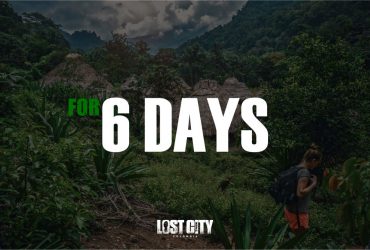
Lost City Trek (6 days) The Lost City Trek (6 days) is ideal for people […]
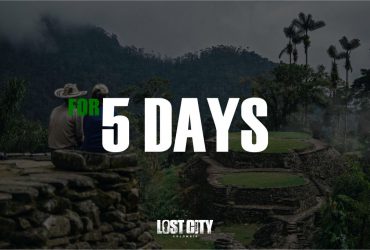
Lost City Trekking (5 days)
Lost City Trekking (5 days) You have the choice to change it to the four […]
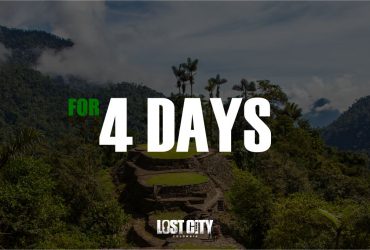
Trekking to Ciudad Perdida (4 days)
Trekking to Ciudad Perdida The Trekking to Ciudad Perdida (4 days) is the most adventurous […]
BLOG ABOUT LOST CITY
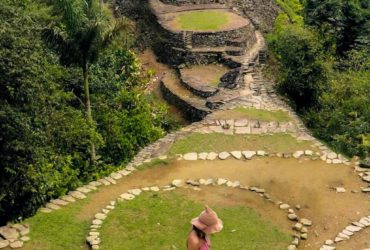
How to get to the Lost City?
The Lost City in the Sierra Nevada of Santa Marta is one of the most […]
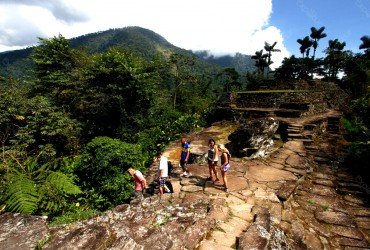
Tourism and Peace
Tourism and Peace The route to Lost City “Teyuna” in the Sierra Nevada de Santa […]
If you want to know other archaeological parks of Colombia, enter to the official page of the ICANH

We are a tourism agency specialized in the Lost City Trek Colombia , with more than 10 years of experience, offering a complete service to our tourists.
SOME PHOTOS
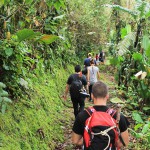
– –
Carrera 3 # 17-27 Edificio Rex, Local 3 Historic Center of Santa Marta
– – Mail Us
(+57) 605 420 7739 Santa Marta
(+57) 605 728 8232 Riohacha
(+57) 320 511 1458 Santa Marta
© 2012 LostCityTrekColombia, All Rights Reserved — Lost City's authorized operator — Santa Marta, Colombia.
You are here: Home » Treks Around the World » The Lost City, Colombia: A Guide to Hiking to La Ciudad Perdida
The Lost City, Colombia: A Guide to Hiking to La Ciudad Perdida
Last Updated on January 6, 2023 by Audrey Scott
The hike to the Lost City in northern Colombia takes you 46km (28 miles) round trip through the jungles, hills and river valleys of the Sierra Nevada Mountains. We’d had our sights set on the Lost City Trek for years, so expectations had built up. Fortunately, the challenge, landscape, and experience exceeded so many of them.
This Lost City Columbia Hiking Guide shares why that is and includes a day-by-day overview of the Lost City Trek, all you need to know to choose the right tour, how to pack and organize so that you can enjoy the Ciudad Perdida and this multi-day hike to the fullest.
We were out of breath, having just climbed 1,200 stone steps when Celso, our indigenous guide, called for us to join him around a group of stones arranged in a circle in a clearing. In the middle of the circle stood another square stone on top of which lay a pile of coca leaves placed as an offering. Celso explained with trademark calm in a slow, deliberate voice, “This is a place where we should let go of our impurities, our negative thoughts and emotions.”
We stood in silence, not only to “cleanse” ourselves so that we might better experience this sacred site, but also to enjoy its peace and quiet. To Celso, we were then prepared to further visit Teyuna, otherwise known as the Lost City ( La Ciudad Perdida ) in Colombia, the ultimate destination to which we’d been trekking in the rain forest for the previous two days.
Here’s why you might want to consider putting the Lost City or Ciudad Perdidia in Colombia on your travel or hiking wish list , in case it isn’t there already. In this Lost City Colombia Guide we include the day-by-day hiking experience plus all you need to know about to choose a Lost City tour and how plan, prepare for and pack to be able to enjoy the complete Lost City Colombia experience.
Update: This article was originally published in June 2015 and updated in May 2022 with information about the new G Adventures Lost City Trek itinerary.
The following experiences are from our G Adventures Lost City Trek . If you are considering this tour and want to know what to expect, here’s a taste of the itinerary and route, interaction with local indigenous guides, campsites and Wiwa community project. Disclosure: This tour was sponsored and provided to us in conjunction with our partnership with G Adventures as Wanderers .
Table of Contents
About this Lost City Colombia Trek Guide
When I researched the Lost City Trek as part of our travels in Colombia , I found a fair bit of conventional history about the site, often paired with a photo or two of the final destination, including what I refer to as the “golf course” shot.
What I didn’t find much of was information on what the actual journey to the Lost City was like, including the hiking experience, difficulty, landscapes, sleeping and eating conditions, weather, and more. That's the goal of this Lost City Trek day-by-day section.
The landscape along the trail is more beautiful and varied than we had expected and the Lost City site itself is far more extensive than most photos indicate. We especially appreciated having an indigenous guide to put everything into cultural and historical context.
Celso, a member of the local Wiwa indigenous community, shared his culture with us and linked it to the other indigenous communities, their relationship to nature and their shared connection to the ancient Tayrona civilization.
Our days usually began early, around 5:00 A.M., so we could get on the trail while it was still cool and so that we could complete our day’s journey before the rains of the mid-late afternoon. We appreciated getting up early, and we enjoyed all the benefits of the early morning – light, coolness and silence among them.
Lost City Trek Map
The map below shows the basic Lost City trail with different options for campsites and sections. We did a four-day hike, but if you opt for a five-day Lost City trek then your second and third days will be shorter as you'll have two days to complete that same route. The current G Adventures Lost City Trek is five days.
Hiking to the Lost City in Colombia: Day by Day Itinerary
Day 1 of the lost city trek.
- Start/Finish: Machete (El Mamey) to Adán or Ricardito Camp (Campsite #1)
- Distance: 7-8 km
All Lost City treks, no matter which tour company you choose, seem to set off from Santa Marta in northern Colombia. From there, a jeep or van transfer takes 45 minutes along the highway.
You’ll likely stop at a convenience store for last minute snacks and water. From there, you’ll head up a dirt track into the mountains.
After you arrive in Machete, you’ll have lunch, say goodbye to the driver and meet your local indigenous hiking guide. Then, the hike begins. ( Note: this is when you should ask the people coming off the trek if they have a walking stick they can give you. It is really helpful for balance and ease on the trail.)
The beginning of the walk eases you into things, with a swimming hole a close 25 minutes from the trailhead. After cooling off in the water, you’ll have a steep uphill for around 45 minutes, then a bit of a break, then a long descent into the valley where the first campsite is located.
Day 2 of the Lost City Trek
- Start/Finish: Adan or Ricardito Campsite #1 to El Paraiso or Paso Lorenzo Camp (Campsite #3)
- Distance: 14.7km ( Note: for the 5-day Lost City Trek this day is 7-8 km)
If you are doing a 4-day Lost City Trek, then this is a long hiking day. If you are doing a 5-day route like the G Adventures Lost City Trek then this will be a similar distance as the previous day, 7-8 km, to Wiwa Camp (Campsite #2).
The first segment of the day takes you uphill and across some beautiful terrain, including some local farms. After a jump in a swimming hole and lunch at Campsite #2 (Wiwa Camp), we continued all the way to Campsite #3 (El Paraiso or Paso Lorenzo Camp), located only 1 km downhill from the site of the Lost City.
If you are doing the 5-day Lost City Trek, then you would stop at Campsite #2 for the night.
This day takes you through a great deal of varied landscape — deeper into the tropical jungle, across rivers and by a couple of Kogi village communities along the way.
Day 3 of the Lost City Trek: Visiting La Cuidad Perdida
- Start/Finish: El Paraiso or Paso Lorenzo Camp (Campsite #3) to Wiwa Camp (Campsite #2), via the Lost City / Ciudad Perdida
- Distance: 13.6km
- Note: This is day 4 if you are doing a 5 day Lost City Trek.
You rise very early on this day (around 4:30A.M.) so that you can set off at dawn and enjoy the Lost City in the softest light and coolest air possible. After a short walk from the campsite, you reach the starting point of the 1,200 stone stairs you’ll need to walk and scramble to reach the terraces of the city above.
It’s not an easy climb, and can be a bit treacherous if wet or damp, but if you take care and get into a meditative rhythm, you’ll find it goes very quickly.
After the steps, you’ll have reached the lower chambers of Teyuna, also known as The Lost City or Ciudad Perdida. It is believed that this was a capital city built by the Tayrona civilization in 800 A.D., approximately 600 years before the Incas built Machu Picchu in Peru .
When Spanish colonialists came close to finding or approaching the in the 16th century, the Tayrona people opted to abandon the city instead of allowing it to fall into Spanish hands.
Of course, the Lost City Colombia was never truly “lost.” Teyuna was overtaken by jungle for the next several hundred years, as only the shaman (holy men) of the four indigenous groups who live in the area were aware of its existence and would visit it regularly for ceremonies.
It wasn’t until the early 1970s that the site was “discovered” by the outside world. Tomb thieves cleared out much of the gold, valuable artifacts and other remains. Due to this misfortune and the fact that no written record of the Tayrona exists, much about the city and civilization remains the subject of speculation.
The Wiwa, Kogi, Arhuaco, and Kankuamo indigenous groups that remain in the area are believed to be the descendants of the Tayrona and have carried on their stories and traditions.
We noticed when we arrived at the Lost City, Celso let down his hair, the surprising length of which is said to represent the wisdom that flows from the sacred mountains through the rivers to the coast. He was dressed in white, as was his custom, to represent the purity and integrity of the snow-covered peaks of the Sierra Nevada Mountains, out of sight in the distance.
Throughout our journey, he shared stories that had been passed on to him, through generations, from shaman to shaman, from elders to children, about the Lost City / Ciudad Perdida. The stories told of its creation, the symbolism of the different terraces, and the Tayrona relationship with nature.
The indigenous people that inhabit the area around the Lost City in Colombia believe they are the symbolic “elder brothers,” there to protect both the sacred Sierra Nevada Mountains and their “younger brothers” – meaning the rest of us.
The sense of responsibility to the equilibrium and the good and health of others was evident.
After your visit to Teyuna, the Lost City, you return to El Paraiso or Paso Lorenzto Camp (Campsite #3) for a quick lunch and begin your return all the way to Wiwa Camp (Campsite #2).
For us, we were met with an afternoon downpour that made it feel as though we were skiing through mud crevasses in the rain forest. We were glad for the experience. It was actually more delightful than it sounds as the rain was warm and everything around was so green and lush drinking in the much appreciated water.
Day 4 of the Lost City Trek
Start/Finish: Wiwa Camp (Campsite #2) to Machete and Santa Marta Distance: 12.7km This is another early rise since much of the trail is uncovered and therefore becomes quite hot as the day goes on. Try to make it as far as you’re able before the sun becomes too strong.
As you’ll remember from your first day, much of the trail is up or down, without much in between. After a stop for fruit at the first campsite and a jump in the swimming hole, you find yourself back where you began, with a celebratory lunch in Machete.
Then you'll transfer by vehicle to Santa Marta for a nice, hot shower and to reunite with the rest of your stuff.
Lost City Trek Difficulty and Hiking Conditions
We’d give this trek a medium-high difficulty ranking for all the reasons we’re about to elaborate. This means that you should not require special training to hike the Lost City Colombia trail, but you should be relatively active and in good physical shape.
You should either be accustomed to or be prepared for day-long treks with steep, slow uphill climbs and long walks in intense heat and humidity.
Lost City Trek is Not a Technical Trail
The Lost City Trek is not at all technical, meaning that you will not need any special equipment (e.g., climbing ropes or other fittings). The trail is well-maintained and for the most part, it’s an easy path to follow. But, it’s necessary to have a guide to navigate the rivers and some turns.
You’ll have to cross a few streams or rivers — with river shoes on or with your shoes and socks in your hand — but that is part of the fun.
Altitude, Steep Hills and Valleys
Altitude is not really an issue, as the trek’s highest point is around 1,500 meters/4,920 feet. However, the Lost City trail seems to either be straight up or straight down without much flat so there's a lot of steep ascents and descents on the trail.
Our advice is to take it slow and steady on the uphill. Keep in mind that it’s not a race. It’s better to hike deliberately and slowly and take fewer breaks than to go quickly and wear yourself out with frequent and longer stops to recover.
Heat and Humidity
One of the challenges of the Lost City Colombia Trek is the combination of heat and humidity. I’m not sure we’ve ever poured sweat with such intensity and consistency. It actually felt great, like a cleansing process.
Just be sure that you drink plenty of water to replenish. Note that respite from the heat comes a couple of times a day in the form of rivers and swimming holes to jump into.
Bugs Along the Trail
Another challenge and irritation of this trek: bugs and their bites. There are lots of them, especially mosquitoes at the Lost City itself. We suggest applying plenty of bug repellent (bring on the DEET if you need to).
If you are especially susceptible to mosquito bites consider hiking in long trousers as Dan did. Finally, pick up a pack of generic B-complex tablets (“Compejo-B generico” runs 25 pills for $1.00) in a pharmacy in Santa Marta before the hike, as certain B vitamins are said to repel mosquitoes.
Another thing to watch out for are fleas and/or bedbugs in the hammocks and/or blankets at the campsites – this is where we collected most of our bug bites (especially campsite #2). We recommend carrying a sleep sack , so that you have another layer of protection while you are sleeping.
Finally, check your body closely for ticks when you emerge from the Lost City Trek. We each had a few on us; they are very tiny and difficult to see, so look closely. (Note: For advice on how to properly remove a tick, check out this article .)
Rain and Mud Along the Lost City Trail
We had been warned plenty about rain and mud, but didn’t find wet weather too much of a hindrance. Yes, it rained from time to time (usually mid-afternoon), but it was often so hot anyway that the cool rain was welcome.
Be certain any valuable electronic gear is well-protected and any dry sleeping clothes are at least wrapped in plastic (e.g., ziploc, garbage bags or a dry sack ) inside your backpack. Then, have an outer backpack cover to protect your backpack from the elements.
If you fall in the mud, just go with the flow and don’t think about it too much. You can always wash yourself and your clothes later.
Best Time to Hike the Lost City Trail
While you will experience heat and humidity almost all year round in the Sierra Nevada Mountains of northern Colombia as it is a rain forest, there is still a rainy and dry season. December through March is considered the dry season and so it often is considered the bet time to hike the Lost City Trek.
In general, May through September is considered the rainy season for the region. This means expect more downpours and higher river crossings. That doesn't mean that you should avoid those months altogether as the rain can be a welcome relief from the heat and provide an interesting experience. For example, we did our G Adventures Lost City Trek in early June and thought the few rainfalls were kind of pleasant and added to the experience.
Note: The Lost City Trail is usually closed in September for trail maintenance and to do upkeep on the campsites and other services.
Lost City Trek Food
You will certainly not go hungry on the Lost City Trek. Each group is assigned a cook and not only will you be served three large meals a day (e.g., fish and rice, pasta, chicken and potatoes), but you will also enjoy well-placed fruit stops along the trail. These are very welcome for the additional boost of energy and hydration just when you need it.
If you are vegetarian or have food restrictions (e.g., gluten or lactose free), alert your trekking company and your guide in advance so they can respond accordingly.
Lost City Trek Campsites and Sleeping
There are a handful of different campsites along the way that the tour companies use. We can only speak firsthand to the ones that we stayed in — Adán Camp, Wiwa Camp, and El Paraiso — but we understand that the other campsites are quite similar in design, comfort and services.
Not always, but often, you’ll have an option to sleep in a hammock or on a mattress/bed (both with mosquito nets). We always chose the hammocks, but some may prefer mattresses.
There are cold water showers and flush toilets at all the campsites. Clotheslines will be strung around so you’ll be able to hang up your wet clothes from the day. However, the rain forest is damp so do not expect anything to fully dry overnight, if at all.
Evenings also get cool, so keep a long-sleeved shirt or fleece jacket handy at night.
Organizing a Lost City Tour: Your Options
Choosing a trekking operator.
You cannot do the Lost City Trek independently (at this time), meaning you must go with one of the four or five authorized tour operators. We took our Lost City Trek with G Adventures and can highly recommend the experience.
G Adventures work with a local organization that provides indigenous guides so that their travelers are able to learn about the indigenous cultures and communities still living in the Sierra Nevada mountain area.
Regardless of which operator you choose to take you on the Lost City Trek, we suggest you select one that works with indigenous guides. The cultural and living history background is essential to a full Lost City Colombia experience.
How many days do you need for the Lost City Trek?
Most trekking operators offer four-, five- or six-day trek options. We did the Lost City Trek in four days, but now all the standard G Adventures Lost City Trek offerings are five days. As the route is the same, the main difference is that a five-day trek includes a relaxed day #2 with only a few hours of trekking to the second campsite.
As for the six-day option, we can’t really imagine taking that much time to do the trek. But if you are worried about your trekking abilities and stamina then talk with an operator regarding what they suggest.
Leaving your luggage behind during the trek
Most accommodation and tour operators/trekking agencies will allow you to leave your big bags or luggage with them for the few days that you're doing the Lost City Trek. We left our big backpacks at our hotel in Santa Marta and we saw other travelers leave their bags at the tour operator/trekking agency office.
Lost City Trek Essential Gear and Packing List
Much of what we include in our Hiking Essentials Checklist holds true for the Lost City Trek. However, we offer a customized Lost City Trek packing list with recommended hiking gear for this specific hiking experience. The goal is to ensure you have what you need for the tropical rain forest conditions but that don't overpack and weigh yourself down with a heavy backpack.
While there is the option on some of the route to hire a mule to carry luggage and belongings, it's best not to count on it. You should pack and plan as if you will be carrying your pack the entire length of the trail.
Trust us, pack light. You’ll quickly begin to feel the extra weight going up those steep hills.
Hiking Backpack for the Lost City Trek
When we did our Lost City Trek we just repurposed our regular travel and laptop daypacks. This worked fine at the time, but since then we have invested in real hiking backpacks that fit our backs better and don't cause any aches and pains in the shoulders or back.
Here are two recommended options for hiking backpacks that will fit the hiking clothing and gear you need, but not be too big or bulky:
- Women's Hiking Backpack : I have a larger version of this Deuter ACT Trail Pro SL Backpack (22-Liters) and love it. The SL backpacks are designed for women's bodies and I find this backpack fits me really well, is well designed with its own backpack cover and zippered areas, and is both light and sturdy.
- Men's Hiking Backpack: Dan loves Osprey hiking backpacks as they fit his body type (e.g., tall) and back really well. He likes the Osprey Stratos 24-Liter Hiking Backpack for day hies or for multi-day hikes like this where you don't need to carry a lot of gear.
Refillable Water Bottle for Drinking Water
You will go through several liters of water each day (if not, then you’re not drinking enough) since you’ll be sweating constantly. Bring with you 1-2 refillable water bottles or a water bladder so that you always have at least one liter of water on you at all times.
Each campsite offers clean water, so you can refill your water bottles every couple of hours on the trail. If you really want to play it safe consider carrying with you a SteriPEN or sterilization drops .
Consider bringing electrolyte sports drink tablets or packets with you to help you replenish some of the minerals that you’ll sweat out each day. And let’s face it, sometimes drinking liters of water gets boring and you want some flavor.
Walking Stick
We highly recommend carrying a walking stick. We were very thankful for ours, especially when things got muddy and slippery. Hikers just finishing and on their way out of the trail donated their wooden sticks to us. If this doesn’t happen, then ask your guide for one and he will find a walking stick for you, or fashion one for you with his machete.
Alternatively, bring your own walking sticks (these are good travel-friendly walking sticks ). We usually just use one stick each so a set of two is sufficient for two people.
Hiking Clothing for the Lost City Trek
You really don’t need much in the clothing department. Don’t worry about packing clean clothes for each day. You will be sweating buckets within minutes every morning of getting out on the trail.
Here’s what we suggest for hiking clothing and gear essentials:
- 1 set of hiking clothes: T-shirt (preferably quick dry ), shorts, hiking socks . This means you will wear the same clothes every day. Don’t worry about it. Everyone does it. And you’ll be thankful not to carry the weight of extra clothes.
- Note: if mosquitoes love you, consider wearing hiking pants the whole time. Dan did this and it cut down on his mosquito bites considerably. If you are especially sun-sensitive, consider bringing a very light long-sleeved hiking shirt , but be aware that you may be warm.
- Hiking shoes: We wore low-rise hiking shoes ( his and hers ) and these worked great for us. Other people wore light trainers, however some mid-ankle support is useful because of the pitch of the terrain.
- 1 set of evening clothes for post-shower and sleep: T-shirt, long pants (or pajama bottoms), socks. To ensure these remain dry, pack them in a plastic bag or other impermeable container inside your backpack.
- Extra t-shirt: Just in case.
- Underwear for every day of your trek : With an extra pair thrown in for good measure, if you like. Recommended his and her s quick dry underwear for men and women .
- Extra pair of socks: Just in case your first pair get soaked beyond comfort while rock jumping at the river crossings.
- Bathing suit: Keep near the top of your backpack to have handy for swimming holes.
- Long-sleeved shirt: For cool nights or sleeping (recommended his and hers ).
- Fleece jacket : For cool nights or sleeping (can double as a pillow, too).
- Rain jacket (optional): We didn't use ours due to the heat and humidity. We appreciated the cool rain. Not to mention, a rain jacket in the tropics can feel like a personal sauna.
- Flip-flops or river shoes: To use in river crossings, showers, and evenings when you wish to get out of your hiking shoes. Women's Tevas | Men's Tevas
Other Essential Hiking Gear
- Waterproof backpack cover : You never know when a rainstorm will hit, so it’s essential to keep a rain cover for your backpack close at hand. Your guide will likely also have a supply of plastic garbage bags in case you need extra rain protection.
- Quick-dry travel towel : To dry off after showers, and also after a swim. Hang it on the outside of your backpack in the morning so it dries quickly in the sun and air as you move.
- Silk sleep sack : To provide an extra layer between you and the hammock (or mattress) and blanket. Fleas and other bugs in the hammocks bit us and other travelers we spoke to.
- Headlamp : Most of the campsites do not have electricity, so be prepared. Carry your own headlamp to find your way to the toilet and to sort through your stuff at night in and around your hammock.
- Silicone earplugs : A precaution in the case your camp has a snorer. We know from our Lost City experience that this can demolish a good night’s sleep.
Toiletries and Health Kit
You will have access to a shower every evening, and you will be so thankful for the cold water shower to wash away all the sweat and salt on your body from the day’s efforts.
- Shampoo, soap, toothbrush and toothpaste : The basics.
- Sunscreen : The higher the SPF, the better
- Sunglasses: Of course.
- Bug repellent : You will apply this frequently, especially at the Lost City itself. The mosquitoes there are big, aggressive and plenty.
- Hand sanitizer: To be on the safe side.
- Pack of tissues or toilet paper: The campsites all have toilet paper, but it’s always a good idea to carry a pack of tissues in case of messes, spills or emergencies.
- Vitamin B Complex: Take one pill per day (called Complejo-B in Spanish, available at pharmacies in Colombia). Supposedly, mosquitoes don’t appreciate the smell and taste of your blood when B-1 Thiamine is present. It is debatable whether this really works to repel mosquitoes, but we appreciated using it and felt that it helped.
- Foot care and blisters: Duct tape is very effective for hot spots and blisters on your feet. Also consider picking up some Compeed , which is magic when you already have blisters.
- Medical Kit (for emergencies): Your guide will also have some basic first aid items with him, but it's always good to be prepared. Our basic medical kit includes: Band-Aids , anti-bacterial gel (for cuts), rehydration powders or electrolyte tablets , Azithromycin/Ciprofloxacin (or another medication against stomach bacteria), Tylenol/Panadol (anti-headache/aches), Immodium (or some sort of “stopper” if you get diarrhea), tea tree oil (great to apply to mosquito bites) Note: all these are easily and inexpensively purchased at local pharmacies, including in Santa Marta from where you depart for the trek.
Electricity and Charging Batteries
While a couple of the campsites do have electricity, it’s unreliable. Prepare yourself for not having access to electricity during the trek. Some tips to handle this and further your battery power.
- Put your smartphone on airplane mode. There is no connectivity along the trek anyhow, so don't waste your phone’s battery power trying to find a network.
- Consider buying a phone case that doubles as an extra battery . It provides another 1-1.5 charges.
- Take an extra camera battery or two.
- Don’t spent time reviewing your images, as this will eat up your battery power quickly. Unless you are reviewing images to determine whether you’ve captured a specific shot, there will be time enough for photo review when your trek is finished.
G Adventures Lost City Trek Options
G adventures lost city trek tours.
Here are some of the G Adventures Lost City Trek small group tour options. These G Adventures tours all include an indigenous guide and all the support you need for a successful hike to La Ciudad Perdida in northern Colombia.
Colombia - Lost City Trekking (7 days)
The Lost City Trek tour we took that included all the experiences in this article, including an indigenous guide and cultural experience. The tour is 7-days and begins and ends in Santa Marta with 5 days of hiking the Lost City Trek.
Colombian Culture, Caribbean and Lost City (22 days)
This comprehensive 22-day G Adventures tour in Colombia takes you from the capital city of Bogota through Colombian coffee country to Medellin and finally to the Caribbean coast to explore Cartagena and Tayrona National Park before ending with the Lost City Trek (5 days). This tour is very similar to the experience we had with G Adventures in Colombia when we combined the Colombia Journey tour with the Lost City Trek . It's a great overview of the main regions of Colombia. Highly recommended.
Colombia Caribbean Adventure: Lost City Trek and Medellin (12 days)
This 12-day G Adventures tour in Colombia takes your from Cartagena to Medellin with the Lost City Trek in-between. This allows you to explore two of Colombia's most dynamic and fun cities with the adventure of the 5-day hike to the Lost City or Cuidad Perdida.
Colombia's Caribbean Coast & Lost City (14 days)
This 14-day G Adventures Colombia tour allows for an in-depth look at northern Colombia's Caribbean coast in Cartagena and Tayrona National Park before heading into the Sierra Nevada mountains for the 5-day Lost City Trek.
Have other questions about the Lost City Trek in Colombia? Just ask in the comments below and we’ll incorporate the information into the article so others may benefit.
Disclosure: Our Lost City trek was provided to us by G Adventures in cooperation with its Wanderers in Residence program. Check out this article for all the different G Adventures tours we've taken and recommend . As always, the thoughts contained herein — the what, the why, and the how — are entirely our own.
About Audrey Scott
150 thoughts on “the lost city, colombia: a guide to hiking to la ciudad perdida”.
Thanks for all of the detailed info. We’ll be doing this trek in November, so we’re looking forward to it all the more now.
You’re welcome!! Glad to hear that this information is timely for your upcoming trek. Enjoy!!
can anyone recommend a well equipped outdoors store in santa marta. thank you.
I don’t know of an outdoors store in Santa Marta, but I’m sure the trekking agency you decide to work with will be able to recommend a place to either buy or rent equipment. Otherwise, you could pick trekking gear up in Bogota.
whoa – what a massive, amazing resource! Thank you so much for writing all of this up — can’t wait to put it to good use. It’s pinned away now 😉
Glad you found this article useful and hope you can put all the info to use soon!
Was in Colombia recently and missed this … next time!
The Lost City will be still there whenever you return 🙂
Colombia is a excellent place to visit it is beautiful the food ,nature and the people
Great travel expedition in Machete. I am thrilled about the encounter you had with Teyuna, the Lost City. I am planning to tour all such attractions during my stay in Columbia so that I could have an amazingly beautiful trekking experience as well. Thanks for sharing!
Hello there! thank you so much for the very detailed article. i am actually going to colombia in 2 weeks and planned to do the same tour. you helped me a lot with your information. thanks a lot enjoy travels! isabella
You’re welcome, Isabella! Really glad that the article came out in time to help with your upcoming Lost City trek. Enjoy!
Great read! Trek looks fab, definitely plan to do this when we head to Colombia! Cheers Guys!
Breathtaking place. Its always wonderful to go and experience an isolated, totally disconnected civilization.
Loved the beautiful images as well.
– Cheers, Rajiv
Great photos! I am also thinking of going there. Did you find it safe to travel?
Yes, we definitely found the Lost City trek route very safe. The area had a history over 10 years ago in paramilitary and guerrilla activity, but it is currently not an issue for trekkers. If you’re curious about our thoughts on safety throughout the rest of Colombia, you might enjoy this article; https://uncorneredmarket.com/colombia-travel/
Fantastic resource! We’ve really started to get into hikes and trails and this is precisely the information we really appreciate but seldom find! We’re looking to head that way, sooner rather than later, so we’ve bookmarked this for when we make it there!
We often write resource articles after a trek with all the information we would have wanted to know beforehand. So, glad you found this article useful for your upcoming trip to Colombia. Enjoy!
Awesome article, very helpful! What time of year did you complete the trek? Just looking for some weather tips for a November adventure 🙂
Laura, we completed the trek in early June. As Colombia is so close to the equator we’re told that the temperatures don’t vary much throughout the year, so expect it to be hot and steamy. We’re told November is usually part of the rainy season so you may have more rains than we did, but with it being so hot the rains are actually kind of refreshing 🙂 Have a great trek!
This is a great overview of the trek. I did it three years ago and it would have been handy to have this info beforehand. We signed up for the five-day trek and ended up shuffling groups and doing it in four. From what I remember, day three would have been pretty short with a lot of sitting around, and we were eager to get to the city!
Thanks for the kind words about this post! Our goal was to write all the information and advice we would have wanted to know before taking this trek. Definitely understand wanting to get to the Lost City faster and opting for the four days instead of five 🙂
Very detailed and helpful post, lots of pictures. I appreciate the reality check of the weather, bugs and sleeping arrangements!
You’re welcome! Glad you found it useful, especially the reality check on weather and bugs and such. Better to be prepared than not 🙂
What an adventure … hopefully this doesn’t turn into another Machu Picchu one day!
Definitely understand, Adam! Don’t imagine that it will turn into another Machu Picchu, but that’s where limits on the number of trekkers per day might help.
What did you do with the rest of your things during the trek? We hope to be in Colombia for 3 weeks. I certainly don’t want to carry three weeks worth of stuff on the trail!
Emily, good question! We left our big backpacks with the majority in left luggage at our hotel in Santa Marta. When we finished the trek we were very thankful to have some clean clothes in those bags 🙂
Thank you! This experience seems established enough to have worked out a solution. Very grateful!
Loved the article. Great insight and information! Heading there in a couple weeks and your advice will be great! Thanks again!
Thanks, Matt! And great to hear that you’re headed out on this Lost City trek soon. Hope you have a wonderful time!
Lot’s of great info, we will be doing the trek with G adventures in Feb. 2016.
Great to hear this Bryan! Enjoy your trek and let us know if you have any questions before then!
Sounds like quite an adventure. The rappelling actually sounds like a lot of fun.
Hola Audrey, awesome blog. You would be laughing i am from Colombia but living in Colorado, USA. I am a photographer. So, i am concerned in hiking with my slr camera, lenses and tripod. Do you have time to photograph landscaping? Can you photograph the natives ? Thanks a lot for your help, G
Germán, thanks for your kind words about our blog! as for your questions, we did trek with a DSLR camera (but no tripod) and found there was time to photograph landscapes. I would recommend packing a dry sack for your gear as you may run into crazy rains along the way. As for photographing the indigenous people we met along the way we would always ask permission through our guide or directly. Some people were OK, while others preferred not to have their photos taken. So, it really depends on the situation and the people you happen to meet.
Enjoy your trek!
This was a really great post! We are going to do this trek in January and I can’t wait!
I am curious if you got any vaccines before going. It looks like they aren’t necessary but for the jungle trek would you recommend getting the yellow fever and hepatitis A/B vaccines?
Great to hear that you’ll be on this trek in just a few months! As for vaccinations, there are no special vaccines needed for this trek. However, we usually recommend that people traveling in this region have Hepatitis A & B vaccines, as well as checking whether you might need a tetanus or typhoid booster. Here are a couple more medical-related articles that might be useful: https://uncorneredmarket.com/world-travel-resources/travel-health-insurance-vaccinations/ & https://uncorneredmarket.com/around-the-world-travel-health-tips/
Have a great trip!
Hi – thanks so much for this information – so useful! I have two questions for you as I’ve heard a couple of horror stories. Firstly, were there parts where you found yourself clinging to cliff-edges with sheer drops below? Secondly, I know it’s the jungle and there’s a host of wildlife around – it’s their habitat! But were you finding gigantic spiders and snakes at every corner?
Leila, thanks for your questions. I’ll answer them the best we can.
1. I don’t remember any cliff-edges or sheer drops from our Lost City Trek. Dan is afraid of heights and really hates that type of stuff, so he certainly would have remembered that 🙂
2. No gigantic spiders or snakes that we saw. What you do need to watch out for are the little bugs – mosquitos, fleas, bedbugs. That’s why it’s good to bathe yourself in bug spray and wear loose long sleeves in the early evening when the bugs like to come ou.
If you have any other questions, just let us know!
Sounds like a lot of fun and you documented the trip well! I have a question though, are reservations required to do the trek? It is a little pricey for me but I would love to see the lost city!
Hanah, it is required that you trek with an authorized company for the Lost City Trek so reservations are required. The reason for this is that it’s a natural heritage area and site so this requirement is for conservation and protection. Maybe it’s possible to adjust some of your itinerary to prioritize this expense? It is a great hike!
Thank you for getting back to me. It looks so great I’ll make it work 🙂
Just back after our four day trek and your check lists was a great resource. We had a wonderful time and would highly recommend this to others. A few updates which I think are worth mentioning.
* Although not a technical trek, a high level of fitness is suggested. You will enjoy the walk much more. There are only up bits and down bits. And on the way back this is reversed. * Parts of the track are very poor and require good footwear and concentration. We walked in the dry season, I would hate to think what the mud would be like during the wet. * It is possible to buy water and other drinks along the route to supplement what you cary. We did take our own purification tablets as extra precaution to what was used by the local camps. * All out bedding seemed to be clean and fresh and no bed bugs. Perhaps this is more seasonal. However I would suggest a sleep sack.
In response to Leila above there are no sheer drop offs or cliffs. There is one section where the track gets very narrow and you need to watch your step. As our guide warned us “stop before taking a picture”. No ropes were needed.
All in all a GREAT trip
Mark, great to hear that this article was helfpul for your trek and thanks for your feedback and follow-up from your recent trip. I do agree that a certain level of fitness will help you enjoy the trek more, as we saw a few people who decided to go by horse/donkey for part of the time because they didn’t feel good in the heat and hills. Very glad to hear that the bedding was clean and fresh! Hopefully, that’s the norm from now on, but a sleepsack is always good to be on the safe side.
Glad you had a great time on the trek!
Great article. Any comments on visiting there in late February early March. Thanks.
We trekked in late May/early June, but I believe February and March would also be good times for the Lost City trek as it’s in the dry season. That means you won’t have to deal with as much mud or flash storms. And, the mosquitos might possibly be less as well 🙂 Good luck and enjoy your trek!
I really wanna do this trail, but is insecure about the wildlife out there 🙂 I am totally panicking if there is mice around me, especially in my camp. I can’t really find anything about this online, so either they are so common that people are not even bothering mentioning them, or they are not there? And what about other wildlife?
Happy to hear you didn’t encounter any big spiders 🙂
Thanks in advanced,
Hi Sisse, I really do not remember mice at the Lost City Trek campsites. This is in contrast to the Torre del Paine campsites in Chile where mice were everywhere ate through people’s food bags. As for other wildlife, the biggest bother are mosquitos and fleas/bed bugs (although someone who trekked more recently said he didn’t experience them). We didn’t see any snakes or other such creatures on the trails (as opposed to Australia where we came across several poisonous snakes), but as this is a jungle you should be prepared that it’s always a possibility. Hope this helped push you over the edge to do the trek!
Thank you so much for your answer! It definitely helps a lot. I know that you never know, but if you didn’t see 50 mice every night in camp why should we? I have been to Alice Spring and meet 100s of mice, and that was a great surprise and really freaked me out 😉 So I guess that Torre del Paine isn’t the place to go 😀 Now I can’t wait to go, thanks for this great blog post with so many great advices 🙂 Happy Spring!
I never wrote a big fat thank you! This blog post really made me take the jump doing this, and me and my boyfriend had such a great experience! It was a hard trek, but it was worth it! So thank you SO much!
Great to hear this, Sisse!! Thanks for letting us know about your trek and glad you had such a good experience! Now, where will your next trek be? 🙂
Thank you so much for this detailed guide, it is exactly what we needed and we will now be changing a few things as we prepare for the trek!
You are welcome, Victoria. Glad to hear we could help inform your Lost City Trek!
We will travel to Colombia in June for three weeks. We were thinking to do this trek, (certainly after reading this article) but we have one more question: What with your big backpacks? We’ll both have a large backpack with us packed for three weeks, is there any place/option you can leave your big backpack and take your smaller one with you for the trek? 🙂
Greetings from Belgium!
Tine & Fabio
Hi Tine, You have two good options for your big backpacks. Leave them at the hotel where you’re staying before (and after). Or, leave them at the trekking agency’s office. We did the first option, and saw others do the second. Hope you do the trek – it’s really wonderful!
Thank you so much for your quick reply! We can’t wait to take off! 🙂
We are now one week back from our amazing trip to Colombia. The Lost City Trek was our highlight. It was amazing. All things you described were spot on. Thanks again for the article, it’s an experience we’ll never forget!
This article is great! I’m traveling through Peru right now and headed to Colombia next and am really hoping to do this trek. But I also have some questions about backpacks. K have two with me right now: one 65 liter and one 20 liter. The 65 liter one is way too big and I’m assuming the 20 liter is too small. Did you see any companies renting out backpacks for the hike? Say around 30-40 liters?
Lauren, I didn’t see any companies renting out backpacks, but it’s always worth asking the trekking company you’re going with whether they offer that service. I imagine that someone in Santa Marta must.
You might be able to get away with just 20 liters since you really don’t need all that much with you…it’s really hot and everyone wears the same thing every day 🙂 With our trek, Dan carried a 30-liter backpack, but this was essentially for the two of us as I my backpack was mostly filled with camera equipment.
HI Audrey Thanks for this reply about the backpack size to take. I’m doing the Trek at the end of this month ( Dec – 17) and initially though of taking a laptop bag.. but realised it would be too small. I had asked a colleague of mine who goes on big treks – 15 -20 days and he suggested a 25 liter backpack. I wanted to check with you if that seems like an ok size – I’m going on my own.
Hi Vivek, We did take our laptop backpack with us on the Lost City Trek and it worked fine. Since it’s a hot climate and food it provided at the campsites you really don’t need to take very much with you. If you do want to get a more proper trekking backpack, a 25-liter backpack would be a good size. Have a great trip!
This is an amazing guide, and your photos are spectacular! What camera do you use? How did you protect it from the humid/rain/river crossings?
We had both an iPhone and a DSLR (Nikon D7100) on the trip. The photos you see are a combination of the two. We also carried a 10-liter dry sack for emergencies. Fortunately, we didn’t need it!
Hi Arleen, Thanks! Glad the guide is useful! We carried a Nikon D7100 and for most of the time we had it in the camera bag, but when it did start raining or with river crossings we put the camera bag into a dry sack. Our guide also carried extra thick garbage bags to help protect things from the rain. Hope this helps!
Your blog has helped me immensely in my thoughts of preparations for this hike. I have bookmarked this site, and will use it as a bible in the next few weeks prior to. I’ll look forward to more of your inspirational travel stories as well. Thank you, and cheers!! Instagram: kirbythekoala
Hi there, thank you so much for your informative guide; I was quite nervous when a friend suggested doing this trek but am feeling more confident about doing it since reading your blog.
One question; I’ve been told by friends that you need to cross rivers that are chest deep. Did you find this to be the case when you went? I’d be doing it at the same time of year you did (soon!). I guess I’d be OK with that if there was a rope to hold onto and the water flow wasn’t too strong, I’d be OK with cage thing as per your picture – it’s just the getting swept away part that concerns me. Any insight specifically on river crossings much appreciated, Sarah.
Hi Sarah, We certainly did not have any river crossings that were chest deep. The most I remember was perhaps a bit below the knee (I’m not that tall) so it wasn’t a problem with getting my shorts wet. When we did reach a crossing with high water our guide found a different area where the water wasn’t so high (eg, or had the cage). But, water levels do vary each year so perhaps it’s good to ask the trekking company in advance to be sure. Enjoy the trek!!
Thanks for the article, it’s really useful and well written. A friend and I are thinking of doing the trek in July, we’re wondering if you or anyone else knows how frequent the tours are e.g. Do they leave Santa Marta every day?
Thanks a lot Caroline
I believe that between the 3-4 companies offering tours you should find at least one departure a day in July. As mentioned above, we recommend going with a trekking company with indigenous guides. Enjoy!!
I’m planning this hike in July to celebrate my 40th and the fact that I’m now moving out of Colombia… this guide has been so helpful- thanks! 🙂 I have a question about footwear: I have a good pair of hiking boots, but would prefer keeping them dry-ish. Do I need a good pair of shoes for river crossings or will flip-flops be sufficient?
We used our Tevas (river shoes) for the river crossings and they worked fine. The currents weren’t very strong when we went, so a sturdy pair of flip-flops should probably be sufficient. Good luck and enjoy the trek! It’s a great way to celebrate!
Hi! Thanks for the care you put in to this blog! A friend and I are considering this trip but we only have 10 days in Colombia –arriving and departing in Cartagena. We are not sure that doing this trek will leave time to do anything else. I just had a clarifying question –Is there transportation arranged for the way back or do you have to walk back the same way you came in? Meaning is this really an 8 day trip? I am guessing not, but thought I would make sure.
Thanks in advance!
Hi Ana, Yes, transportation is arranged for your return to Santa Marta. From there you can easily hop a bus to Cartagena. It’s possible to do the trek in 4 days, and get returned to Santa Marta after lunch on that fourth day so you still have the afternoon to clean up and regroup. If you do the tour with G Adventures, they offer it in 5 days. Either way, you should be able to fit this trek pretty easily into a 10-day trip. Good luck!
I’m so glad I found your blog! This is all very helpful. This trek will be my second trip with G Adventures! I’ll be doing it next month. Do you think it makes sense to buy a mosquito net for my head during the day? Also, you mentioned ticks, That makes me extremely nervous. Were you able to easily remove them? Which vaccinations did you get before your trip? Do you suggest bring trekking poles or just using a stick? Last question (hopefully), did you encounter bed bugs? I hope to pack light like you and all your photos look amazing.
Hi Cheryl, Glad this post was useful for your upcoming G Adventures Lost City Trek! I don’t think you need a mosquito net for your head during they day – they weren’t nearly as pesky and annoying as the bush flies in Australia (where we did end up buying a net to maintain our sanity). The ticks we picked up were quite small, but were easy to pick out with tweezers. If you’re concerned, perhaps pick up a proper tick-removing kit. At other times of year you might not encounter any ticks. As for vaccinations, it’s probably best if you have Hepatitis A and Typhoid vaccinations to be on the same side (More info: http://wwwnc.cdc.gov/travel/destinations/traveler/none/colombia ). We did notice either bed bug or flea bites (not sure which), but another commenter who went on this same trek after us said no one in his group got any bites like that. So, it may be that they’ve gone through and switched out/cleaned the hammocks or blankets.
We did not bring trekking poles with us, but instead when we first started the trek the group before us handed over their stick. Otherwise, your guide can easily find one along the way for you.
Also, I forgot to ask, what size was your backpack?
We both carried backpacks that were around 30L, but we could have probably gone even smaller as they weren’t completely full. Those were just what we were using for the rest of our Colombia trip so we repurposed them for the trek. As you know, the smaller and lighter, the better 🙂
Fantastic and informative overview. We just completed the trek and found the information here to be very useful in preparing. Thanks so much!
Great to hear this, Linda!
Ms. Scott… I am researching, writing and producing a 72-page curriculum guide about Colombia for the non-profit Memphis in May International Festival for the festival’s 2017 salute to their honored country of Colombia. This guide is printed and distributed to teachers in all elementary, middle and senior high school teachers throughout Memphis and Shelby County, and also presented in PDF form on their website (www.memphisinmay.org). I want to include a lesson plan about Colombia’s Lost City, but I think it would add a personal touch by having students reference your blog about your trek through the Lost City. The lesson plan would describe the Lost City, its location, history, ecological significance… and then would encourage students to “plan” for their own exploration of the area…. then referencing your blog for details from someone who had actually explored this great place (what to pack, how to prepare, what to expect, conditions). To do so, obviously, I would need your permission… and hopefully, to provide your permission for us to use on of the photos from your blog for reproduction with this lesson plan. I appreciate your consideration.
Hi John, We received your email about this as well and I just responded. If you didn’t get it for whatever reason, please let me know! Cheers, Audrey
Hi Audrey and Daniel, this post about the Lost City is superb. I am flying to Colombia on Sat only for this trek. I initially was thinking G Adventures but then switched to a local company ( Expotur). However, Im very apprehensive about the possibility of diseases. I’m thinking malaria, zika etc. Can you please give a few pointers? Did you take any special vaccines/injections before doing this trip ? Please advise. Thanks
Hi Mayank, Best protection is to try and prevent mosquitos and other bugs from biting you. As mentioned in the article above, we took B-Complex pills (bought at pharmacy in Santa Marta) and lathered on lots of insect repellent to keep away mosquitos (and other bugs). Dan also wore trousers the whole time as he often gets eaten by mosquitos. However, the mosquitos in the Lost City Trek area are not malaria mosquitos.
When we did our trek Zika was not an issue, but as I read on the CDC website there have been Zika cases found in Colombia recently. You should ask the tour company whether any Zika cases have been found specifically in the Lost City Trek area. Again, the best course of prevention is to try and avoid being bitten in the first place.
We always have the standard travel vaccinations up to date — Hepatitis A & B, Typhoid, MMR, Tetanus — so we didn’t get any special vaccinations before doing this trek. Given that you are only going to Colombia for this trek, which is only a few days, I wouldn’t worry about getting special vaccinations for the trip.
Hope this information helps!
Hi! I’m really interested in doing this trip and am in the middle of preliminary research. G Adventures looks like a great group to book with, but I found another trip through TripAdvisor for much less – just $399 for a 4 day trek. TripAdvisor doesn’t say which company will be in charge of the trek, however. Do you know why G Adventures charges so much for their trip (i.e. are they THAT much better than the other ones), and do you know of any reason why I shouldn’t book through TripAdvisor? Thanks so much for your tips and any additional insight you may have!
Hi Lizzie, Some of the difference in price is probably connected the following reasons: G Adventures’ tour is seven days, meaning that the price is for a five-day trek and also includes hotel in Santa Marta the day before the trek and the day the trek ends. Additionally, they usually work with two indigenous guides if the groups are bigger than a certain size. This allows more interaction/engagement with the guides and also provides more support as one indigenous guide is at the front and the other is at the back. The G tours also have one of their own guides (CEOs) who helps with translation (as the indigenous guides don’t speak English), organize meals, sleeping arrangements, etc., and just work to smooth things over in case there are any heath or other issues. And, as it’s a big international company they also have lots of experience and a set process for handling emergencies or other unusual situations.
As I don’t know which tour is being offered through TripAdvisor, my thought is to see if you can ask a few questions before you book. Here’s what I would want to know: 1) Does the tour have an indigenous guide? For us, this indigenous perspective on history, nature, and culture really added to the trekking experience. Most of the tour companies operating Lost City treks do not have indigenous guides.
2) If you do not speak Spanish, then is there someone to translate for you? We saw that some of the other groups would have a translator in addition to the official guide.
Good luck with your planning!
Thank you so much, Audrey! That was immensely helpful (as is this blog post more generally). I think I’ll probably end up booking through Expotur, for the sole reason that I (unfortunately) don’t have 7 days for Santa Marta/the trek. Not sure if you keep in touch with the folks at G Adventures, but if you do, you may want to suggest that they look into possibly hosting a shorter 4 day trek. If they had that option now I would 100% go with them. Thanks again for your guidance. Your blog was actually the reason I started looking into this trek in the first place, and I can’t wait to spend my 30th birthday on it 🙂
Hi! I’m wondering where people stay before and after their hike to the Lost City. I’m planning to fly into Santa Marta from Bogota in a week from today, and wonder if it’s easy to go directly from the airport to the trekking office/departure location, or if it’s necessary to stay in Santa Marta on the eve of the trek. Any advice would be greatly appreciated! Thanks for all the other info and tips in your article!
Hi Mary, We stayed in Santa Marta the night before the trek began and I think this is the safest option. On the first day of the trek we began in Santa Marta and then had 2-3 hours of transport to the starting point of the trek. So, it may be kind of risky to try and go from the airport directly to the trekking office in case there’s a flight delay. The trekking company you are working with should be able to tell you what time they depart in the morning and then you can make your decision based on that. Good luck!
Great insight into the trek! I’m thinking of doing this in December going solo? Would you recommend this? We’re there others doing the same?
Matt, I don’t remember seeing any solo trekkers with a guide, but I’m sure you can put in a request with one of the authorized trekking companies to get your own private guide. Since a trekking guide/company is required for this trek it’s not really possible to walk it completely on your own. Some of the campsites are shared between trekking companies and some are independent.
Hi Audrey, I loved your story on the Lost City. All your comments are so well thought out. Many thanks. My question is about the swimming holes and swimming in the river. I am a non swimmer. Are they very deep? How do I prepare? Thanks.
Bhanu, Some of the swimming holes do get deep in the center (e.g., a few meters), but you can always just stick to the edges and dip your body in the water there to cool off. One of the holes also had a sort of sitting area under a waterfall where you could just relax. The other thing is that you don’t have to go into the swimming holes. You can always just stick your feet in there to cool off and enjoy the atmosphere under the trees.
Thanks Audrey. I have one more question: did you wear a water proof sandals when crossing the river? I am planning to take my trekking shoes for the trek… but did not want to get them wet; hence is my question. Thanks, Bhanu
Bhanu, we both carried river shoes with us (e.g., Teva sandals ) and sometimes we would change into them to cross rivers and other times we would take off our trekking shoes and just walk barefoot. It depended upon the depth and also whether the bottom of the river was rocky. We do recommend bringing a pair of river shoes/waterproof sandals/flip flops with you also for changing into at night to give your feet a break, wearing in showers/toilets, and walking around the campsites.
I have a question about this trek, as I am doing it in October (2016). I am not planning to take malaria tablets and just use DEET and take some precautions like wearing long sleeved top/bottoms etc. Could you please advice me on that?
Great that you’re doing this trek soon! The mosquitos along the Lost City Trek are not malaria mosquitos, so your plan of not taking any malaria medicine and focusing on preventing bites makes sense. If you really do dislike mosquito bites consider taking B-Complex pills as this is supposed to make you less attractive to mosquitos.
Hey Audrey,
Thanks so much for this useful post, I really appreciate all of the detailed advice. Nick and I are planning on South America for 2017 (finally getting there!) and will hopefully do this trek as well. We’ll be in Colombia in November / beginning of December so I’m hoping the rains won’t be too bad. We’re in Grenada (southern Caribbean) right now and the rains have been few and far between this rainy season 🙂
Cheers and happy travels!
Hi Dariece, Great to hear that you’re descending upon South America soon! It seems like every year the rainy season and weather cycles change, so fingers crossed it won’t be too wet for your Lost City Trek later this year. Even if it is rainy, it’s warm rain and a great experience either way.
Thanks so much for your very informative blog. We are going to do this trek in February – what will the temperature be? And will it be very humid at that time of year?
February is a great time for the Lost City Trek! This will be the end of the dry season so you should have very little (or perhaps no) rain so it shouldn’t be very humid. I believe temperatures will be in the 80s, so you’ll likely start your walking early in the morning to avoid the worst of the heat in the middle of the day.
Hi, did you take your main backpacks or do the mules take these or is it best to leave them at the hostel and just take small day bags? Thanks
I’d recommend to leave your main backpacks in Santa Marta either at the hostel or at the office of the trekking company you’re using. Then, just carry day packs with some clothes, camera, water bottle, sleep sack, etc. You can take a look at the packing list in this article for recommendations on what to bring. Enjoy the trek!
Hi Audrey What a great blog, so useful, and wonderful photos. Do you think telescopic walker poles would be helpful or would a stick picked up along the way suffice? Thanks, Annie
Hi Annie, Glad this blog post was useful! We found that a stick picked up along the way sufficed, but if you would feel better with your own walking poles then bring your own if it’s easy to do. Just know that they may get a bit muddy along the way 🙂
Cheers, Audrey
Of your campsites (Adán Camp, Wiwa Camp, and El Paraiso), did all have the option to hammock camp? We have our own, bug-netted hammocks and would like to use them. This would solve the tick, flea, bedbug issues that you had. Tx -alan
Alan, at the campsites the hammocks were tied between wooden poles. You could either add yours or take one of the standard hammocks down and replace it with your own for the night. I don’t think this would be a problem at all, but perhaps just double check with the tour/trekking company you’re working with that it’s OK.
This article helps me a lot. would for example never had thought of bringing TP or a long sleeve shirt for sleeping in. 😀 going there at the end of the month for a 4 day trek. can’t wait. Do you have any recommendations for hikes or tours around Sao Paolo, Brazil?
Gísli, so glad to hear that this article was helpful for your upcoming Lost City Trek! I’m afraid we haven’t yet been to Brazil, so cannot make any first-hand recommendations for Sao Paolo. Have a great trip!
My partner and I are planning a trek to the Lost City next month, February, 2017. We would be most grateful if you could help us with some logistics and other questions.
We are looking at the possibility of flying into Bogotá, Columbia and from there taking a flight to Santa Marta. Questions:
1. Is it necessary to begin from Santa Marta? 2. Did you book your trekking company in Santa Marta? Is that where you started? 3. Did you stay in the area before/after the trek? If so, were there other interesting adventures? 4. Did you explore the National Park, Tayrona nearby? 5. Did you find the bugs exceptionally bad on the trek to the Lost City? 6. We will have a couple of weeks to enjoy Columbia and would love to hear of any other activities you may have found in the area.
Thanks for inspiring us!
Hi Cecilia, Great to hear you’re thinking of doing the Lost City Trek. As for your questions:
1) As far as I know, all of the treks begin in Santa Marta with a transfer out to the starting point (Machete). However, you could always coordinate with the trekking agency to meet the group at Machete if there’s something in the area you’d like to do first.
2) Our trek was through G Adventures and it was booked before we got to Santa Marta. However, there were other people we met at other tour companies/trekking agencies who booked their trek once they got to Santa Marta.
3) We only spent the night before/after in Santa Marta and it was a nice town, but don’t know that we needed to spend much more time there. Prior to Santa Marta we were in Cartagena and that’s worth spending a few nights.
4) Yes, we did explore Tayrona National Park before our Lost City Trek (and Cartagena). We did a great day trek out to Cabo San Juan. It’s also possible to spend the night out there if you prefer. It’s a beautiful area.
5) The bug were bad, but I don’t know if they were exceptionally bad. As mentioned in this article, we were also taking B-Complex vitamins which is supposed to deter mosquitos.
6) Colombia is beautiful and fascinating. For more ideas on what to do, check out our Experiential Guide with 25 things to do.
Hope this helps and have a great trip!
Thanks very much, this is an amazing resource.
My friend and I are planning on going the end of March, the beginning of rainy season, that makes us slightly worried. could you help us out what to expect regarding: (1) height of rivers / slipperiness (2) amount of rain / sun (3) mosquitoes
It seems like you had a great adventure regardless of the visit being in the middle of the rainy season. I’m hoping that the rivers will not yet be too high and that part of the trip will be dry and sunny.
Thanks very much!
Hi Aliz, Our trek was in early June, so more towards the end of the rainy season. The height of the rivers were fine for us – there was one spot that was high, but they had the cage contraption already set up to get across. All the other rivers were easy enough to walk across. But again, we went a couple of months later. As for rain, we had sunshine for most of the time, but there was one day with a big downpour that we waited out a little bit and then just decided to walk in the rain as it was warm. The mud did get a big slippery so the guide found me another stick and I used two sticks to go down some of the more slippery hills. But, it was all quite manageable.
Mosquitoes can get bad at times, which is why we recommend in this article to pick up B-Complex pills in Santa Marta (supposedly repels mosquitos), lather on bug cream, and wear long-sleeve shirts/pants (if necessary). The hammocks usually have mosquito netting around them so you shouldn’t be bothered at night.
Hope this helps and good luck with your trek!
Thanks for the write up. I have been to Colombia many many times, and always wanted to go to la ciudad perdida. Problem has been the age of the kids. They will be 10 and 13 at the end of the year and are fit and active (we trekked from Leticia in Amazonia 4 years ago, but that was a single day)..
What do you think about the 5 day version?
Hi Andrew, Good question regarding your kids. I’m inclined to say that if they are accustomed to heat and humidity they should be fine if you take things slowly with 5-6 days. However, I’d ask the trekking agency you’re planning to go with whether they have experience with kids of a similar age doing the trek. Also, donkeys can be hired for certain segments of the trek that might help as well. Good luck!
We’ve just done the trek and a 13 year old girl was part of our party. She doesn’t regularly do evercise but had no problem, she had to wait for us 50/60 year olds. She loved it, had a great time. What an amazing experience. We did the five day trek. Pack light, bring a warmer long sleeved top and trousers for evenings, itcanget a bit chilly. . Flip flops are good, we forded streams in bare feet. They were up to knee level at worse. We slept in beds every night, some had pillows, all had blankets and mosquito nets. Wear comfortable supportive shoes or boots, well worn in. Blisters aren’t icy fun. It rained once at night. The best thing we brought? Silk sleeping bag liners. It was tough, I’m a reasonably fit 60 year old and found the long uphill climbs exhausting, but well worth it.
Wow, you guys are pretty hardcore, backpacking in the jungle, so to speak. Colombia has a rich culture, one I am only beginning to explore. It is as close to Eldorado as possible, and ancient artefacts reflect it. I will probably set on my own journey of Colombian discovery one day, route will be slightly different. Or possibly, I will digress to Los Nevados National park on my road there.
What great and wonderfully helpful information you have posted!!! We will be traveling for the trek in mid-March. It seems that you recommend the typhoid vaccination and felt that malaria pills may not be necessary, but I saw no mention of yellow fever?? Can you please comment on what you feel the latest vaccines and/or precautions might be to consider. Also, did you find the river to be moving quickly and difficult to cross??
Thanks so much….
Julie, for the latest information on recommended vaccinations for Colombia you can check out this CDC page: https://wwwnc.cdc.gov/travel/destinations/traveler/none/colombia And for Yellow Fever specifically: https://wwwnc.cdc.gov/travel/yellowbook/2016/infectious-diseases-related-to-travel/yellow-fever-malaria-information-by-country/colombia#4753
The last article seems to indicate that Yellow Fever may be present in the Santa Marta/Tayrona National Park/Lost City area. I’d check with a nearby travel clinic just to confirm. One thing that has changed since our visit is the appearance of Zika in certain parts of Colombia. Unfortunately, there’s nothing that can be taken to prevent this so best thing is to cover up as much as you can.
When we trekked in early June the rivers were easy to cross. There was one place where it was high and fast, but there was a sort of cage contraption (see photo above) that was set up to go above the river. Our guide was quite careful in testing the waters first to make sure it was safe, and then finding another spot if he thought it could be dangerous.
Enjoy your trip!
Thought of just a couple more questions. We know the highest elevation is 5000 feet, but wondered if you knew the altitude in Santa Marta where we will be starting and/or at the Tayrona National Park where we have planned a day trip. Also, did you bring tablets, use a filter or steripen to treat the water provided at the campsites? Really appreciate your help. This is our first trip to hike in South America 🙂
Santa Marta and Tayrona National Park are both on the coast, so you’ll be starting at sea level and then working your way up to 5,000 feet. The campsites provide clean drinking water and we just drank that straight. However, if you do have concerns then I’d bring a steripen with you to be extra sure. As mentioned above, you might also want to bring some gatorade or electrolyte powder to mix with the water to replenish some of the minerals you’re sweating out.
Enjoy your first hiking trip in South America! Hope it’s the first of many!
Audrey…..Thanks so very much for your quick reply. Try as I might, I can’t seem to find the article you referenced about possible yellow fever in Santa Marta. Is there a way you can further guide me to that information.
So sorry for any inconvenience
Julie, I just checked the Yellow Fever in Colombia link and works ok so give it a try again: https://wwwnc.cdc.gov/travel/yellowbook/2016/infectious-diseases-related-to-travel/yellow-fever-malaria-information-by-country/colombia#4753
Are people allowed to do this trek without a guide do you know? Thanks in advance!
Great question. I was wondering the same thing.
Connie, it’s not allowed to do the trek without a guide from an authorized trekking agency. You can choose to do a group or individual trek with one of these trekking agencies.
Thanks for the write up, Audrey! Just booked the 4-day Trek for mid-March.
You’re welcome, Jonathan! Hope you enjoy your upcoming Lost City trek!
Thank you for the information it was helpful and accurate in most circumstances. However, I was surprised with the food at the camps. Frankly, I never figure out who was the cook …
I went with Expotur , which has relatively large groups – When I went it was roughly 10+10 people. Moreover, different companies seem to share the same accommodation and food (with some exceptions). That brought the number of guests roughly to 30-35. Now add 10-15 of support staff and guides. We are talking about around 50 to be fed!
Cooking was thus done in mass production and the serving time was the same for all groups. In fact, at the peak time of lunch/dinner you may have around 10+ people in the kitchen doing various jobs including preparing food and salad. Obviously, if 10+ people are handing the food the notion of the cook is lost.
My impression was that in the kitchen “anything goes”. Several people (if not all) got a stomach ache during the trek but the last day was a “mayhem” at the toilets from the pasta and chicken. Also, a young man served me coffee in a dirty cup because he couldn’t find a washed one. I understand that during camping such events can happen, but the way I experienced it was a systematic lack of roles in the kitchen something which is a disaster waiting to happen and in fact, it did happen.
It is a shame that it is not allowed to do it on your own…
Stavros, thanks for your comment and information about the cooking/eating situation on your trek. When we went on the G Adventures Lost City Trek there were other people staying at the campsites, but we had our own cook who traveled with us and only cooked for our group. It’s unfortunate to hear about the disorganization and questionable hygiene on your trip.
My friend and I just booked the G Adventures tour for the end of July / early August and we are super excited! Thank you for this very helpful article. Will definitely help us in preparing and packing, and knowing what to expect.
You’re welcome!! Glad this post was helpful to get you ready for your upcoming Lost City Trek. Enjoy!!!
Hey Audrey! I’m writing a post on Colombia and I’d love to link this post for any reader who wants further information! You guys have so much invaluable info here.
It looks like you had the time of your life. Definitely adding this to my bucket list!!
Of course! please provide a link to our post! Hope it’s helpful for your readers.
Those are really helpful information and a nice teaser for the trek. I’ll be doing the trip with G soon as well. Could you tell me how they’ve organized the big luggage? Do you leave behind at some accommodation or it will be brought all the way with horses/mules?
Hi Mircea, Great to hear that you’ll soon be on the G Adventures Lost City Trek. As for your big luggage, just leave it behind at the hotel in Santa Marta. They will keep it for you until you return from the trek.
Have a great time! Audrey
Think about leaving it in the hotel you will be going to AFTER the trek. If, for example, you are staying in Palomino after (lovely, and closer than Sta Mta) it would be a pain to go back into town (90 min) and out again.
Thanks for the clarification, Andrew. If you aren’t planning to return to Santa Marta then arrange for your luggage to be left wherever you will go after the trek.
Thank you so much for such elaborate article! I’m going to Colombia for 3 weeks and thinking about fitting this in my schedule. But do wander whether it will suit me as I’m not an experienced hiker and physically not super fit. I’ve done some tough hikes, but I’ve always been very afraid of descending, especially if you can see the edge of the mountain.
Is the Lost City hike steep and narrow? Do you get the ‘falling of the edge’ feeling there?
Do you have any other wonderful but relatively flat hike to advice?
Thanks a lot.
Hi Dongqing, Although the Lost City trek does have some steep hills, I don’t remember it as being particularly narrow or feeling like we were close to cliffs or edges where we could slide off. Most of it is in a rainforest so the path goes between the trees.
As for other hikes in Colombia that might be flatter, perhaps look into hiking in the cloud forest of Cocora Valley in coffee country (Armenia), This is more of a day hike vs. multi-day hike, but it is beautiful and really unique (see #10 here: https://uncorneredmarket.com/25-travel-experiences-colombia/ ).
Enjoy your three weeks in Colombia! It is a beautiful and diverse place!
I asked on this site almost a year ago about travelling to the lost City with kids. We returned last night from the four day trek with 4 adults and kids (15, 13, 10, 10). We used Wiwa tours.
Absolutely unforgettable experience and well worth it with the kids. They were younger/ significantly younger than anyone else we saw but all made it through and were delighted despite 1x fever and 1x stomach bug.
3 of the 4 (the younger ones) were very physically active anyway, and this showed through.
However we did realise on day 2 that with illness we would need help. We thus hired a mule (350,000 pesos for the rest of the trek) which was an absolute godsend. Meant the kids could take turns for a short break if they wanted to (or if they simply wanted to ride for fun). The mule also carried the 2 heaviest backpacks which helped (they were quite heavy as had most of kids stuff in as well as adults).
Worth noting that there are parts of trek (including final climb to the city) that the mules cannot do/ cannot do with riders, so they should be considered a help with the trek, not a substitute for some pretty significant walking (middle 2 days were 12 hours long with breaks).
Also need to be conscious that sleeping conditions are basic (at each site the organisers made sure kids got beds, not hammocks which helped), and they need to be non-fussy eaters. There is no choice of menu (the food is good), and the fuel is needed.
This trip has really made the holiday. Now time to chill by the Carribean Sea. (Hotel Aite in Palomino is fabulous- stayed on the way up, but unfortunately fully booked for the New Year)
Thanks for all the advice on this site.
Andrew, thank you for returning and letting us know how your Lost City trek went with children. Really appreciate you sharing this invaluable first-hand experience. So glad that it was such a great experience and this was one of the highlights of your visit to Colombia! Sounds like you and the guides were able to adjust and figure things out with the mules and other help. Yes, the campsites are pretty basic (hopefully you didn’t come across fleas!) and the food is hearty and meant to fuel you for the long walks, but doesn’t offer a lot of options.
Enjoy your chilling time by the Caribbean Sea and a very happy 2018 to you and your family!
Hi , Thanks for the detailed info, I would like to ask about your luggage whilst doing the trek did you leave it in your hotel/hostel? or can you leave your stuff with the company you’re booking your trek with?
Nikka, Both options are possible. We left our luggage at our hotel in Santa Marta and then stayed there for another night when we returned from the trek. This was the easiest option for us. We also saw other travelers leave their luggage at the trekking agency/tour company’s office. Have a great trek!
Dear Audrey, thank you for this wonderful post. This has made me even more excited about goingto Ciudad Perdida! I have a question concerning bedbugs. My nightmare. A traveller suggested carrying a personal hammock, which I found a genius idea. Do you think I should get a random small backpack that I could throw away after the trip in case I would find any bedbugs, or will it hurt my back too much? Should I buy some anti-bedbugs spray to spray all of my belongings, just in case? What kind of bed linen would you recommend for it not to be attacked by bedbugs?
Thank you a lot for the kind help!
Dear Maze, We just talked to a traveler who did the Lost City Trek recently and he said there were no bedbugs or fleas at the campsites. Hopefully, you’ll find the same during your upcoming trip.
Couple of thoughts regarding protecting yourself from bedbugs: 1) Use a silk sleep sack as the silk is supposed to not let bedbugs through. 2) Carry a plastic garbage bag and wrap your backpack and clothes in it at the campsites. This isn’t 100% foolproof, but it will add an extra layer of protection to your items. 3) Immediately take all your clothes and backpack to a laundromat at the end of the trek. 4) You could spray your things, but I imagine bedbug spray is pretty toxic so you may not want those chemicals on your skin.
Hope this helps!
Cheers for this Article! It looks beautiful and it’s great to see travel content on Columbia, as I feel as though it wasn’t as popular previously!
Thanks, Tash! Colombia has become a more popular tourist destination these last years, but there’s still so much to explore there.
wow. super helpful and thorough, thanks so much! i wasn’t aware of the ticks, a bit nervous now but still considering.
Leave a Comment Cancel reply
Save my name, email, and website in this browser for the next time I comment.
This site uses Akismet to reduce spam. Learn how your comment data is processed .
- Work With Me
- Central America
- South America
- Solo Travel
- Budget Travel
- Digital Nomad Life
- Work Exchange
- Foodie Experiences
- Responsible Travel
- Winter Travel
- Backpacker Accommodation
- Accommodation In the UK
- Hostel Tips
- Hostel Packing List
- Work as a Hostel Volunteer
- Work in Exchange for Accommodation
- Travel Websites to Book Your Trip
- Travel Planning Checklist
- How to Travel for Free
- How to Save Money While Travelling
- Carry On Packing List
- Long Haul Flight Essentials
- Campervan Packing List
- Flight Tips
- Solo Travel Tips
- Accommodation
- Travel Insurance
- Packing Lists
- Eco-Friendly Travel Products
- Carry On Backpacks
- Backpack Essentials
- Filter Water Bottles
- Camera Gear
- Camping Gear
- Gifts for Travel Lovers
- Backpacking Gifts
- Hiking Gifts
- Campervan Gifts
- Beach Gifts
- Personalised Travel Gifts
- Small Travel Gifts
- World Map Gifts
- Gift Experiences
- Privacy Policy
Backpacking in Colombia , Backpacking in South America , Hiking , Unique Experiences
- Ciudad Perdida Tour: The Lost City Trek Colombia
Want to know more about the Lost City Tour? You’re in the right place! The Ciudad Perdida Tour and Lost City trek in Colombia is a challenging but fascinating adventure that I highly recommend. Trekking through the Colombian jungle for 4 or 5 days is beautiful, sometimes strenuous, always sweaty and at times very wet! See how I got on when I did the Lost City Trek Colombia and see how to book the Lost City Tour for yourself!
This website contains sponsored and affiliate links. If you click through the links on this page and make a purchase, I may earn a small commission. As an Amazon Associate I earn from qualifying purchases. Thank you for your support. [Learn more]
Where is the Lost City?
The Lost City is La Ciudad Perdida in Spanish, and it refers to a city built by the Teyuna people around 800 AD (approximately 650 years before Machu Picchu was constructed!), deep in the forest of the Sierra Nevada Mountains in northern Colombia.
The city was abandoned during the Spanish conquest, but the Spanish never found it. The city was ‘lost’ to outsiders for hundreds of years until it was finally rediscovered by accident in 1972 when local treasure hunters stumbled across some stone steps leading through the jungle up to the city.
Trekking to the Lost City is one of the best hikes in South America, and while it might take a big chunk of time in your Colombia itinerary, it is definitely worth it!
How Much Does the Ciudad Perdida Tour Cost?
It is not possible to do the Lost City Trek without a guide, you have to join one of the Ciudad Perdida tours which leave from Santa Marta or Palomino. As of April 2023, the Ciudad Perdida Trek price is $1.750.000 COP (Colombian pesos) per person, which is approximately $400 USD.
Several different tour companies have permits to lead the Lost City Trek Colombia, and the price is fixed so there should be no difference between companies for the cost of a 4-day trek.
However, if you choose to pay in USD, the conversion rate varies and you could end up paying more, so I advise paying in Colombian pesos at the trekking office, not online in USD to make sure you get the best price.
Ciudad Perdida Treks can be easily arranged from Santa Marta on the Northern Colombian coast, and some can arrange pick up from Palomino.
The Best Tour Company for the Lost City Trek & Ciudad Perdida Tour
After looking at the reviews online and on the websites of various companies offering Lost City Trek Colombia tours, I chose to do a five-day Lost City trek with Wiwa Tours .
They had excellent reviews on Tripadvisor , and their guides are indigenous, so they teach you a lot about the Wiwa and Kogui cultures as you pass through their lands on the way to the Ciudad Perdida.
My guide Jose Luis was fabulous, and I learned a lot about the indigenous cultures along the way. We also got to meet the Shaman during our Ciudad Perdida tour, which other tour groups I spoke to did not.
Wiwa Tours were also quick to respond to my email enquiries about the tour and were recommended by my hostel, the Dreamer Hostel, in Santa Marta too, so I was happy with my choice.
You can book a tour with them online, by email or in person at their office in Santa Marta.
G Adventures also use Wiwa Tours for their Lost City itineraries, so you can book with G Adventures if you prefer >>>GET MORE INFO HERE
In addition to the 4-day standard Lost City trekking experience, Wiwa Tours also offers 5-day and 6-day tours which include spending more time with the indigenous community in the Sierra Nevada.
The Best Time to do the Lost City Trek
The hike to the Lost City is hot and humid all year round as you are trekking through the rainforest so there isn’t really an ideal time to do the Lost City Trek. I’d recommend planning your trip for the dry season and trying to avoid the rainy season if you can, which runs roughly between May to November in this region of Colombia.
I did the Lost City Trek at the beginning of June, and we had mixed weather – including heavy rain several afternoons. Luckily we had finished hiking by then, but the mud made walking more difficult and heavy rain also makes the river crossings more difficult.
The trail is usually closed in September, so it isn’t possible to visit the Lost City in September.
Where to Stay in Santa Marta Before the Lost City Trek
I stayed at the Dreamer Hostel , which was a great base for exploring the Caribbean coast of Colombia. They have a swimming pool, onsite restaurant with cheap and tasty meals, and a large luggage storage room to leave your big backpack before the trek. I also stayed here before going to Tayrona National Park and Minca, it is in a great location just outside the centre of Santa Marta. BOOK NOW>>>
BOOK YOUR HOSTEL
What To Take on the Ciudad Perdida Tour
The key here is to pack light. You’ll be carrying your own day pack with everything you need, so make sure it is comfortable. Check out my other post with my full Lost City Trek packing list , but as a minimum, I’d advise comfortable hiking boots , clean underwear & t-shirt for every day, 2 pairs of hiking trousers or shorts (one to wear & one to dry), and dry socks for every day.
You’ll also need sandals for crossing the river, flip-flops won’t stay on your feet so look for something like these hiking sandals .
Mosquito repellent is essential, and on the day actually inside the Lost City I’d advise wearing long trousers instead of shorts as you will get bitten to death!! A swimsuit, quick-drying towel and sunscreen are also a good idea.
My Experience on The Lost City Trek Colombia
On the first morning of the Lost City Trek, Wiwa Tours offers a pick-up from your hostel or from their office if you need to pay the final balance the morning of the tour. I had already gone to their office to pay the day before so was picked up from my hostel at about 9.15am.
After an hour’s drive on asphalt and another hour on a horribly bumpy windy dirt track that made me want to vomit, we finally arrived in the town of Machete in the Sierra Nevada region of Northern Colombia.
A lunch of chicken, rice and salad was served, then we bought extra water and last minute supplies, used the bathroom and then set off on the Lost City trek. It was very hot when we left the town at 1pm; not the ideal time to start hiking, but what can you do.
At the beginning of the trail to Ciudad Perdida we stopped at a map while our guide Jose Luis explained the route for the next five (four) days. The Lost City Hike began with a 7 km hike from Machete to the first camp, nestled in a valley alongside the Puritaca river.
The hike was a mixture of ups and downs, flats and jungle. We passed some Wiwa villages along the way and we had some spectacular views when we reached the tops of the hills, before descending again into the valleys. Finally, we came down a steep hill to the river where the first camp was. We crossed the river on a wobbly bridge, to where we would sleep for the night.
The camps all have places to swim and cool off after a hard day’s hiking. La Piscina (literally “swimming pool”) at the first camp was a waterfall and pool deep enough to dive into from 5 metres up. Needless to say, I didn’t jump but climbed down the stairs to the last rung, then splashed into the water in my usual graceful manner. The water was cold but clear, and beautifully refreshing after a sweaty hike!
This camp is not indigenous, the Colombians who live here have electricity and even satellite TV! The Copa de America was on when we were there and everyone gathered around to watch the match. The food was cooked by a Wiwa lady, and it was good too – fried fish with rice & salad. And a chocolate bar was a welcome treat!
As we were eating, it began to rain – a lot! Groups that arrived after us were soaked, and muddy from slipping down the hill that led to the camp so I was glad we arrived before the deluge. After dark, a plague of flying ants descended on the camp, I’m not sure if it was due to the rain, or simply the season.
Huge toads came out from the river to feast on them, gorging themselves on the easy meal, and lazily sticking their tongues out to capture their next victims. The toads provided good entertainment for those who didn’t want to watch the football!
When it came to sleeping, a row of bunk beds with mosquito nets greeted us. We could have chosen to sleep in hammocks if we wanted but we all opted for beds. The beds weren’t the most comfortable but after walking with our packs they were better than hammocks!
However, the beds smelt musty, here it seemed nothing properly dries out with the rain and humidity. I wrapped myself in the blanket provided, as it smelt fresher. I lay in bed listening to the toads’ croaking chorus, and the high-pitched shriek of cicadas, and tried to get some rest before the next day hiking to the Lost City.
La Cuidad Perdida Tour – Lost City Trek Day Two
Despite my tiredness, I didn’t sleep particularly well, and felt awful when we were woken the next morning at 5am. We ate a tasty breakfast, packed up our things and headed out.
A steep hill out of the valley greeted us; luckily the rain had stopped but it was still slippery in parts. After that, the terrain varied up and down for an hour or so, then there was another steep downhill that would make me pay on the way back!
It was a 2-hour hike to reach Camp Wiwa where we had a couple of hours break – to swim and to have lunch – and a quick snooze in the hammocks.
YOU MAY ALSO LIKE: A practical guide to Tayrona National Park
After lunch we set off on the hike again, my legs groaning in protest. It was another 5 hours till we would reach the next camp – Paraíso (Paradise) which was just a 3km hike from La Ciudad Perdida, the Lost City itself.
It was a tough walk. The path wound through the forest, along the river bank then over mountains when the uphill stretches felt as though they would never end. Then it started to rain. It is common here to have rain in the afternoon. I had brought my waterproof coat, so wasn’t bothered by the rain – light drizzle was nice and cooling but the heavy burst luckily came as we were reaching a rest stop.
The downhill that followed wasn’t too steep, and the path continued without too much variation, until we descended again to the river. But there was no bridge here. There was a kind of tarabata cable car on a rope and pulley system, but the guides weren’t convinced by its safety. Not disagreeing with them, we were faced with crossing the now raging river, filled with the rain that was still falling gently.
Another group arrived at the river around the same time, and the guides discussed the best option for crossing. One of them crossed with a rope, and tied it to a tree on the other side. Now we had a rope to hang on to as we waded across, one by one, slipping & fighting against the current as we went. On the way back, the river was much easier to cross, and was easily walked in sandals.
After 7 or 8 hours hiking on day two, we finally arrived at Paraíso Camp around 4.30pm. Next to the river, you can swim here too. It is the camp for all the groups, so busier than the others, and the bunk beds are just as musty and damp. By now I was so exhausted I slept slightly better, and woke excited to finally reach the Lost City!
Lost City Trek Day 3: La Ciudad Perdida Tour
La Ciudad Perdida is a relatively short walk from the Paraíso Camp, perhaps an hour away from the actual city. Our group was the first to leave, we crossed the river again and made our way to the stone steps that led to the ‘discovery’ of the city in 1972. The steps are uneven, and slippy in parts due to the moss that covers the stone. Climbing the steps, I felt my excitement growing.
Finally, we were here in the Lost City!
We arrived at a round terrace, and our guide Jose Luis explained a ritual we should perform in order to be welcomed into La Ciudad Perdida. We followed him around the stones and entered the city. We headed up to the highest point, to make the most of the spectacular views before the other groups arrived. We weren’t disappointed.
The Teyuna (Tayrona) people used the city they called Teyuna as their political and residential centre. The indigenous people still living in this region believe that their ancestors the Teyuna people had black and white magic powers, and the ability to move the huge rocks with only the power of the mind – explaining how the Lost City was built high in the Colombian rainforest.
Whether you believe that or not, La Ciudad Perdida is an impressive feat of construction. Although it lacks the grandeur of Machu Picchu , the location is equally stunning, overlooking mountains and lush forests.
There is a military camp at the site – strange to us, but necessary to protect the site from potential grave robbers and ousted coca farmers, and guerrilla conflict. A huge portion of the area used to be dedicated to growing coca for the cocaine trade, but all that stopped when the government cracked down hard on such plantations, and the military took control of the area to prevent the illegal farms from returning.
We had passed another outpost along the trail, marked with a Colombian flag and occupied by perhaps 10 to 20 soldiers. I later learned that in 2003 a group of tourists had been kidnapped here and held to ransom, and although the tours here have been continuing without incident since 2005, I was glad to have extra protection there!
We took some time to explore the Lost City, swimming in a pool there, and meeting the Shaman of La Ciudad Perdida. He explained more about the city, and his role, and gave us each a bracelet as a gift. Some of us gave a gift in return, a bracelet and a coin from their home country. There are still a couple of families who live in the city, but most are in the villages around.
All too soon it was time to leave, and as we descended the slippery steps, I felt the magic of this place slowly leave me. We hiked back to the Wiwa camp that we had rested in on day two, and had lunch there.
Those who were doing the four-day itinerary then continued to the 1 st camp to sleep. My legs refused to take me any further, so I stayed here for the night, resting in the afternoon & swimming in the river.
At the Wiwa Camp the river flows around large rocks, perfect for jumping off. Again, I didn’t leap in, more shuffled as close as I could get and plopped in. It was gorgeous, with yellow and white butterflies flitting above the water, and small fish visible in the shallows.
The second time I visited this part of the river I was alone, and stood on a submerged rock as the cool water flowed over me, reviving my aching muscles. Soon after two of the Wiwa children arrived, splashing and swimming around, enjoying the water. They share a lot of the same loves as we do despite living quite differently – and even have a small football pitch next to the camp.
The following day we hiked back to the first camp, and on the 5 th day back to Machete. I was exhausted. I really should know by now that hiking is not my forte, but I simply couldn’t resist the chance see the Lost City!
What I loved about Wiwa Tours & the Lost City Trek:
Wiwa Tours is the only company that has indigenous guides, so I felt we had a more ‘authentic’ experience. We learned a lot about the culture of the people, and met the Shaman, whereas other groups did not. This added an extra, fascinating dimension to the tour which we otherwise would have missed.
Our guide Jose Luis was very knowledgeable and chatty, but not intrusive. On the last day, the others joined with another guide to hike the 4-day itinerary, and Jose Luis stayed with me so we chatted together some more.
What I didn’t like about the Ciudad Perdida Tour:
Wiwa Tours’ five-day itinerary was different than other companies as they spread out the walking instead of just splitting the last day into two. Or so I thought. The company had mixed our group of eight people – two of which were a couple who only had 3 days to do part of the trek then visit an indigenous village for an hour, 5 of us on a 5-day trek and one guy on a 4-day trek.
With only one guide we had little choice but to follow the schedule for the 4-day itinerary, which I found very difficult – up until the fourth day when our group split. However, this seemed to be the norm with other companies too.
From the information provided on their website, Wiwa no longer offer this split itinerary. Instead they have a separate 5 day experience which includes more time in the indigenous community, so this seems like a better option.
Is the Lost City Trek Worth It?
Overall, the Lost City Trek was a tough hike, but it was definitely worth it to see more of the Colombian jungle and the remains of the beautiful Ciudad Perdida. Meeting the shamen was very interesting, and I loved learning about the indigenous cultures here.
If you have the time to spare, I definitely recommend spending the 4, 5 or even 6 days doing the Ciudad Perdida tour to learn more about the culture in Colombia, and to enjoy the beautiful scenery here.
Have you done the Lost City Trek Colombia? Did you enjoy it? Let me know in the comments below.
Lost City Trek FAQ
How long is the hike to the lost city.
The Lost City trek is a 4 or 5 day hike through the jungle. In total, the hike to the Lost City is approximately 45 km or 28 miles in distance and you'll be hiking for 4- 6 hours each day. The final day is either a long trek back to the start point or can be split to make a 5 day tour instead of 4.
How much does the Lost City Trek cost?
As of July 2022, the Ciudad Perdida Trek price is $1.400.000 COP (Colombian pesos) per person, which is approximately $360 USD if you book direct with the tour companies in Santa Marta such as Wiwa Tours. The price is fixed so there shouldn't be a difference between prices with different tour companies.
How hard is the Lost City hike?
The Lost City Hike is a challenging hike, rated 5/5 difficulty on G Adventures, and 8/10 difficulty on Wiwa Tours website.
While the distance of 45 km might not sound too bad, the heat and humidity involved with jungle hikes make it more challenging, together with the increase in altitude up to 1,200 m (3,937 ft) above sea level at the Lost City means that the Lost City Trek is not an easy hike!
How many Steps are in the Lost City?
The final stretch of the Lost City Trek is climbing up the 1200 stone steps that lead to the Lost City. It was these steps that led to the rediscovery of the Ciudad Perdida by the outside world.
Can you do the Lost City trek alone?
No. The Ciudad Perdida is a sacred site on land belonging to the indigenous people of the region, and visitors are not allowed to do the Lost City Trek alone - you must be accompanied by a tour guide. The only way to visit the Lost City is to join a guided tour.
When should I do the Lost City trek?
The hike to the Lost City is hot and humid all year round as you are trekking through the rainforest so there isn't really an ideal time to do the Lost City Trek. I'd recommend trying to avoid the rainy season if possible, which runs roughly between May to November in this region of Colombia, but it isn't essential.
The trail is usually closed in September, so it isn't possible to visit the Lost City in September.
Is Ciudad Perdida safe?
It is now! In the past, this area of Colombia used to be dangerous but the Lost City Trek is now considered safe.
A huge portion of the area used to be dedicated to growing coca for the cocaine trade, but all that stopped when the government cracked down hard on such plantations, and the military took control of the area to prevent the illegal farms from returning. When I visited, there was a military camp at the Lost City to make sure the area stays secure.
I later learned that in 2003 a group of tourists had been kidnapped here and held to ransom, and although the tours here have been continuing without incident since 2005.
What country is the Lost City in?
The Lost City is in Colombia, within the Sierra Nevada de Santa Marta National Park in the north part of Colombia.
How old is the Lost City in Colombia?
The Teyuna people built the Lost City around 800 AD (approximately 650 years before Machu Picchu was built!) and abandoned the city during the Spanish conquest.
Who discovered Ciudad Perdida?
After it had been abandoned, the city was ‘lost’ to all outsiders for hundreds of years until it was rediscovered by local treasure hunters in 1972 when they stumbled across the stone steps leading through the jungle up to the city.
<br data-mce-bogus=”1″> <br data-mce-bogus=”1″> <br data-mce-bogus=”1″> <A rel=”nofollow” HREF=”http://ws-eu.amazon-adsystem.com/widgets/q?rt=tf_cw&ServiceVersion=20070822&MarketPlace=GB&ID=V20070822%2FGB%2Ftaleofaback-21%2F8010%2Fbe643f52-269d-4641-ba8d-e574af616daf&Operation=NoScript”>Amazon.co.uk Widgets</A>
Like this post? Pin it to read later:
Want More Travel Tips for Colombia?
- Backpacking Colombia Travel Guide
- Colombia Solo Travel Guide
- Things to do in Bogota Colombia
- Horse Riding & Colombian Coffee in Salento
- Hiking the Cocora Valley in Colombia
- El Santuario de las Lajas – Ipiales
- Things to do in Cartagena Colombia
- Tayrona National Park Colombia
- Where to Stay in Tayrona National Park
- Las Gachas and Guadalupe Colombia
This article was not sponsored in any way. I paid for the Lost City Trek myself, and had a really great experience so I wanted to share that with you.
Hi! I'm Claire Sturzaker, a 30-something foodie traveller who loves to enjoy the best of a destination without breaking the bank. I'm here to help you and all women backpackers to plan their best budget travel adventure. I am an avid supporter of female solo travel, and took my first solo trip 20 years ago! I love to write about travel, hostels, backpacking and van life.
24 thoughts on “ Ciudad Perdida Tour: The Lost City Trek Colombia ”
Hi Guga, the quickest way would be to fly to Simón Bolívar International Airport in Santa Marta, or Cartagena, otherwise you are looking at long bus rides. I did take the bus from Santa Marta down to Bogota, and spent a couple of days in Bucaramanga to break the journey – I’m not sure about Medellin.
what is the best way to get to Santa Marta? from Bogota airport? Medellín?
Thanks for reading Jack! 🙂
Thank you so much, very inspiring!
Great review! Since 2020 there’s a new operator called Teyuna Tours which is pretty good too – and it’s the only company owned directly by local guides
Hi Tanis! Thanks for reading 🙂 There are several different campsites along the route, so different companies have different sites – except the last campsite closest to the Lost City, I think that is the same for everyone. I didn’t come across any bed bugs – that could have been luck, a different campsite, or perhaps last year they had more problems with them, I’m not sure.
Hi Claire thanks for the great post! Wondering….I was reading on a trip advisor review, done thru another company, very bad bed bugs at the camping site. This was for a trip in May 2017. Supposedly all groups use the same stayovers? Did you experience bed bugs?
Kind Regards Tanis
Hi Tegen, thank you so much! 🙂 If you don’t mind which company you go with, I’m sure you will have no problem booking when you get to Santa Marta, however if you have set dates even a day or two before I think it is worth reaching out to the company(ies) to reserve a place. It shouldn’t make any difference to the price as it is set across all the companies in COP, (although I have heard of larger groups haggling in some cases), but if they convert the cost into USD the price may vary due to different exchange rates. An option could be to arrive in Santa Marta, make a booking for a day or two in advance then explore Minca or other places if you have to wait before starting the trek. I hope you enjoy Colombia, and the Lost City!
Thanks for posting such a great blog post! Me and my boyfriend are hoping to do the trek in August, but we were wondering whether we should pre book the trek online/by email before we go, or if it would be better to just go and haggle/compare tour companies when we get to Santa Marta? Did you know of anyone that booked when they had got to Santa Marta instead of pre booking?
They have either English speaking guide or a translators
Hi Eoin! If I remember rightly our guide just spoke Spanish, but you could request an English speaking guide, or possibly pay a bit more. I’m fluent in Spanish so it wasn’t an issue for me but maybe ask in advance to see if there is an extra charge.
Hi Claire, thanks for the interesting post. I am just wondering how much Spanish is spoken by the guides and in general along the trek! I have some Spanish but I don’t think it is enough! Thanks
Hi Claire, good post! I’ld like to clarify that this is not the only company that work with indigenous guides, actually most of them work with indigenous guides, Tayrona Tour, Turcol (which is the most oldest agency and the first on going to Lost City) and many other work with wiwas, Kogis, Arhuaco or Kankuamo guides. Just to make sure you know it because maybe you was told that but this is a sales strategy to add value to their tours. Best 🙂
Hi Mathilde! Thank you for reading, glad it was useful for you! I’m not sure about closure I’m afraid – perhaps try emailing one (or a few) of the tour companies to see what they say? I know they sometimes close Tayrona Park so it can recover from all the tourists, but I’m not sure about the trek. Good luck, I hope you enjoy your trip!:)
Hi! What a great post! We are going to Colombia for 3 weeks in August and Septembre, but we heared the lost city trek might be closed in Septembre? Do you know anything about this?
Sign me up now! This is so up my alley. It looks absolutely stunning – even in that video with all of that rain! I really need to get back to S. America and see more!
The Lost City Trek sounds amazing! I love what an adventurous spirit you are having read about your travels around South America, from biking one of the most treacherous roads to now looking for a lost city. I would assume all guides would be indigenous but good to note that Wiwa Tours is the only company!
This looks like a great experience. I’ve never been to Colombia but I hope to go. I think I would like Wiwa tours because it would be powerful to travel with an indigenous guide. Your photos are stunning too!
I absolutely love treks, so this seems right up my alley. I can’t get over how many beautiful places we have on this planet. I’ve never heard of this before, so thank you for opening my eyes up to a new place!
Wow this looks stunning. love the pictures
I have never heard of this trek. I love the beautiful, lush scenery and the indigenous village you walked through. The terrace at La Ciudad Perdida is stunning!
Yes, that bridge looks wobbly for sure. I’ve never hiked for more than a couple hours!
Very informative post. But how much does the tour actually cost?
That is awesome! I love all your thoughts including likes/dislikes. And I agree it seems like hard work, including getting wet occasionally as a sacrifice! But everything from the Shaman encounter to beautiful scenery seems well worth it!
Leave a Reply
Your email address will not be published. Required fields are marked *
$30 million stolen from security company in one of Los Angeles' biggest heists
The thieves were able to break into the building, as well as the safe where the money was stored, without activating the alarms, police say.

Thieves stole as much as $30 million from a money storage facility in Los Angeles on Easter Sunday in one of the biggest cash heists in the city's history, the Los Angeles Times reported .
Wednesday that The theft happened at a facility in the Sylmar area of the San Fernando Valley, where cash from businesses across the region is handled and stored, Los Angeles police Cmdr. Elaine Morales told the Times.
While Morales did not name the facility, KABC-TV reported that the theft took place at a GardaWorld, a global cash management and security company. GardaWorld did not immediately respond to USA TODAY's request for a comment Thursday.
Burglars entered without activating the alarm
The burglars were able to break into the building, as well as the safe where the money was stored, without activating the alarms, Morales told the newspaper. Officials familiar with the case told KABC-TV that the burglars might have entered the building through the roof and somehow made their way to the money storage area, "which may have been a vault."
Police told the Times that there was no indication of a heist from outside, and that the missing cash was not discovered until the vault was opened on Monday by the business operators.
KABC-TV reported that an "apparent hole" was seen on the side of the building "that was boarded up," with a pile of debris next to it. However, it is not clear if the damage was related to Sunday's heist.
Skimming fraud on the rise: New bust included pinhole cameras, authorities say
FBI and LAPD jointly investigating heist
Los Angeles police told USA TODAY that the theft was being jointly investigated with the Federal Bureau of Investigation and that all inquiries would be handled directly by the federal agency. The FBI, meanwhile, did not immediately respond to USA TODAY's request for an update on the investigation.
Law enforcement officials told the Times that the incident was perplexing, given that only a handful of people would have known about the money in the safe. The break-in was described as being elaborate, suggesting that those who were able to gain access to the facility were experienced and well-versed with the system.
Sunday's break-in is among the largest cash burglaries in Los Angeles, according to the Times. The extent of the damage will not be known until the investigation is complete.
Sylmar is approximately 23 miles north of downtown Los Angeles.
Saman Shafiq is a trending news reporter for USA TODAY. Reach her at [email protected] and follow her on X, the platform formerly known as Twitter @saman_shafiq7.
Russia Travel Blog | All about Russia in English
- About our blog
- RussiaTrek.org
Sidebar →
- Architecture
- Entertainment
- RussiaTrek.org News

- Send us a tip with a message
- Support RussiaTrek.org
- Travel Guide to Ukraine
- Comments RSS
← Sidebar
The trains and stations of the Moscow Metro
2 Comments · Posted by Alex Smirnov in Cities , Travel , Video
The Moscow Metro is the third most intensive subway system in the world after Tokyo and Seoul subways. The first line was opened on May 15, 1935. Since 1955, the metro has the name of V.I. Lenin.
The system consists of 12 lines with a total length of 305.7 km. Forty four stations are recognized cultural heritage. The largest passenger traffic is in rush hours from 8:00 to 9:00 and from 18:00 to 19:00.
Cellular communication is available on most of the stations of the Moscow Metro. In March 2012, a free Wi-Fi appeared in the Circle Line train. The Moscow Metro is open to passengers from 5:20 to 01:00. The average interval between trains is 2.5 minutes.
The fare is paid by using contactless tickets and contactless smart cards, the passes to the stations are controlled by automatic turnstiles. Ticket offices and ticket vending machines can be found in station vestibules.
Tags: Moscow city
You might also like:

The bridge over Zolotoy Rog Bay in Vladivostok
The views of St. Petersburg from the TV tower >>
Tomás · August 27, 2012 at 11:34 pm
The Moscow metro stations are the best That I know, cars do not.
Alberto Calvo · September 25, 2016 at 8:57 pm
Great videos! Moscow Metro is just spectacular. I actually visited Moscow myself quite recently and wrote a post about my top 7 stations, please check it out and let me know what you think! :)
http://www.arwtravels.com/blog/moscow-metro-top-7-stations-you-cant-miss
Leave a Reply
XHTML: You can use these tags: <a href="" title=""> <abbr title=""> <acronym title=""> <b> <blockquote cite=""> <cite> <code> <del datetime=""> <em> <i> <q cite=""> <s> <strike> <strong>
- February 2024
- January 2024
- December 2023
- November 2023
- October 2023
- September 2023
- August 2023
[Updated] Canoo spent twice its annual revenue on CEO’s private jets last year
EV startup Canoo paid $1.7 million for CEO Tony Aquila’s private jet bills, twice its total revenue last year. According to its earnings report released this week, Canoo lost $302 million in 2023 – but it’s apparently been champagne and caviar for its top executive.
Updated April 5: Electrek ‘s Scooter Doll spotted a press release from Wall Street securities and shareholder law firm Moore Law today citing its investigation into a potential class action lawsuit against Canoo for “wastefully spending significant money on private jets.”
Canoo , which hasn’t turned a profit as a public company, brought in $886,000 last year in revenue, according to its full-year earnings report filed Monday . But, as TechCrunch first cited, Aquila’s hefty travel bill included “air travel expenses for either, at our option, first-class airfare or the business use of his private jet,” the company said in the filing. Aquila, who is also the company’s chairman, owns about 14% of Canoo. In 2022, Canoo spent $1.3 million on his air travel.
Certainly, the EV maker is burning through cash as it attempts to ramp up volume production with its commercial vehicles and avoid the fate of fallen EV startups such as Arrival , Lordstown Motors, and Proterra. Launched in 2017, the Texas-based company makes passenger vans, delivery vans for Walmart, and crew transport vehicles for NASA . Last year, Canoo started its first commercial fleet customer deliveries from its Oklahoma City manufacturing facility with a 20,000-unit run-rate production target.
In January, Canoo revealed that USPS will purchase six of its LDV 190 delivery vans . The move is part of USPS’s $40 billion investment plan to upgrade the network.
Just last month, Canoo initiated a 1-for-23 reverse stock split to avoid being delisted on NASDAQ , and its stock surged after it received “Foreign Trade Zone” approval for its Oklahoma facility. At that facility, Canoo’s rugged new EV pickup dubbed American Bulldog was spotted being tested.

The EV maker sources over 90% of its parts in the US and free trade partners, with about 70% from North America.
Electrek’s Take
Top comment by grant.
Terrible optics. I'm sure the CEO needs the travel to do business. But a private jet for a startup company just trying to survive?
Well, all that lavish private jet spending is certainly not a great look for an EV startup committed to a greener future, and Canoo has been struggling for a while now. After reporting an annual loss of $302 million on Monday, its stock dropped as much as 38% during extended trading hours. Business Insider reports that the company will need to rely on investors to make it through the year – and heavy expenditures on private jets can be seen as a red flag, particularly for a company in trouble. Canoo reacted to all the bad press about its earning this week, sparked by a Reuters post, with a LinkedIn post saying that they were “more than a little disappointed” that they hadn’t been asked to comment – and particularly didn’t like that Reuters had connected the bad results to a slowdown in the consumer EV market, considering Canoo is all about commercial vehicles.
“Had Reuters called Canoo for comment we would have told them that we raised $324 million in 2022, and $288 million in 2023 and we are currently in discussions with several entities and individuals about investing in the company this year,” the company wrote. “We would have also told them that we have begun manufacturing, expect to step up our manufacturing effort this year, and have a backlog of orders. And, that we are not in the consumer market, we are in the commercial market.” Not sure if we can blame a Reuters’ oversight on their problems, but the company is certainly feeling the heat.
Photo: Canoo
Charge your electric vehicle at home using rooftop solar panels. Find a reliable and competitively priced solar installer near you on EnergySage , for free. They have pre-vetted installers competing for your business, ensuring high-quality solutions and 20-30% savings. It’s free, with no sales calls until you choose an installer. Compare personalized solar quotes online and receive guidance from unbiased Energy Advisers. Get started here .
FTC: We use income earning auto affiliate links. More.


Jennifer is a writer and editor for Electrek. Based in France, she has worked previously at Wired, Fast Company, and Agence France-Presse. Send comments, suggestions, or tips her way via X (@JMossalgue) or at [email protected].
Taiwan's strongest earthquake in 25 years kills 9 people, 50 missing
- Earthquake kills nine, more than 900 injured
- Fifty on minibuses heading to national park missing
- Epicentre just off Taiwan's sparsely populated east coast
- Workers return to semiconductor giant TSMC facilities

FIGHTER JETS
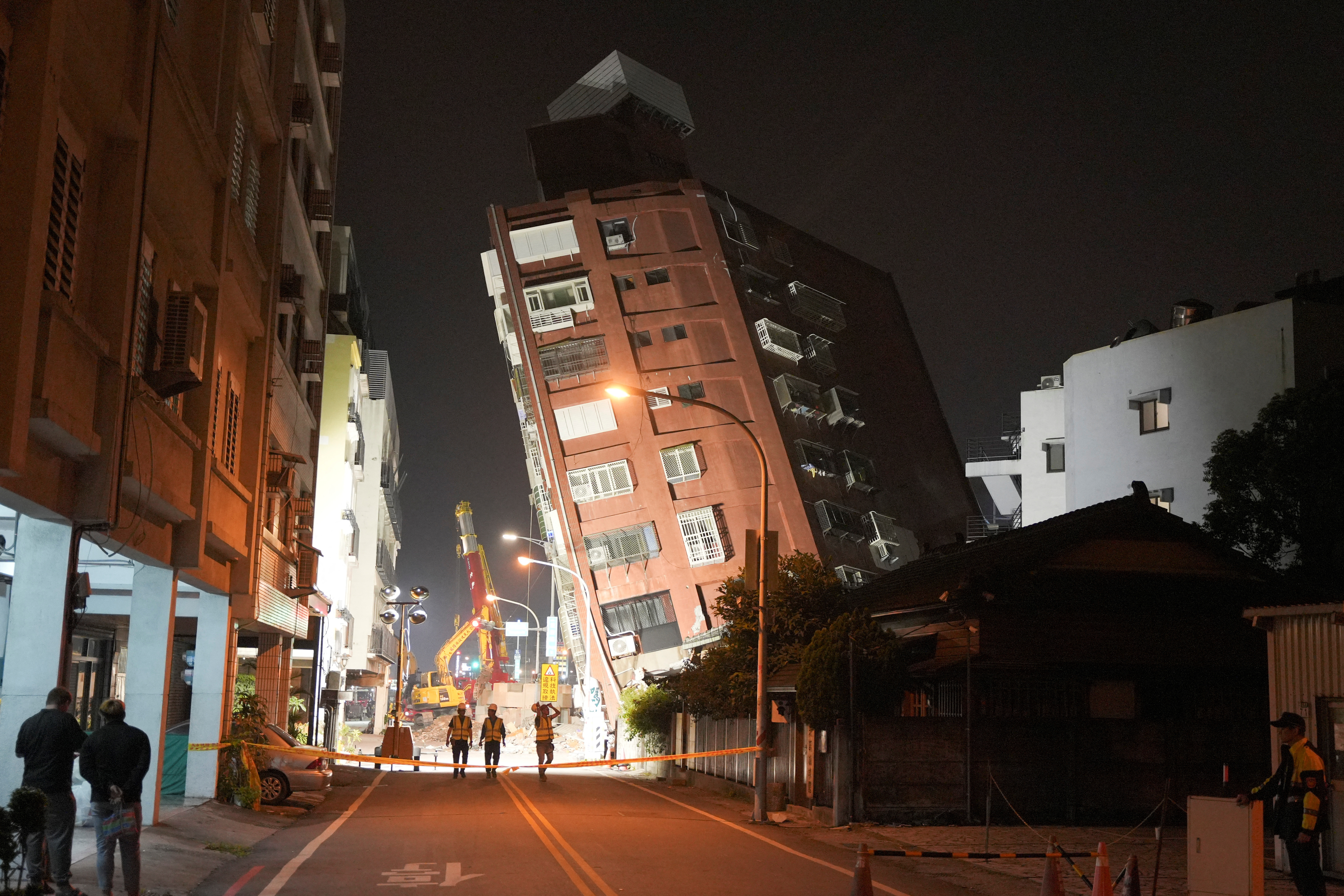
CHIP SUPPLIES

The Reuters Daily Briefing newsletter provides all the news you need to start your day. Sign up here.
Reporting by Yimou Lee and Fabian Hamacher, Shanghai and Hong Kong newsrooms; Writing by Ben Blanchard; Editing by Clarence Fernandez, Chizu Nomiyama, Alison Williams and Josie Kao
Our Standards: The Thomson Reuters Trust Principles. , opens new tab

Thomson Reuters
Yimou Lee is a Senior Correspondent for Reuters covering everything from Taiwan, including sensitive Taiwan-China relations, China's military aggression and Taiwan's key role as a global semiconductor powerhouse. A three-time SOPA award winner, his reporting from Hong Kong, China, Myanmar and Taiwan over the past decade includes Myanmar's crackdown on Rohingya Muslims, Hong Kong protests and Taiwan's battle against China's multifront campaigns to absorb the island.
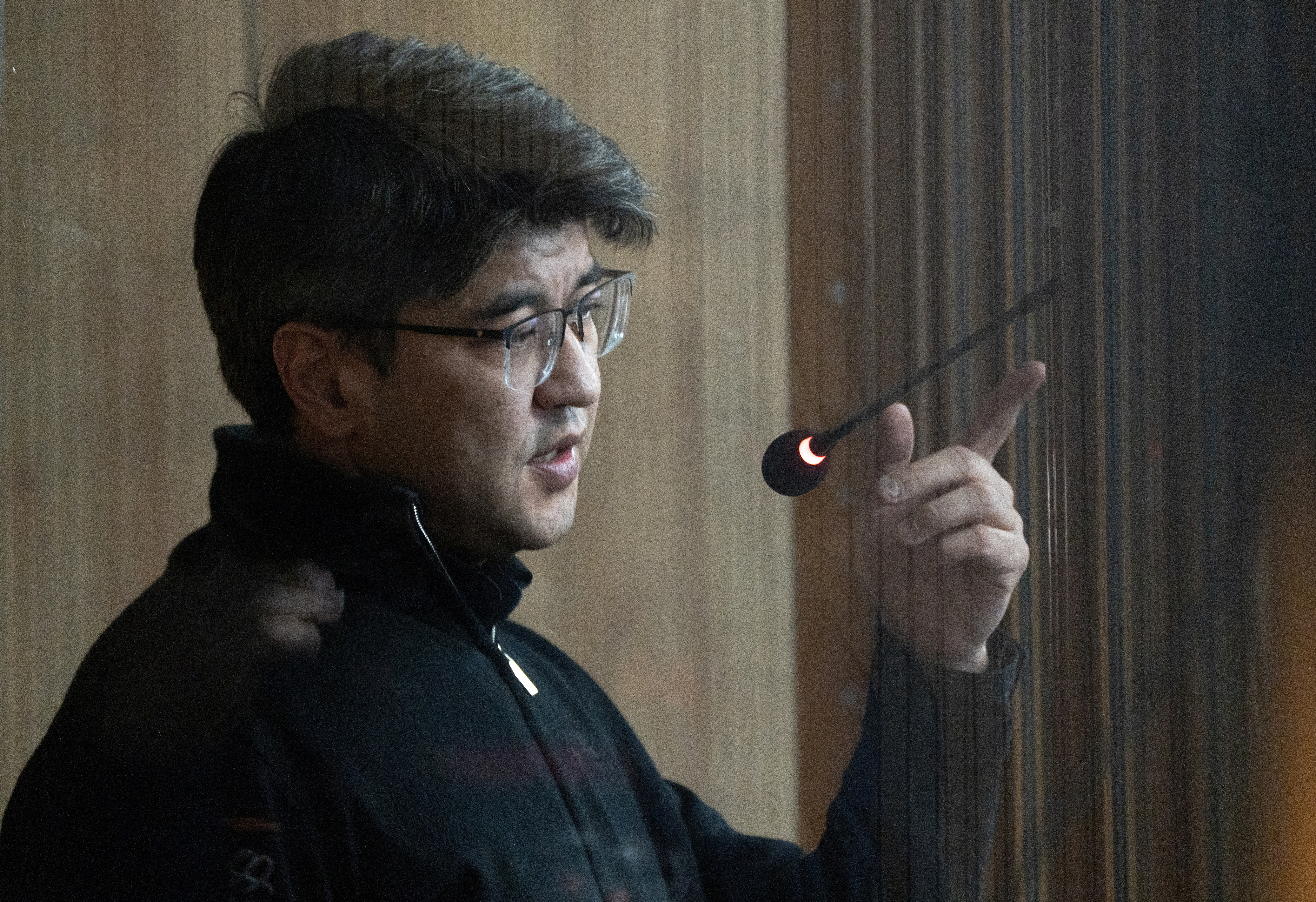
Texas woman who measures her life in eclipses about to see her 21st
Leticia Ferrer is an "umbraphile" - literally, a shadow lover - but what it really means is that she is a chaser of eclipses.

An earthquake of 6.0 magnitude struck Tonga Islands on Saturday, the German Research Center for Geosciences (GFZ)said.


IMAGES
VIDEO
COMMENTS
It generally looks like this and usually involves a wake-up call between 5 am - 7 am each day: Day One: Transport from Santa Marta + 3-5 hours hiking + night on trail. Day Two: 7-9 hours hiking + night on trail. Day Three: 1-2 hours hiking + Lost City site visit + 6-8 hours hiking + night on trail.
Discover Lost City, Cabo de la Vela, Punta Gallinas, Tayrona Park & more. Book Now! ... The Lost City Trek. Find a Tour by. Tour Type. Beach . Culture . Hiking . Mountain . Transfer . Walking . Wildlife . ... We are Magic Tour Colombia, a local company with more than 16 years of experience. We have one of the best groups of local guides to ...
The Lost City trek, also known as the Ciudad Perdida trek, is a guided tour operated by TEYUNA TOURS, a travel agency based in Santa Marta, Colombia. The trek takes between 3 and 6 days to complete and involves walking through the tropical forest of Sierra Nevada de Santa Marta, crossing rivers, navigating uphills and downhills, and exploring ...
The Lost City Trek is expensive. The 4-day Lost City trek costs 2.150.000 COP per person in 2024. That's an increase from 1.750.000 COP per person in 2023 - nearly $100 USD more. Yes, you read that correctly! It's one of the most expensive activities to do in all of South America.
The 4-Day Trek option includes 2.5 days of trekking to get to the Lost City and 1.5 days to get back. Day 1: Santa Marta to El Mamey town to Adán Camp (Distance: 12.5 km) Day 2: Adán Camp to Paraiso Teyuna Camp via Mumake Camp (Distance: 23.5km) Day 3: Paraiso Teyuna Camp to Mumake Camp via The Lost City (Distance: 22.2km)
Hike from Camp 1 to Camp 3. 7 hours trekking (approx. 14.7km) Day 3: Camp 3 to Lost City to Camp 2. Ascend 1,200 stairs up to Lost City. Spend around 3 hours at the Lost City. 4 hours trekking (approx. 6km - this doesn't include walking around the Lost City) Day 4: Camp 2 to Camp 1. Hike from Camp 2 to Camp 1.
The Ciudad Perdida hike takes you through the jungle to visit the abandoned city known locally as 'Teyuna'. It is believed that the city was founded in 800 CE (FYI that's 650 years before Machu Picchu). The Lost City was 'rediscovered' in 1972 by a father and son who began to loot the site.
The Ciudad Perdida (Lost City) is a challenging and rewarding trek in Colombia. This guide answers all your questions about the Ciudad Perdida trek, including itinerary, costs, tour companies to choose, what to expect, what to pack, and much more.
So let's see what the Lost City Trek looks like. It departs from your agency's office in Santa Marta and starts with a 2-hour drive to a small town called Machete. It is a 4-day trek, from Machete to the Ciudad Perdida. You will be using the same path to go and come back, and each way is about 22 km / 14 miles long.
The Lost City trek can be completed in 4, 5 or 6 days. The price is exactly the same in any case. The way to the Lost City is the same for everyone, on day 3 you reach the Lost City, and the difference is on the way back. Those who plan to stay for 5 or 6 days will sleep one or two more nights on their way back, so as to walk less distance each ...
43,612 reviews. 3 trips to Ciudad Perdida (The Lost City) Type : Global Operator. Service level : standard. Trip Style: Group Tours, Small Ship & Expedition Cruises, River Cruises, Independent / Self-Guided Packages. Age Range: families, 18-35, 35-55, 55+. What they're known for.
The Lost City is the best opportunity to connect with nature and prove yourself everything you are capable of. Doing the Lost City Trek will allow you to know part of the Sierra Nevada de Santa Marta in Colombia. You will also have the opportunity to have direct contact with the Kogui; who still preserve the traditions of the Tayronas, the ...
The Lost City trek is an arduous but rewarding 4 to 5-day traverse through the Sierra Nevada de Santa Marta in northern Colombia. The trek offers a unique opportunity to connect with nature, to see the ancient ruins of a Pre-Columbian society, as well as to cross through the land of the Kogi tribes. These indigenous people live in traditional ...
The Lost City Trek in Colombia is an exhilarating 4 to 5-day adventure through the Sierra Nevada de Santa Marta, leading you to the ancient ruins of an indigenous city—called Teyuna.. It's all about cultural immersion, breathtaking scenery, and a real physical challenge.You'll need to be prepared for a demanding environment (humid climate, insects), long hiking hours, and shared ...
Day 1 of the Lost City Trek. Start/Finish: Machete (El Mamey) to Adán or Ricardito Camp (Campsite #1) Distance: 7-8 km. All Lost City treks, no matter which tour company you choose, seem to set off from Santa Marta in northern Colombia. From there, a jeep or van transfer takes 45 minutes along the highway.
We're Expotur, a socially responsible local company with over 15 years of expertise. As the only Authorized Tour Operator, we boast the inaugural generation of Professional Guides, leading the Lost city trek Colombia with daily departures from Santa Marta, Colombia.. In the mountains of Sierra Nevada de Santa Marta, declared Biosphere Reserve by UNESCO in 1979, bordering the Caribbean Sea on ...
The Lost City trek itself is challenging, rewarding, (sweaty!) and just incredible. The scenery is breathtaking: there are endless mountain views, rivers, waterfalls and the stunning landscapes of the Sierra Nevada de Santa Marta. ... Big worldwide tour companies offer treks to The Lost City but anyone charging more than $350 is just making a ...
Guiding: You can only do the trek with a guiding company (remember: you are an invited guest into sacred tribal lands). Climate: This is a hot and humid trek through tropical jungle, with all that it entails. ... /05/Adventure-Alan-Co-Logo.png Alan Dixon 2017-01-11 19:02:55 2020-01-15 19:10:31 Guide to Colombia's La Ciudad Perdida Trek (Lost ...
It is not possible to do the Lost City Trek without a guide, you have to join one of the Ciudad Perdida tours which leave from Santa Marta or Palomino. As of April 2023, the Ciudad Perdida Trek price is $1.750.000 COP (Colombian pesos) per person, which is approximately $400 USD. Several different tour companies have permits to lead the Lost ...
2:11. Thieves stole as much as $30 million from a money storage facility in Los Angeles on Easter Sunday in one of the biggest cash heists in the city's history, the Los Angeles Times reported ...
Moscow city subway terrorist acts; Top Day Trips from Moscow The bridge over Zolotoy Rog Bay in Vladivostok. The views of St. Petersburg from the TV tower >> 2 comments. Tomás · August 27, 2012 at 11:34 pm. The Moscow metro stations are the best That I know, cars do not. Reply.
City status since: 1938: Government • Head: ... Major companies include: Elektrostal metallurgical factory; Elektrostal chemical-mechanical factory; Elektrostal Heavy Engineering Works, JSC is a designer and manufacturer of equipment for producing seamless hot-rolled, cold-rolled and welded steel materials and metallurgical equipment. ...
EV startup Canoo paid $1.7 million for CEO Tony Aquila's private jet bills, twice its total revenue last year. According to its earnings report released this week, Canoo lost $302 million in 2023.
According to the Los Angeles Times, previously the largest cash heist in the city happened on September 12, 1997, when $18.9 million was stolen from the former site of the Dunbar Armored Inc ...
Find company research, competitor information, contact details & financial data for STELS, OOO of Elektrostal, Moscow region. Get the latest business insights from Dun & Bradstreet.
With no effective propulsion, the 95,000-ton ship had become an unstoppable object, drifting toward one of the most heavily traveled bridges in Baltimore. The bridge collapsed in an instant after ...
Elektrostal is a city in Moscow Oblast, Russia, located 58 kilometers east of Moscow. Elektrostal has about 158,000 residents. Mapcarta, the open map.
Taiwan's biggest earthquake in at least 25 years killed nine people on Wednesday and injured more than 900, while 50 workers travelling in minibuses to a hotel in a national park were missing.
The Israeli airstrike that killed seven workers delivering food in Gaza has touched off global outrage and condemnation. Kim Severson, who covers food culture for The Times, discusses the World ...